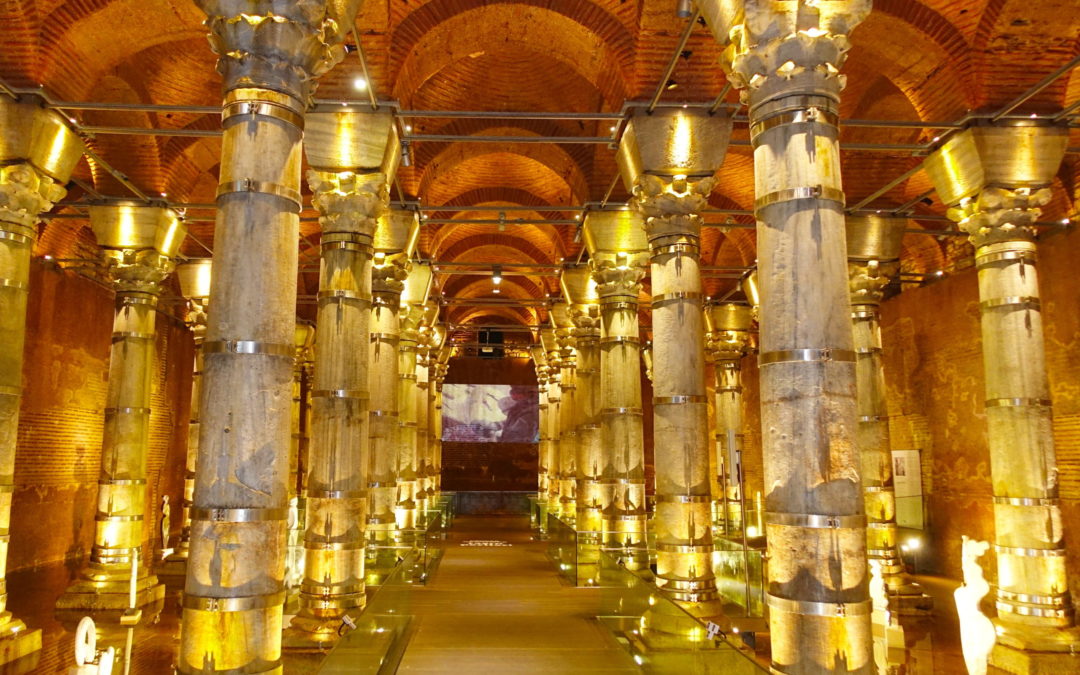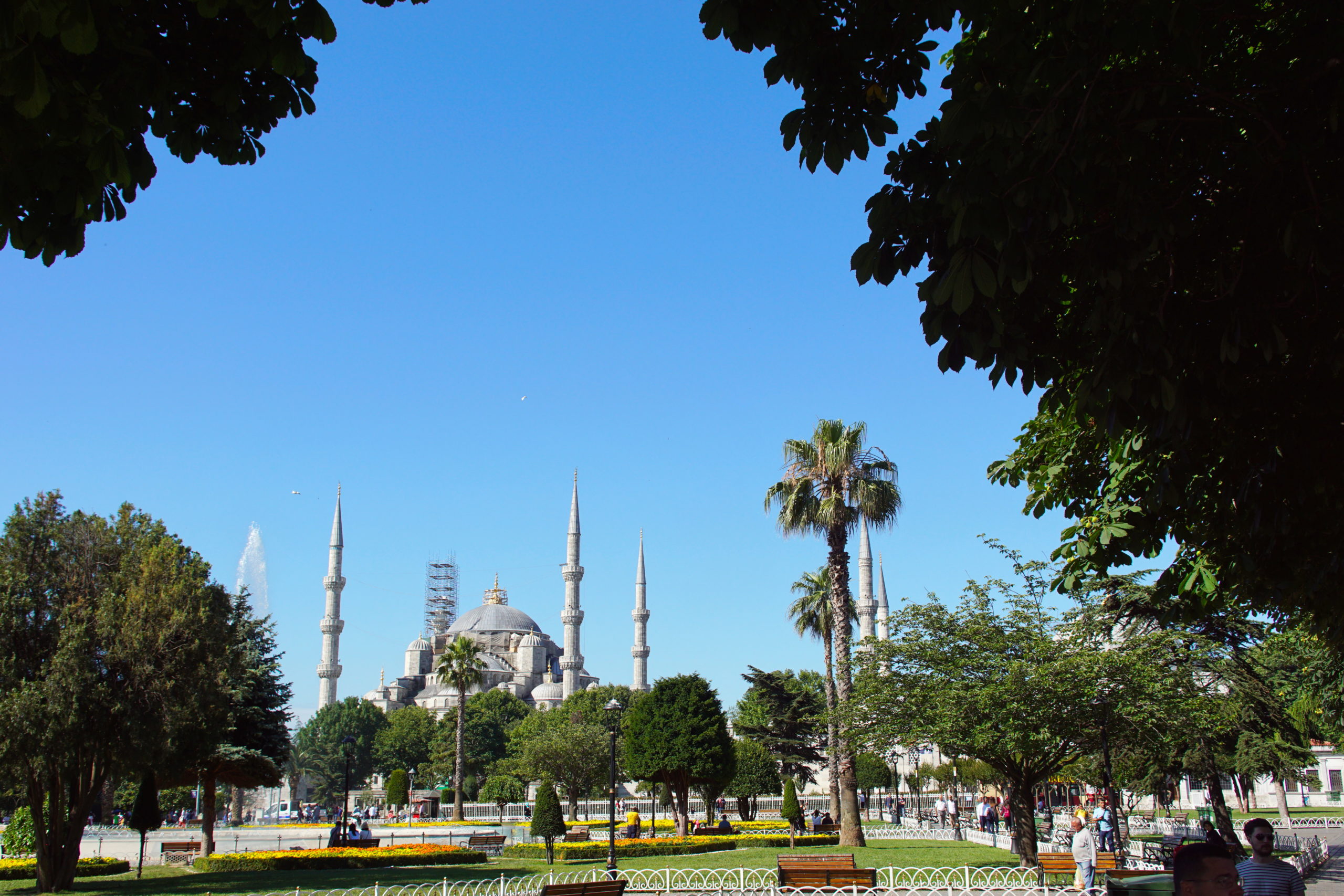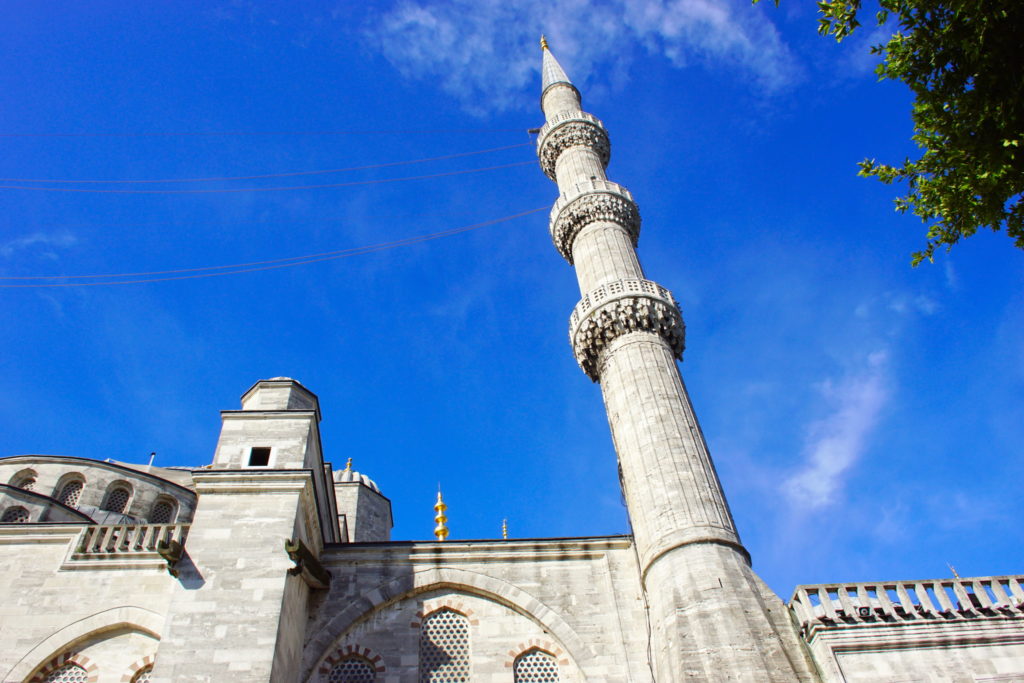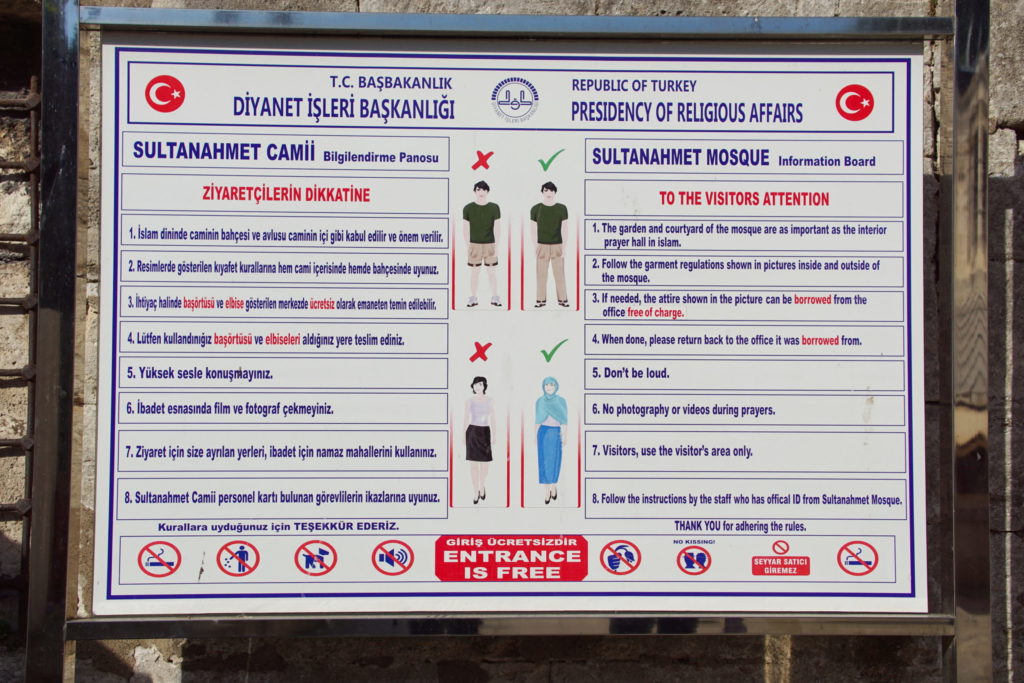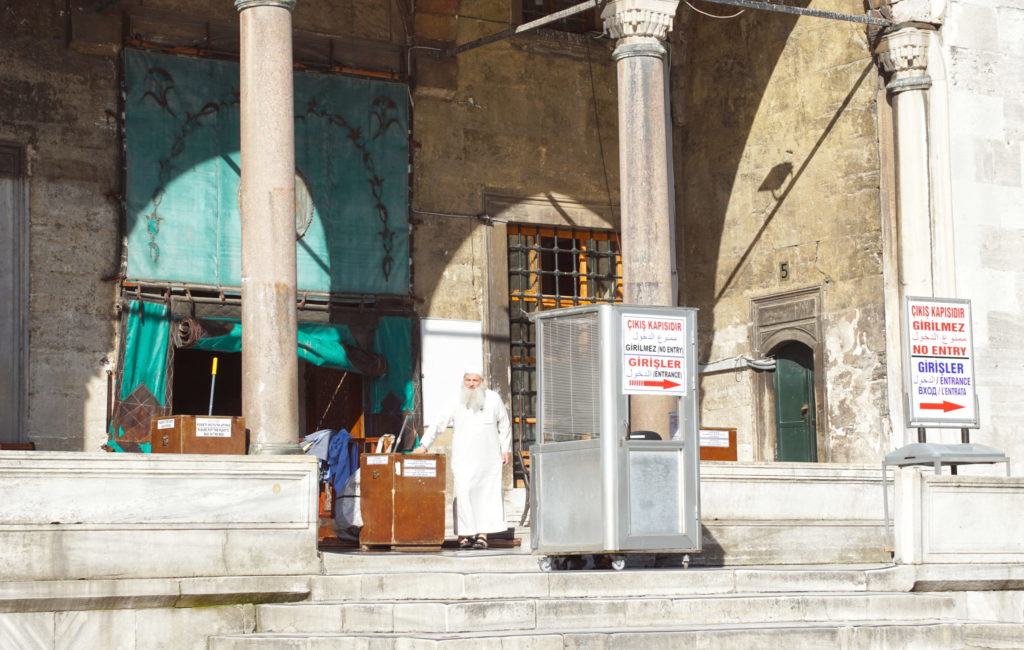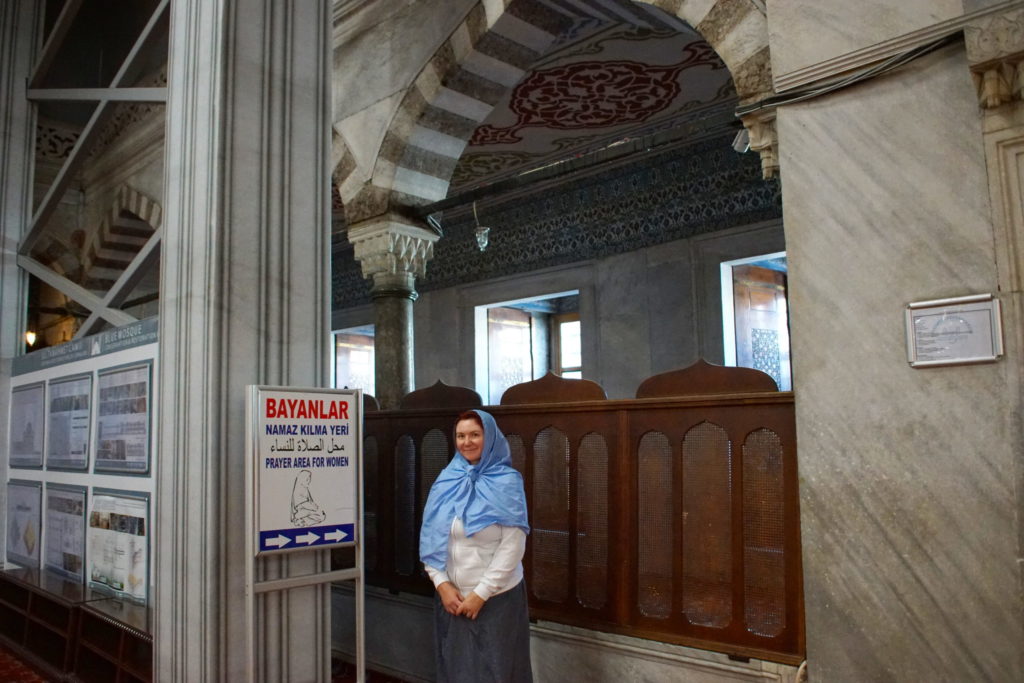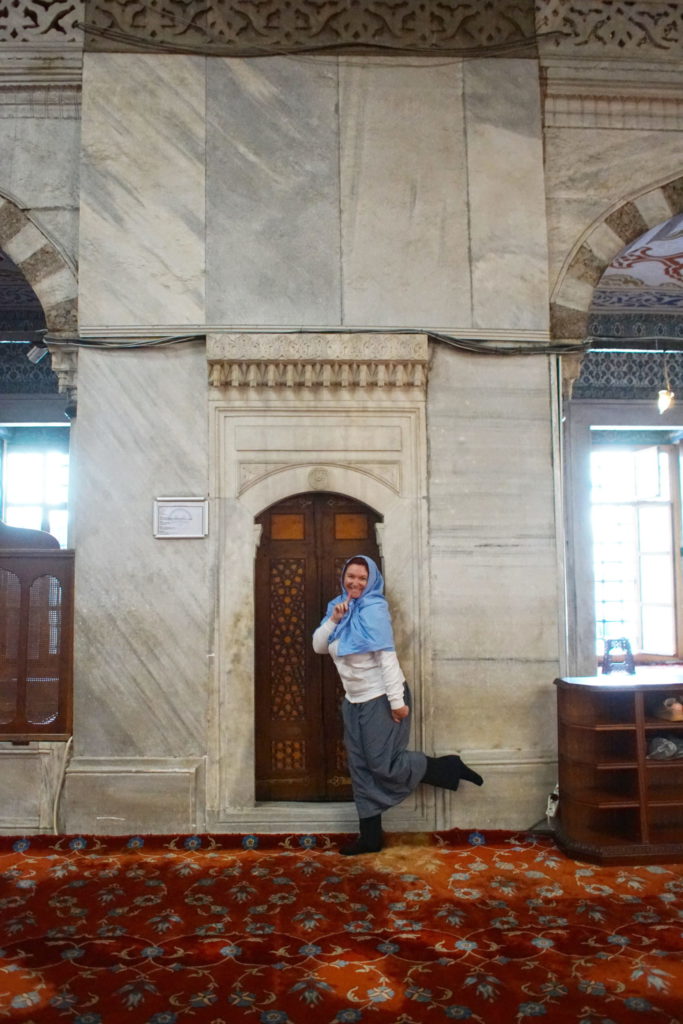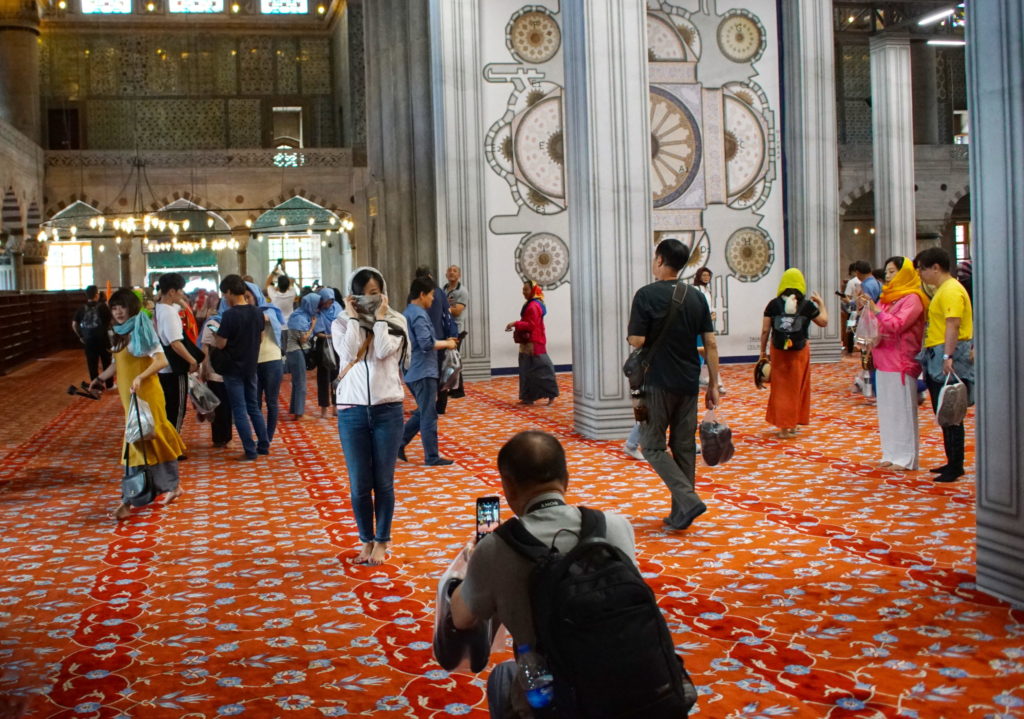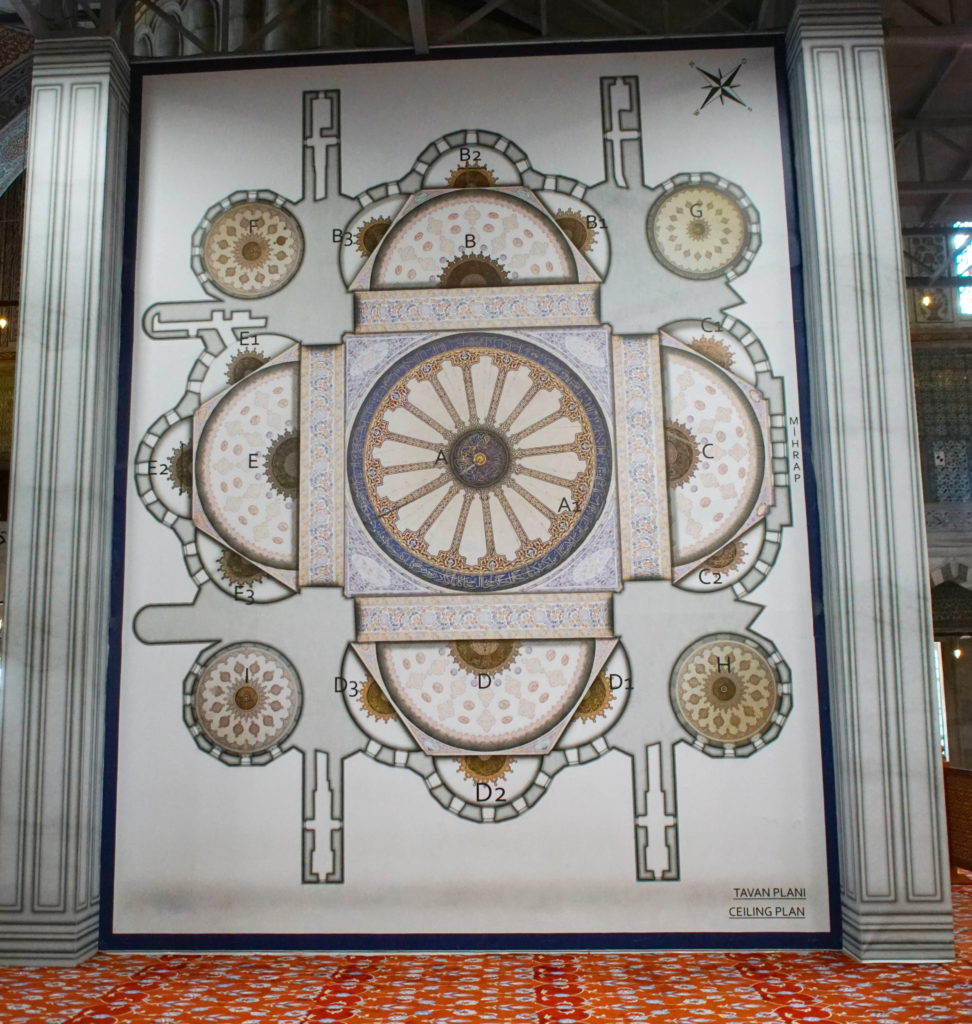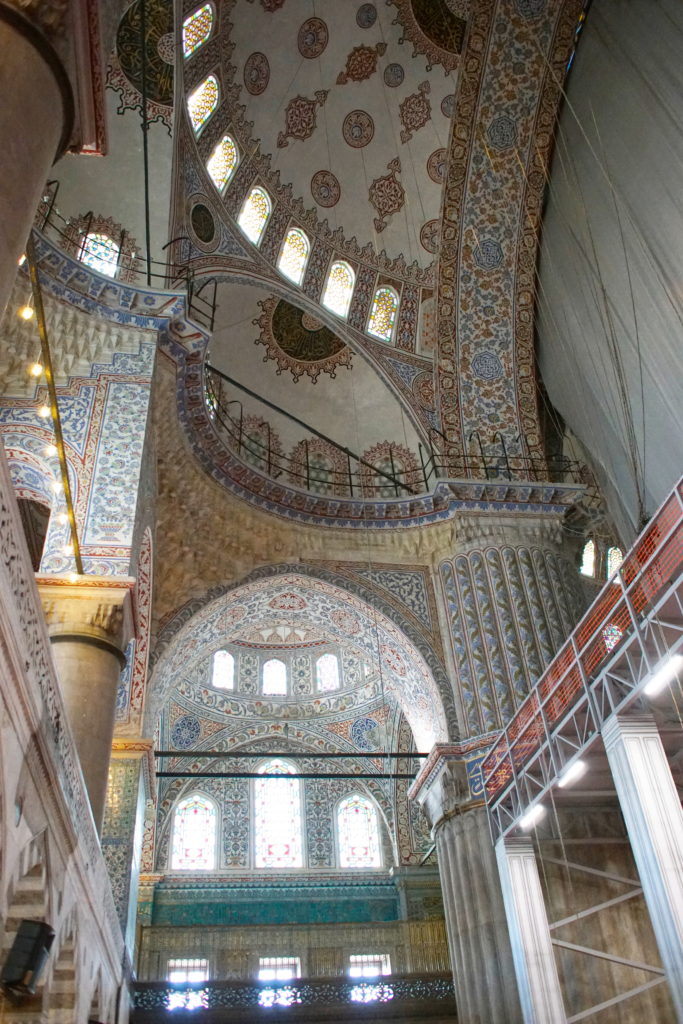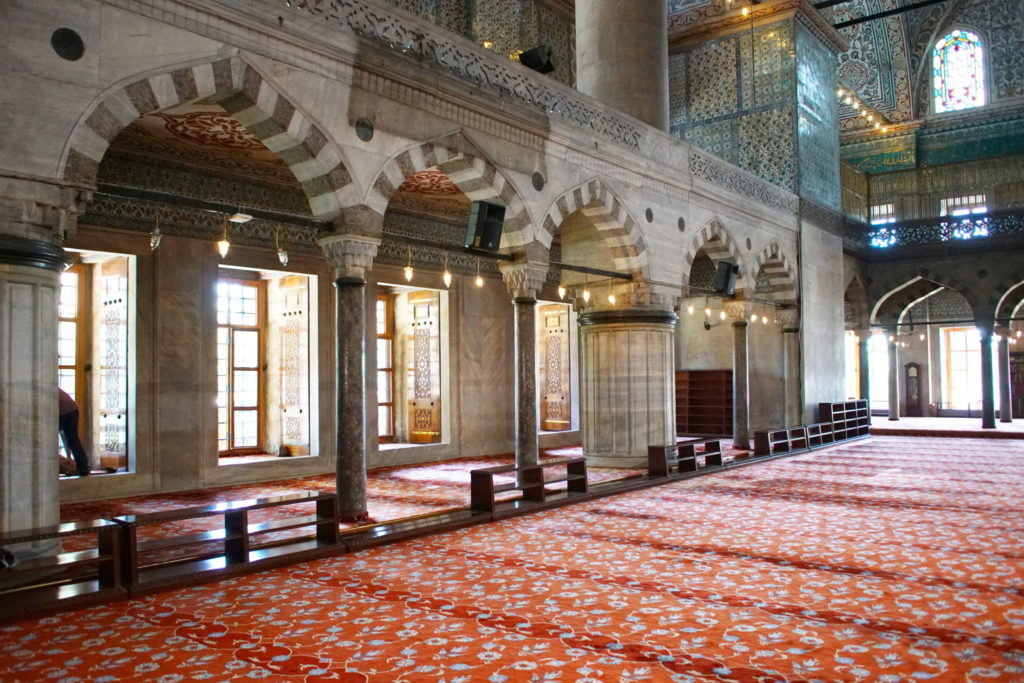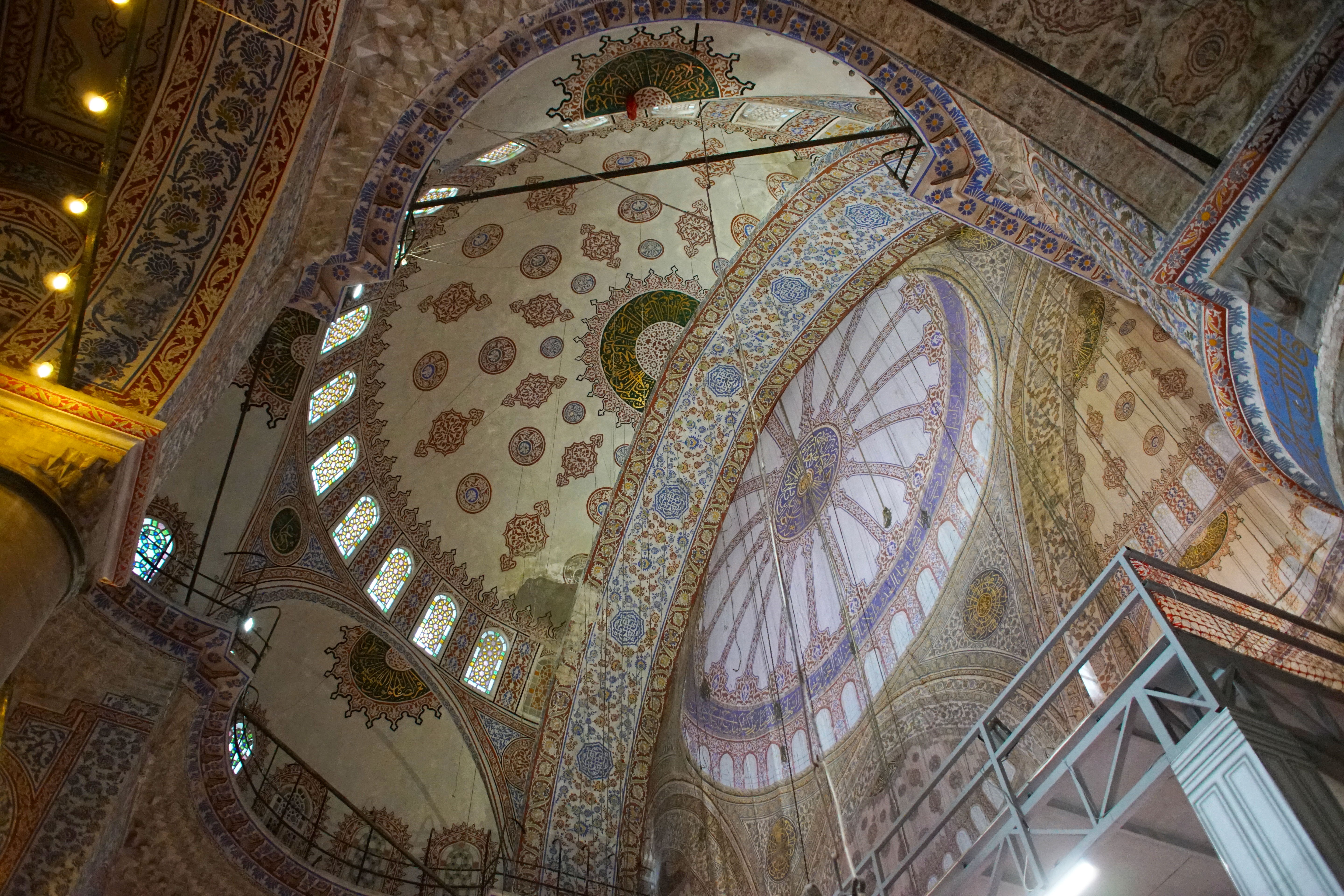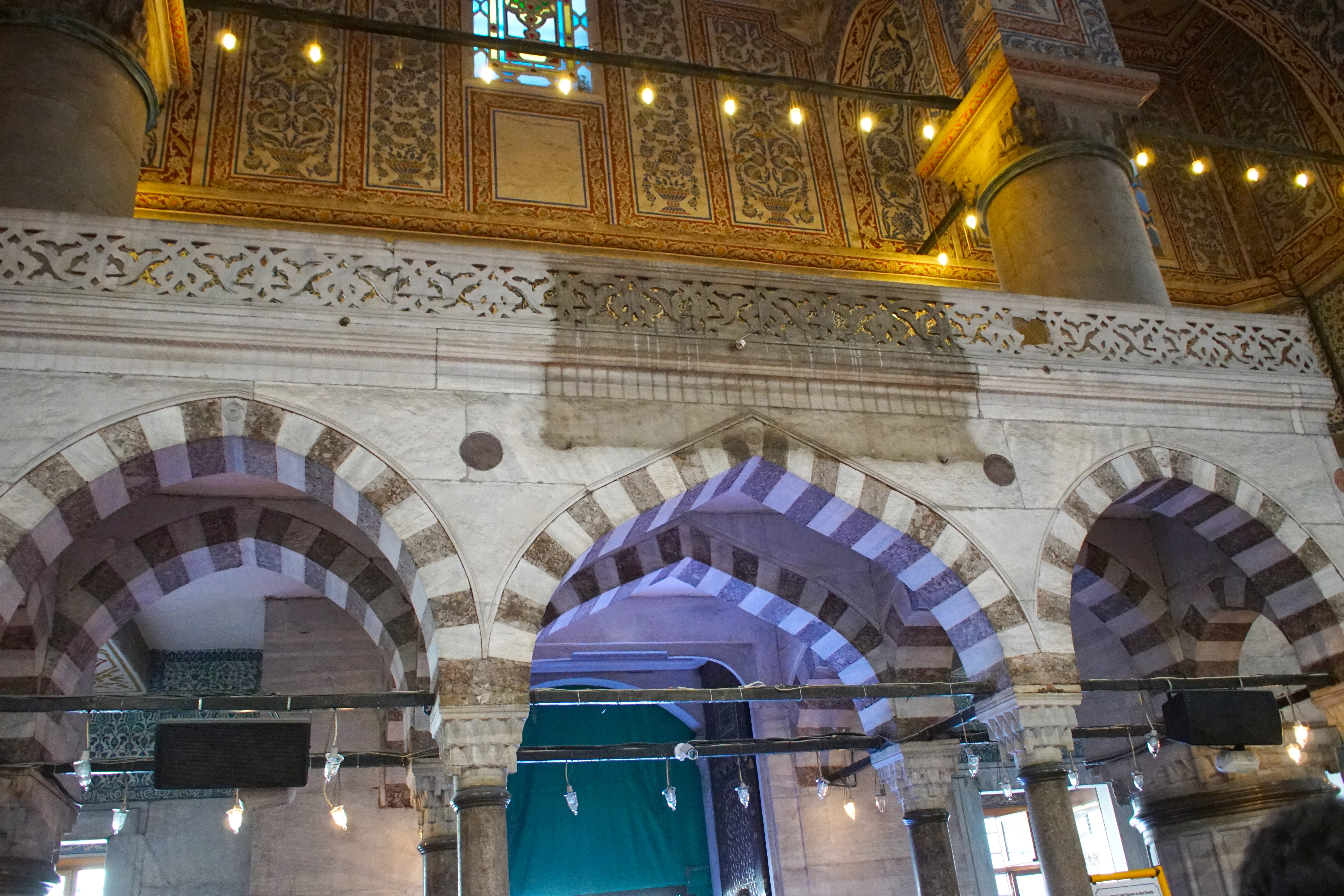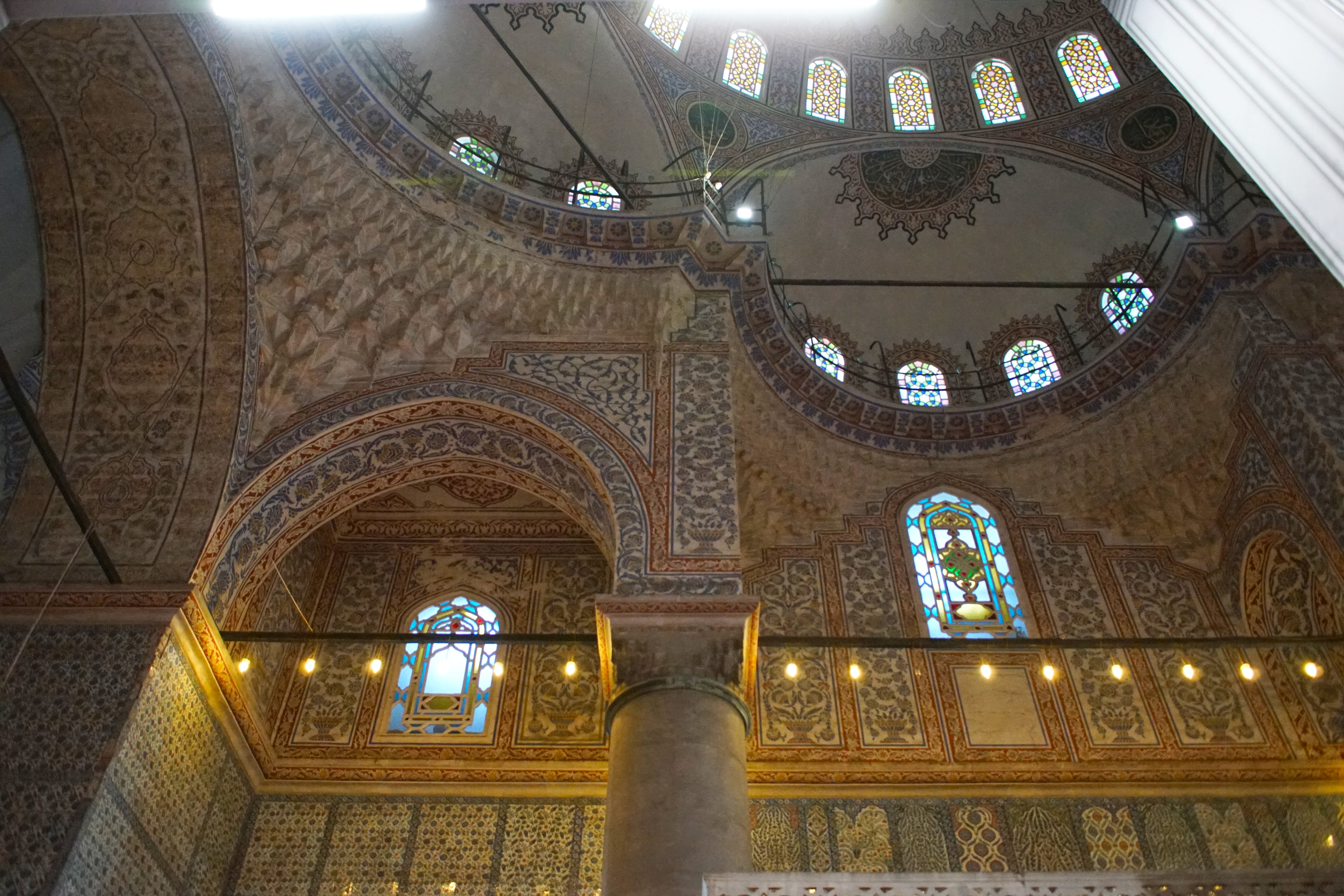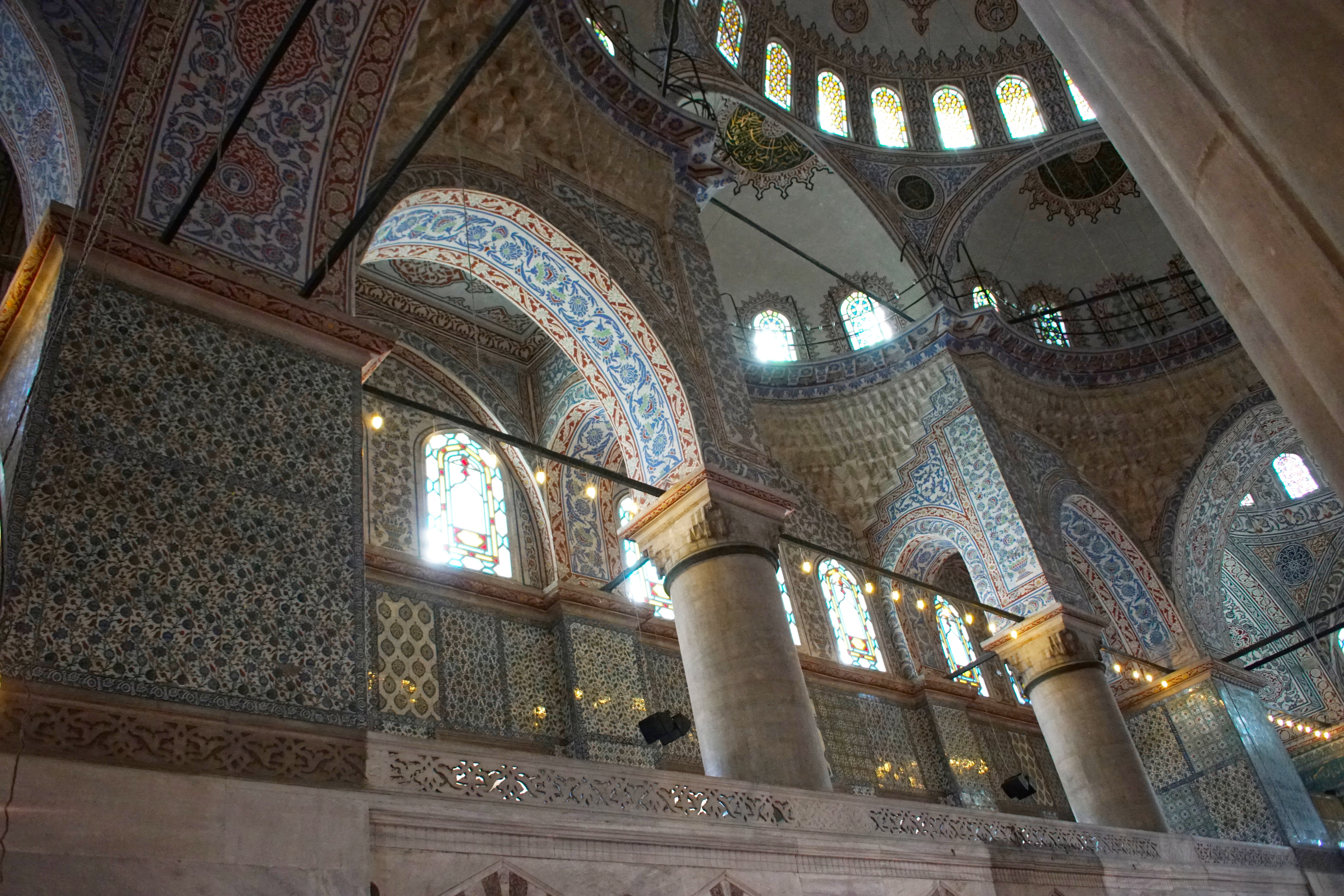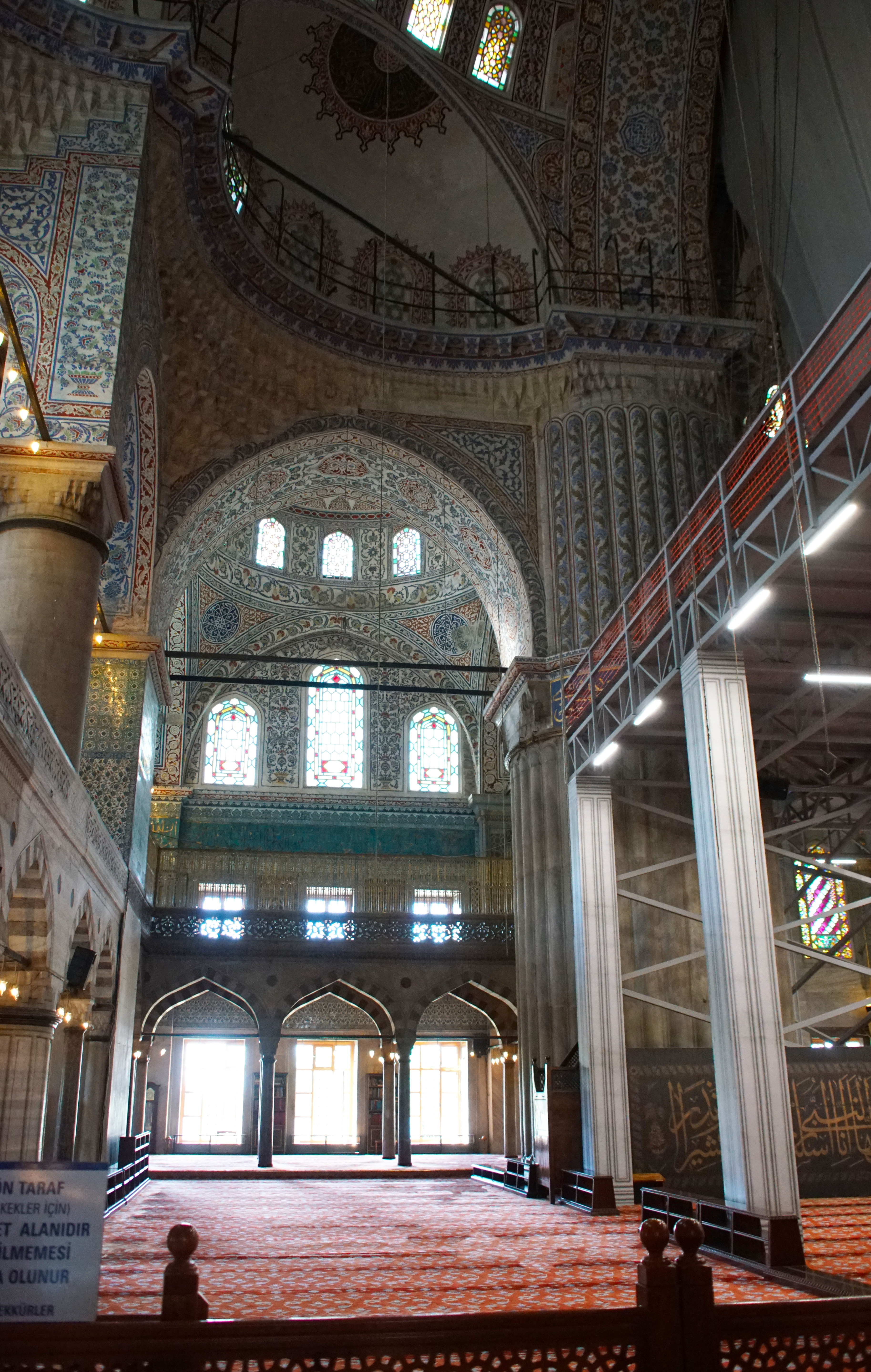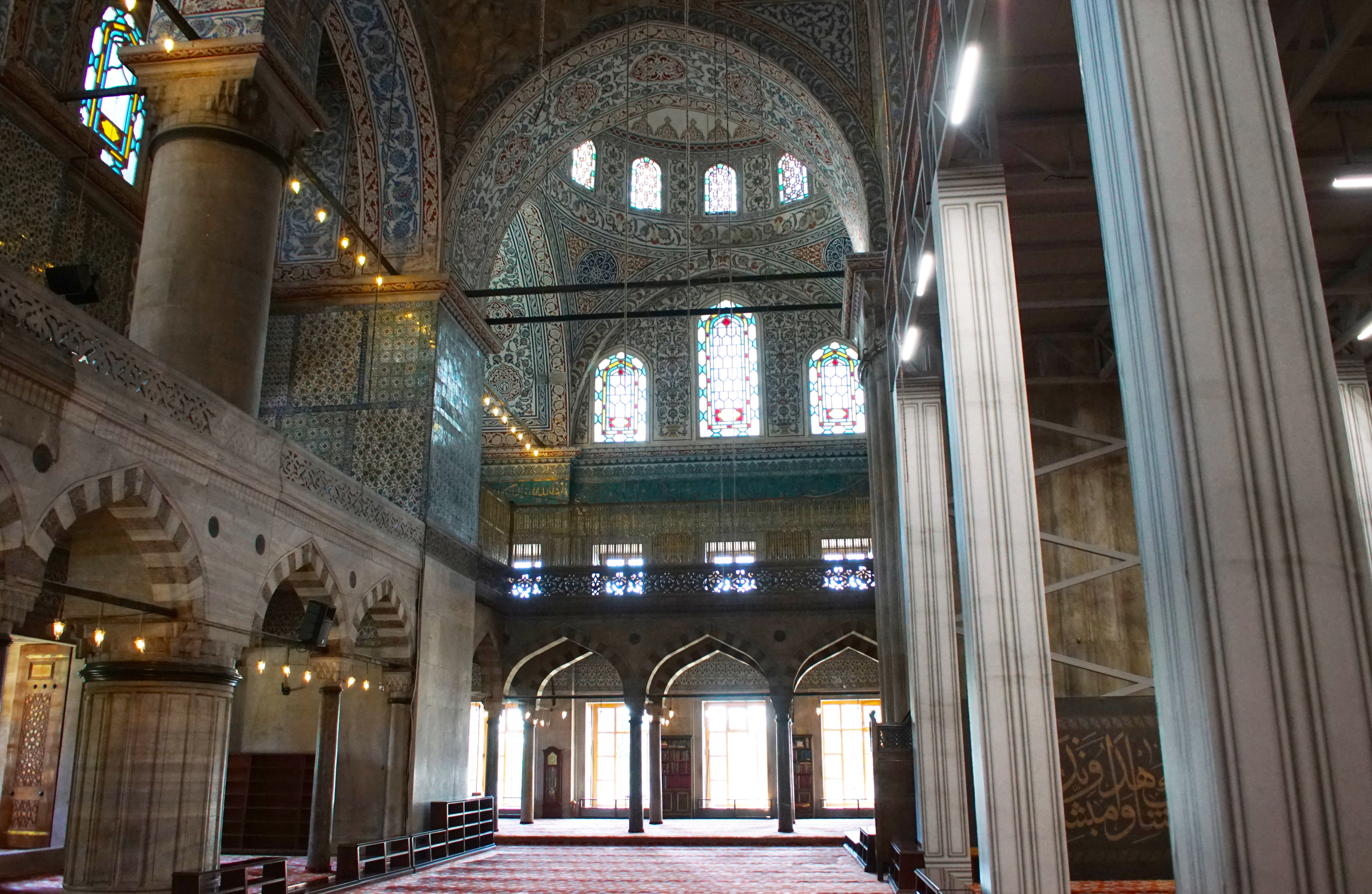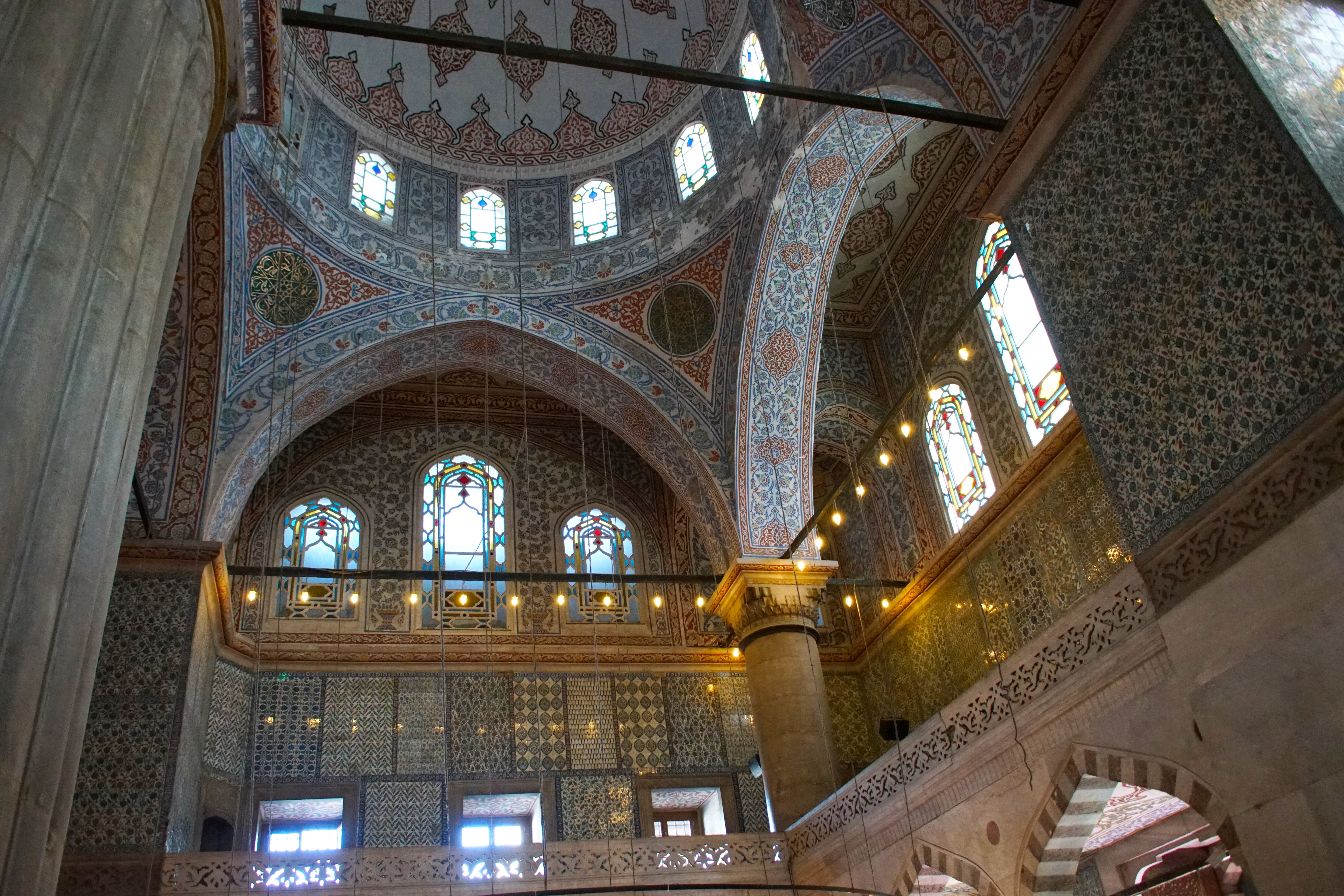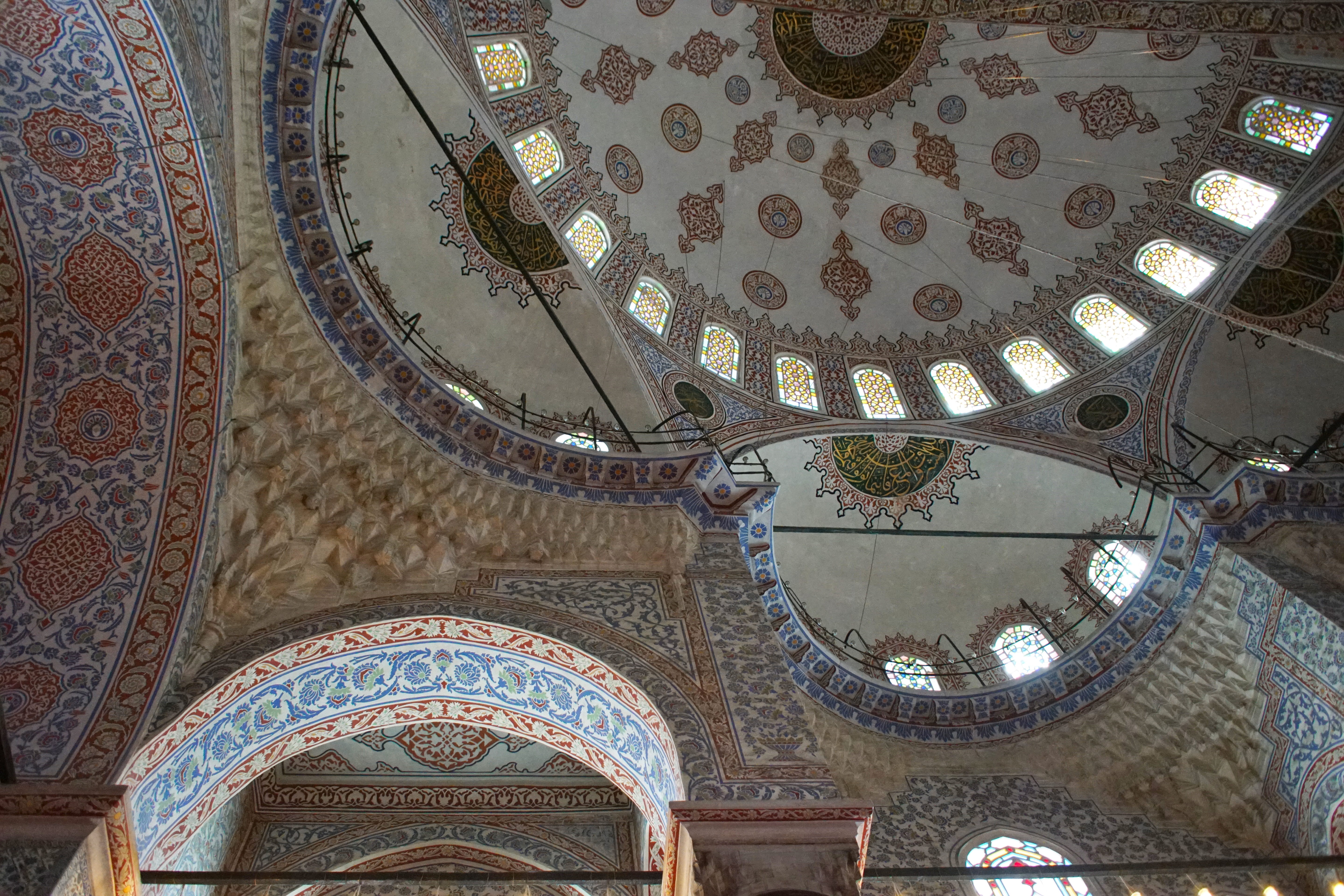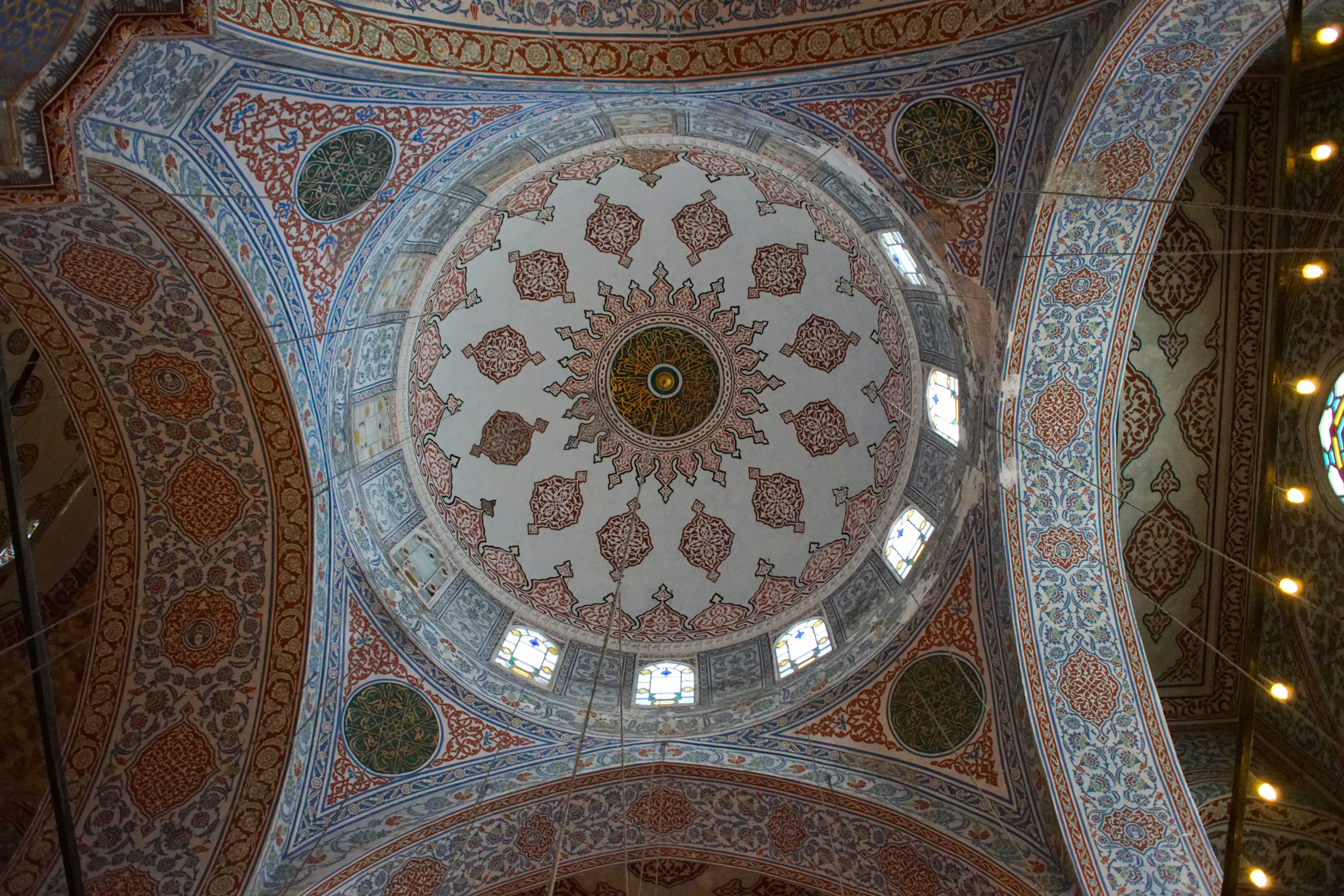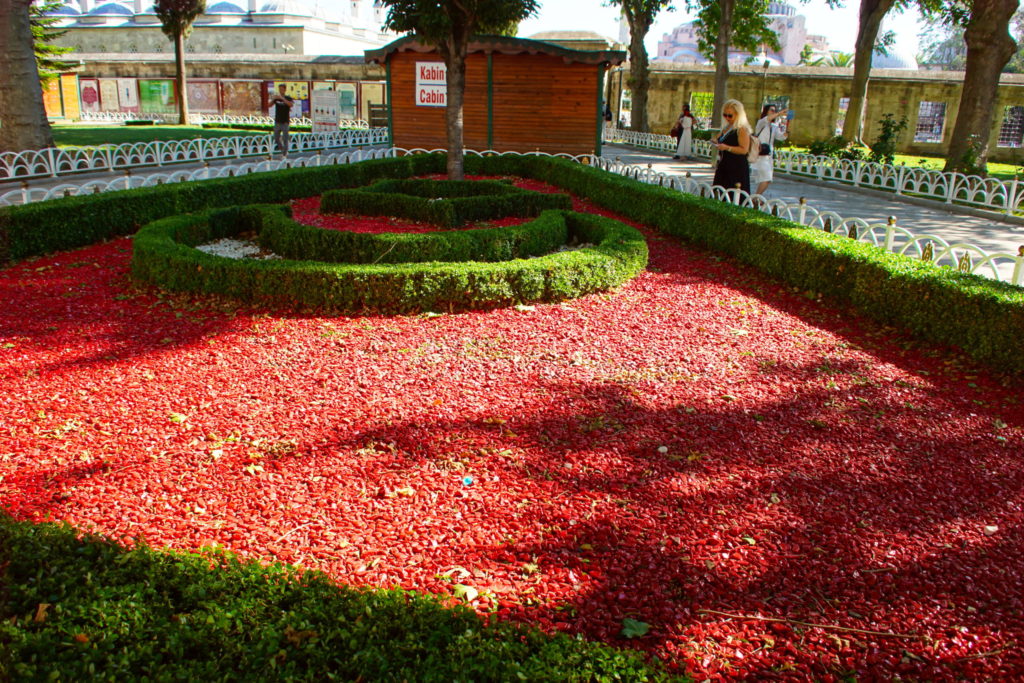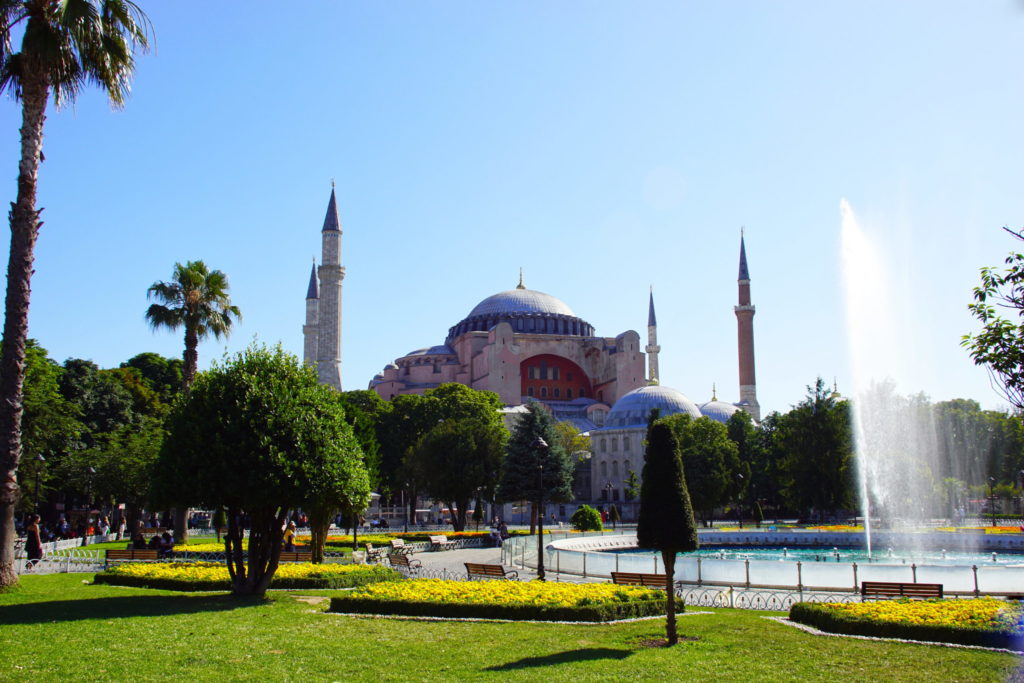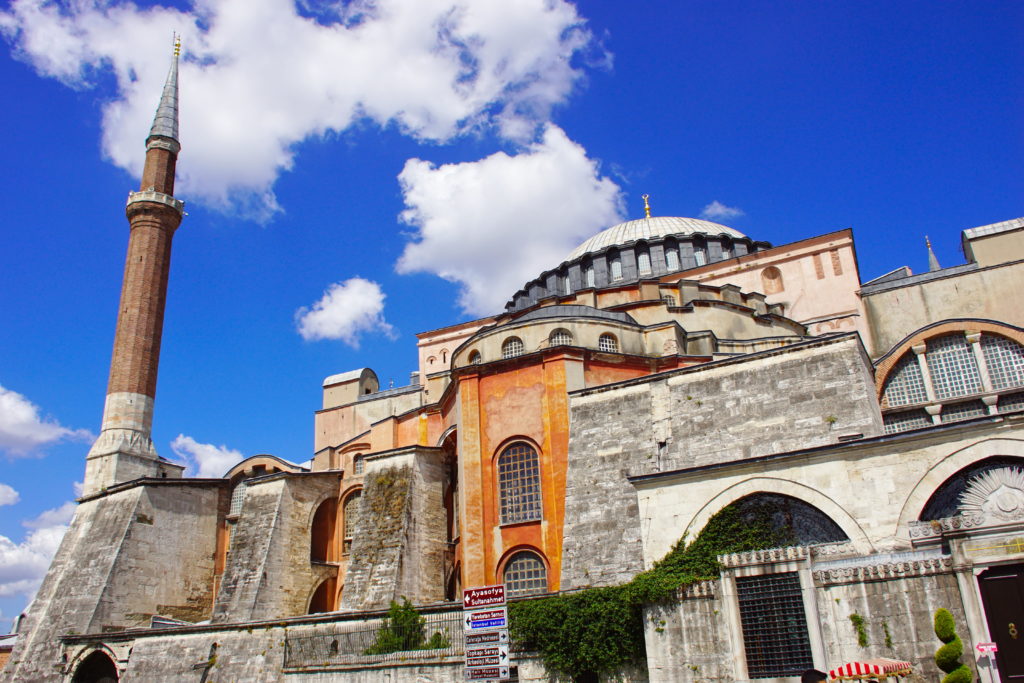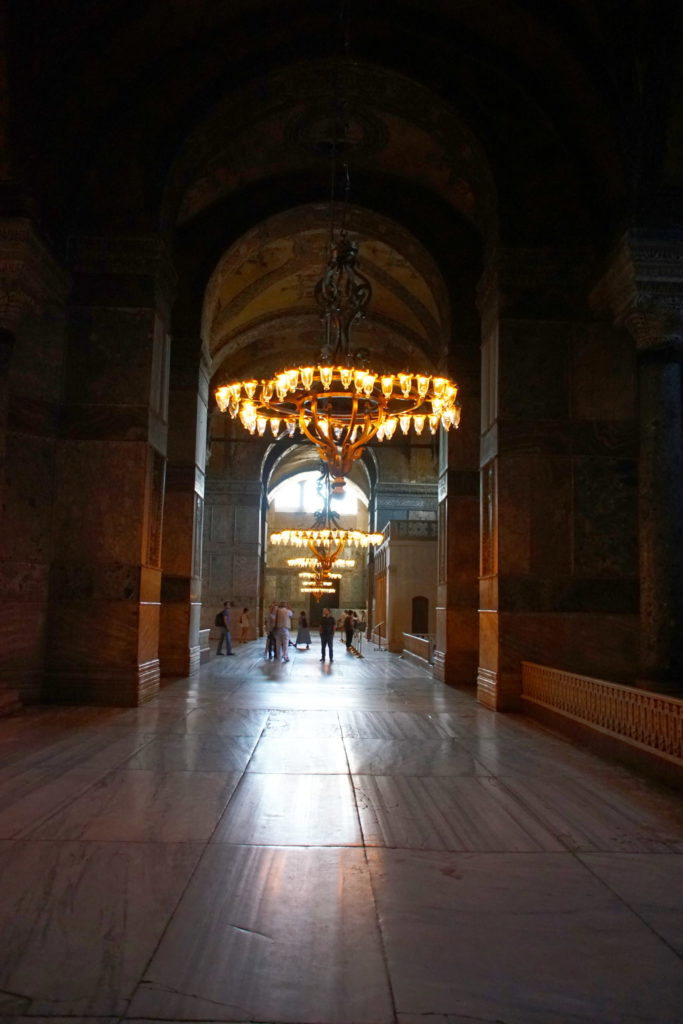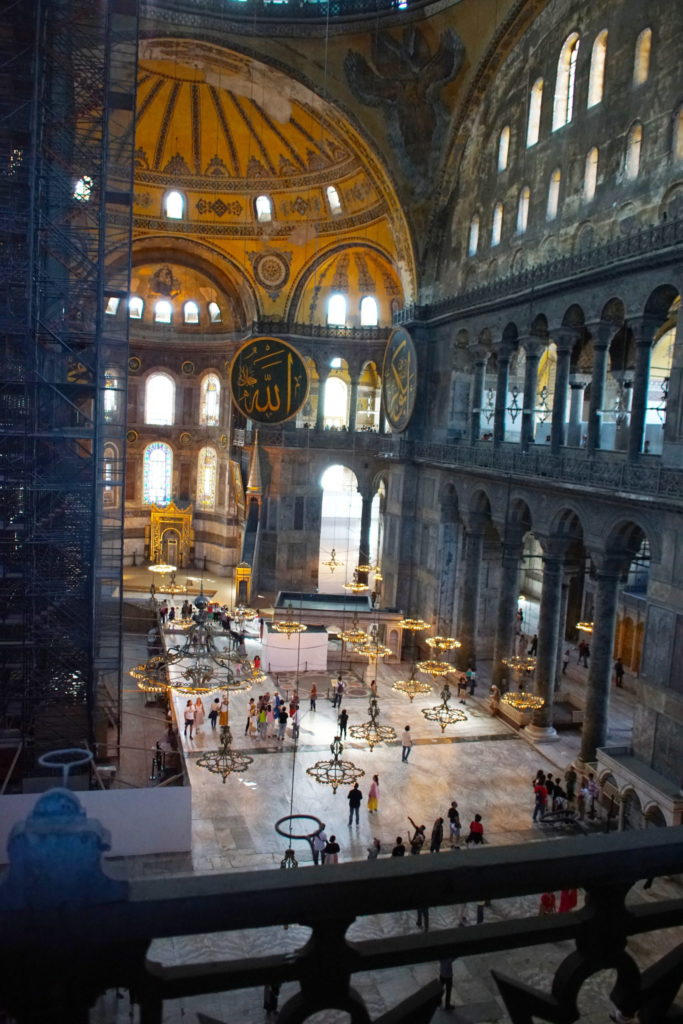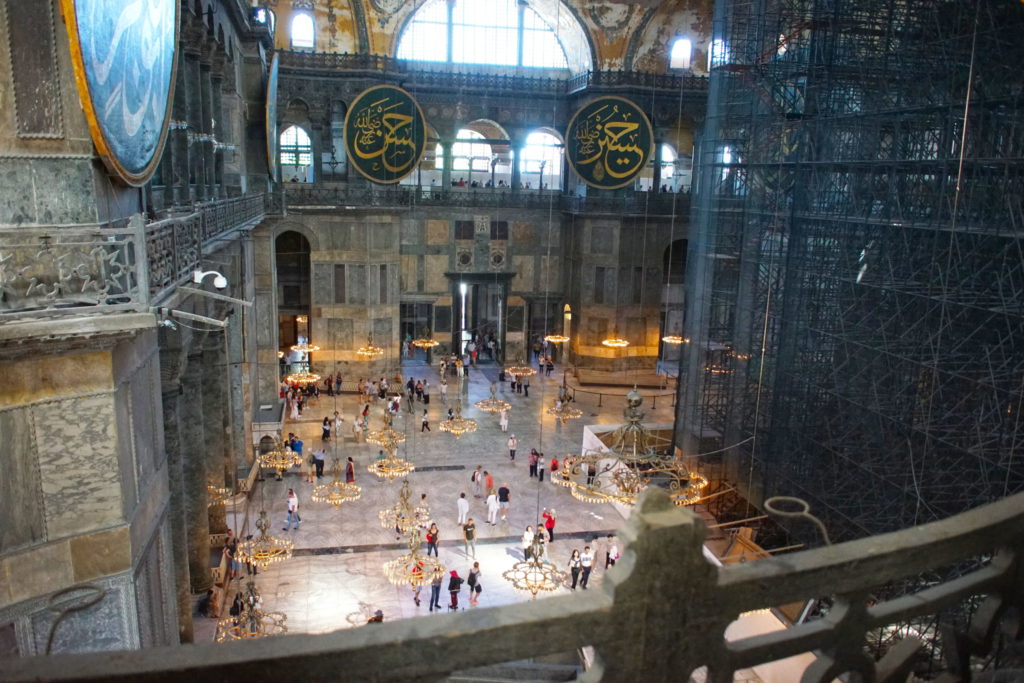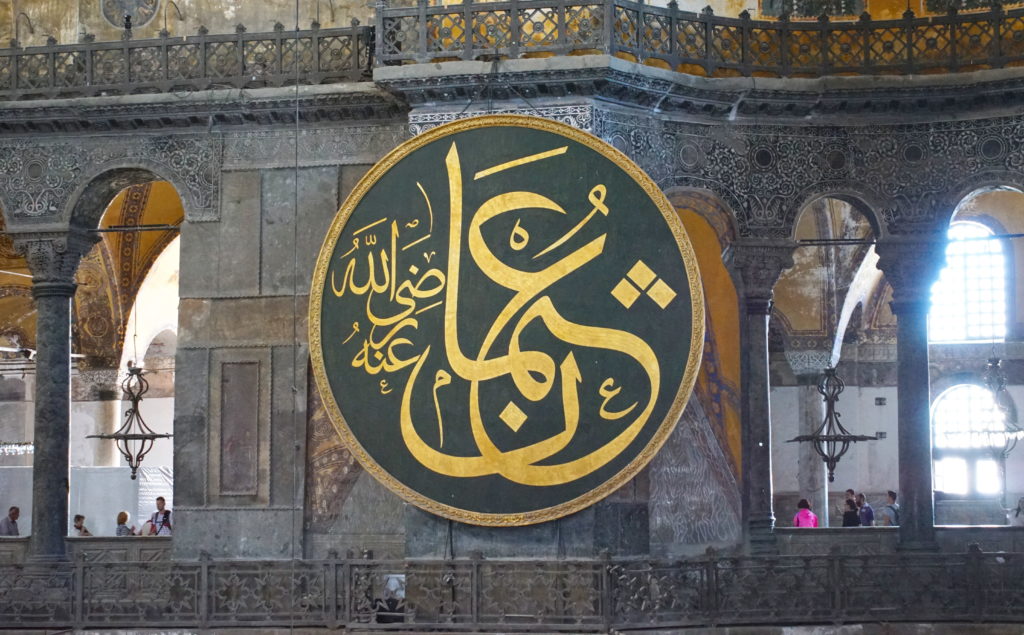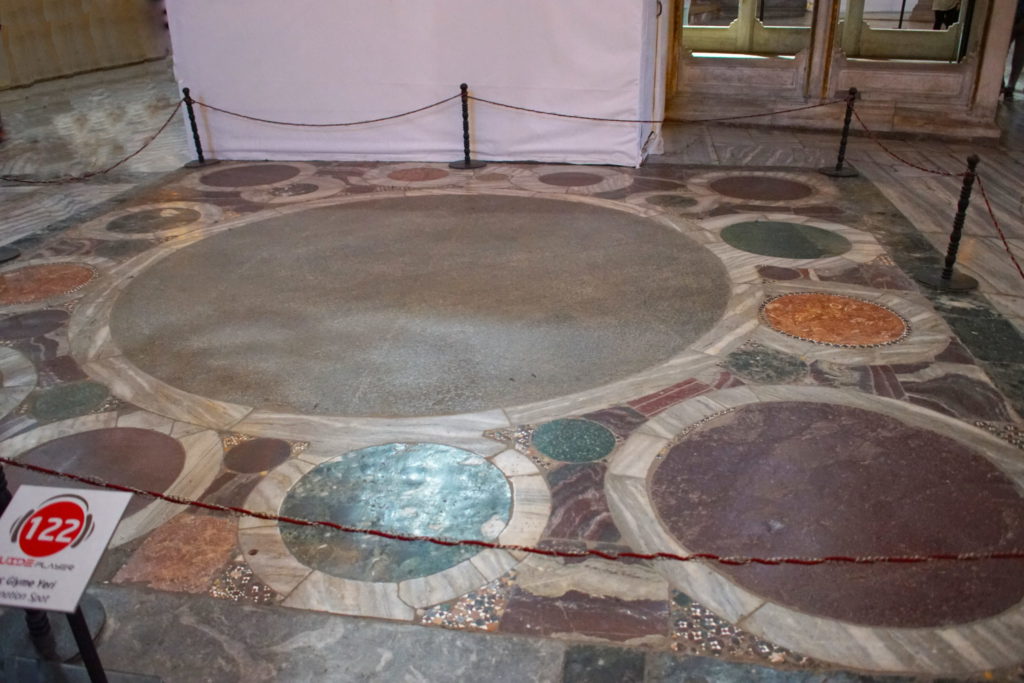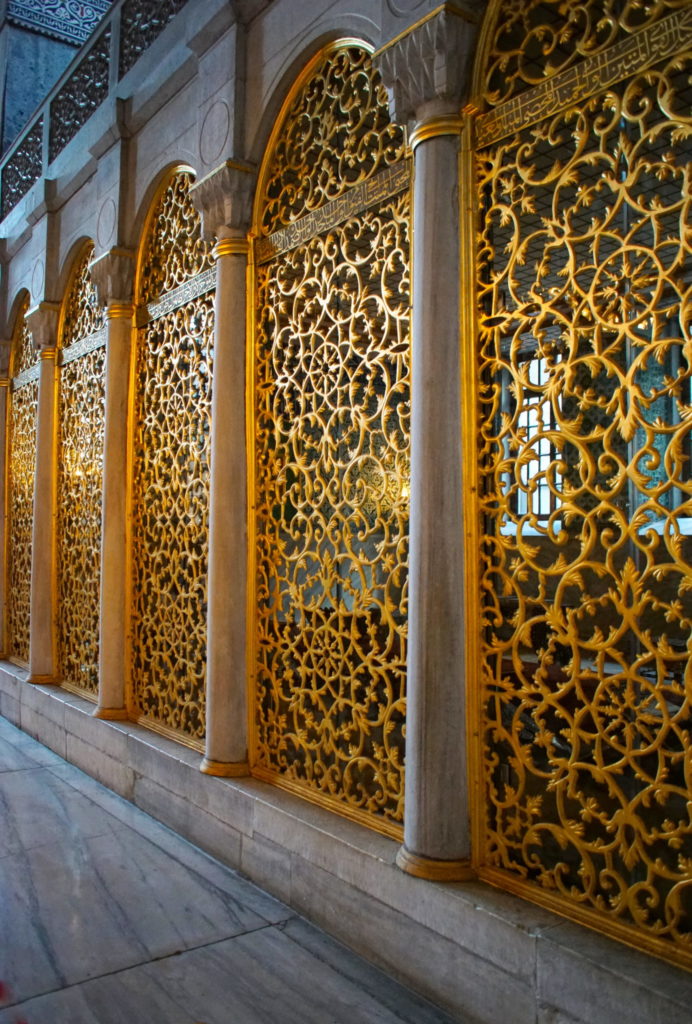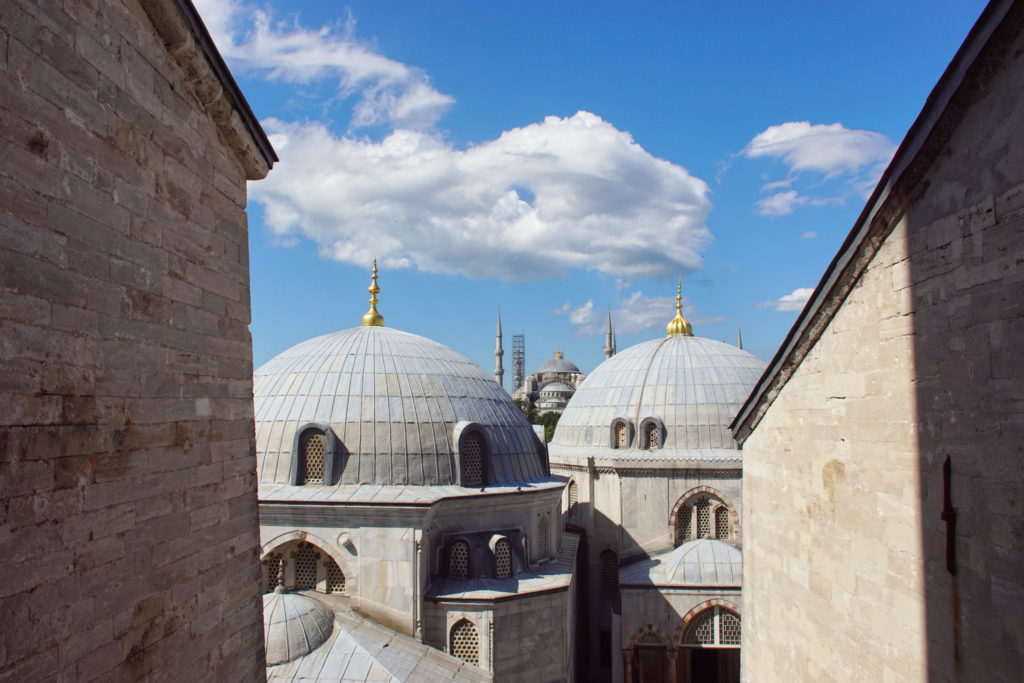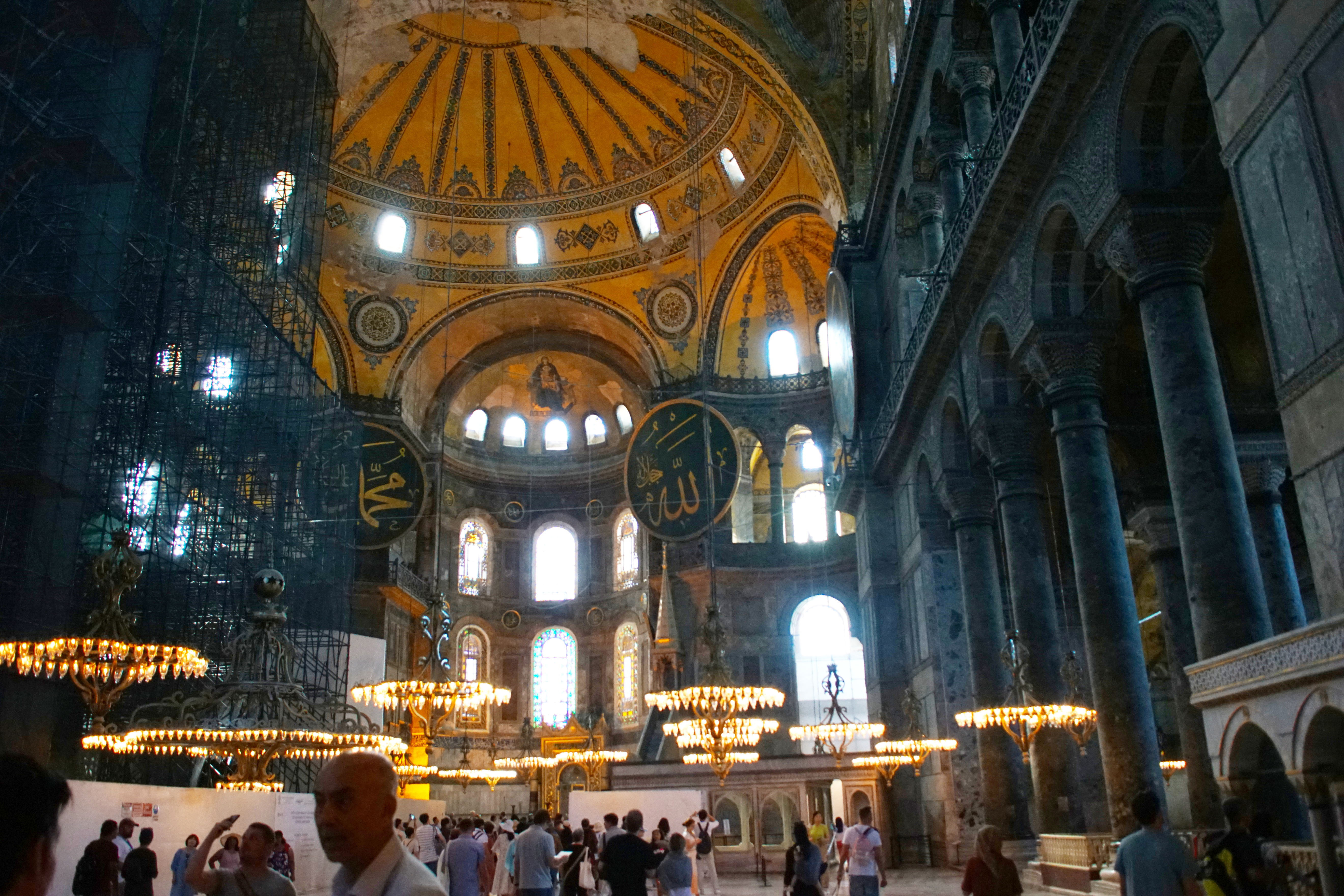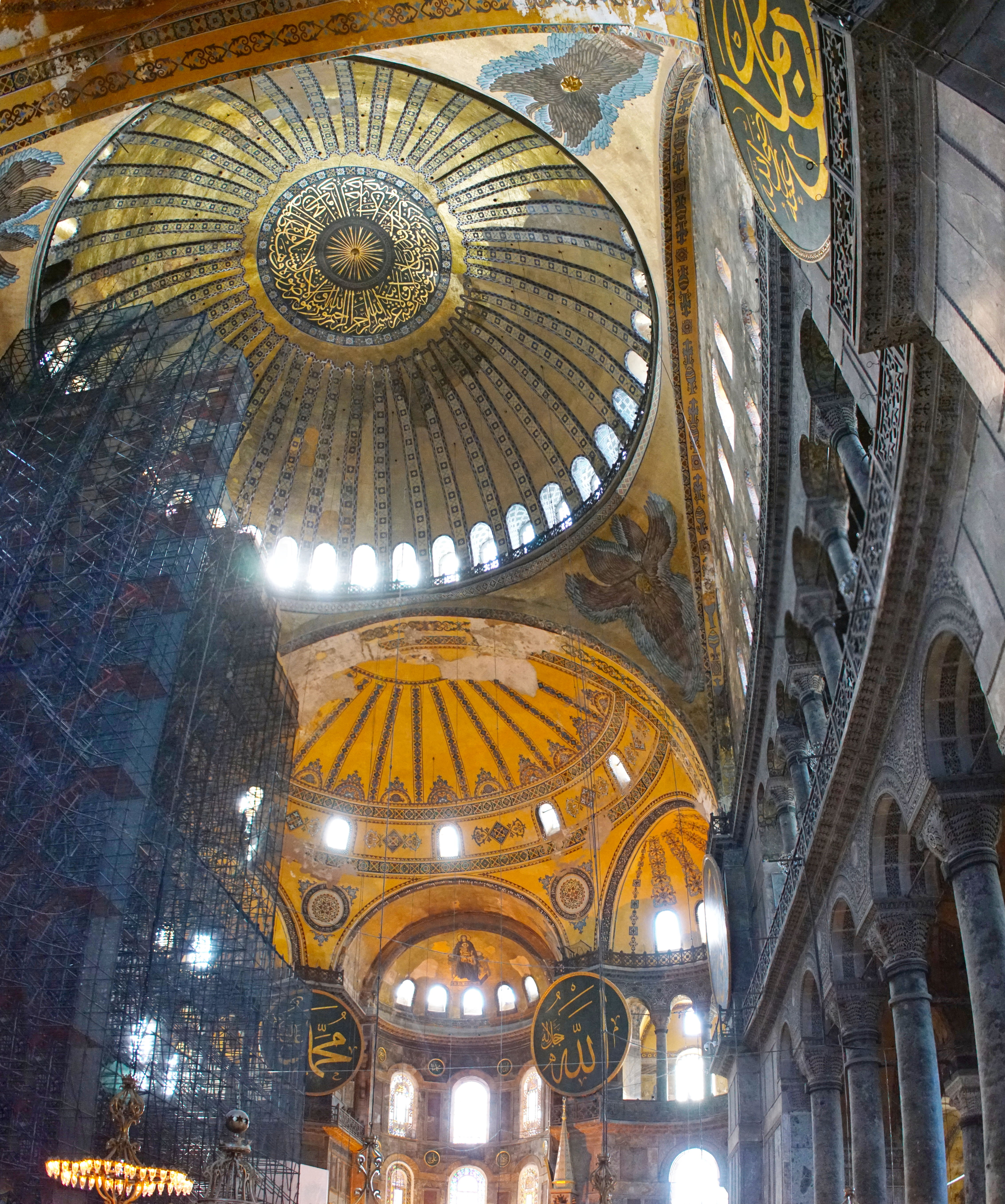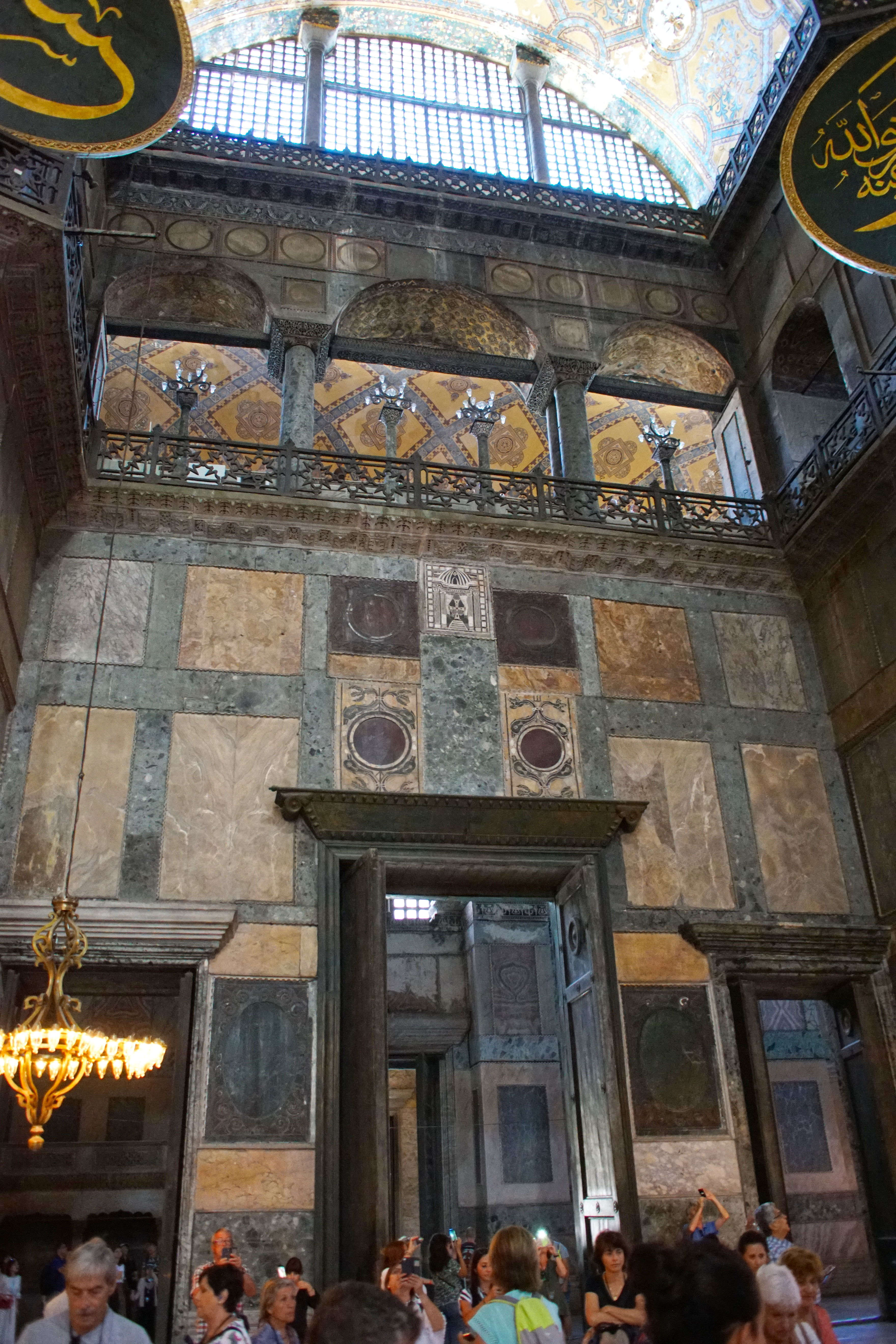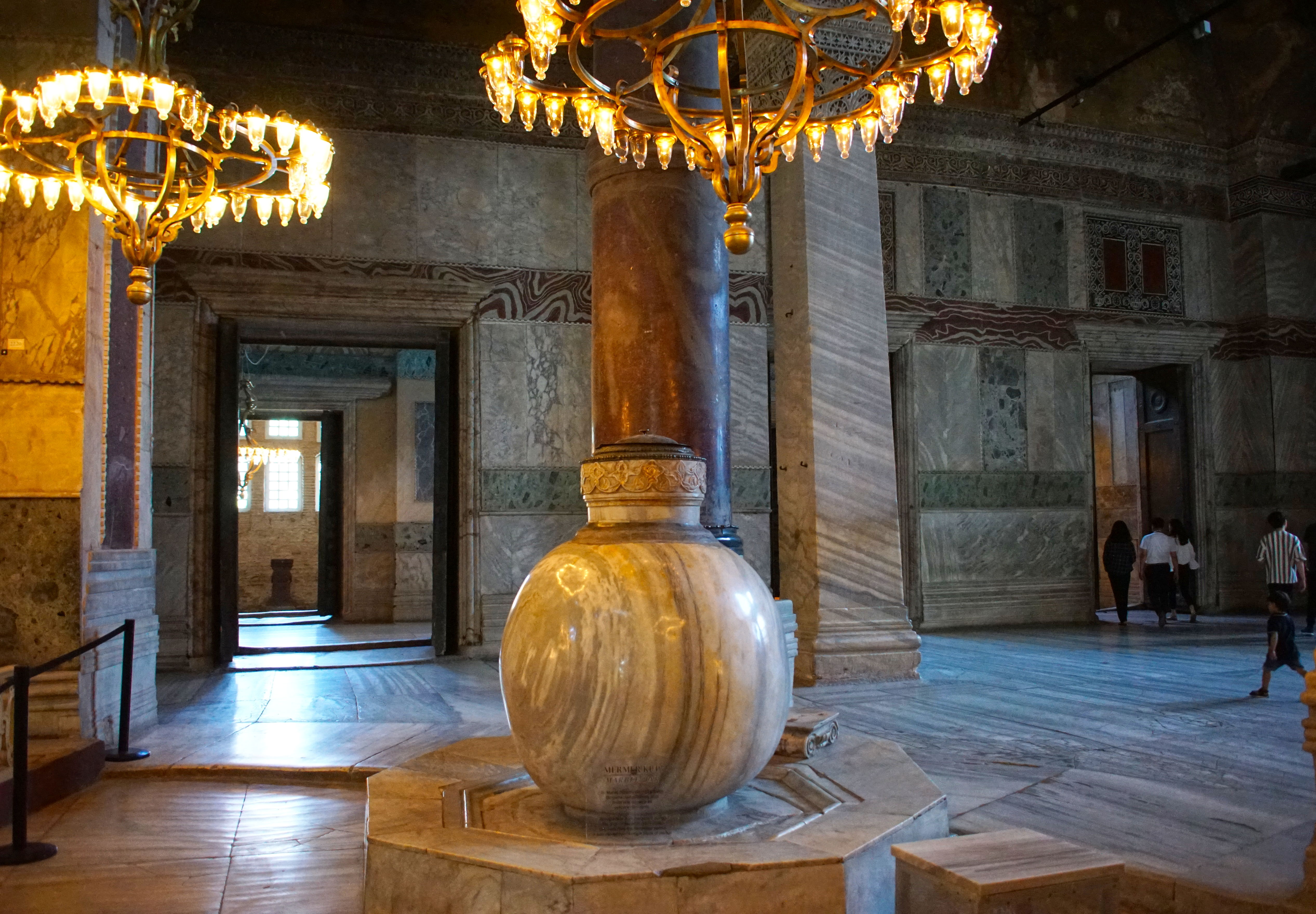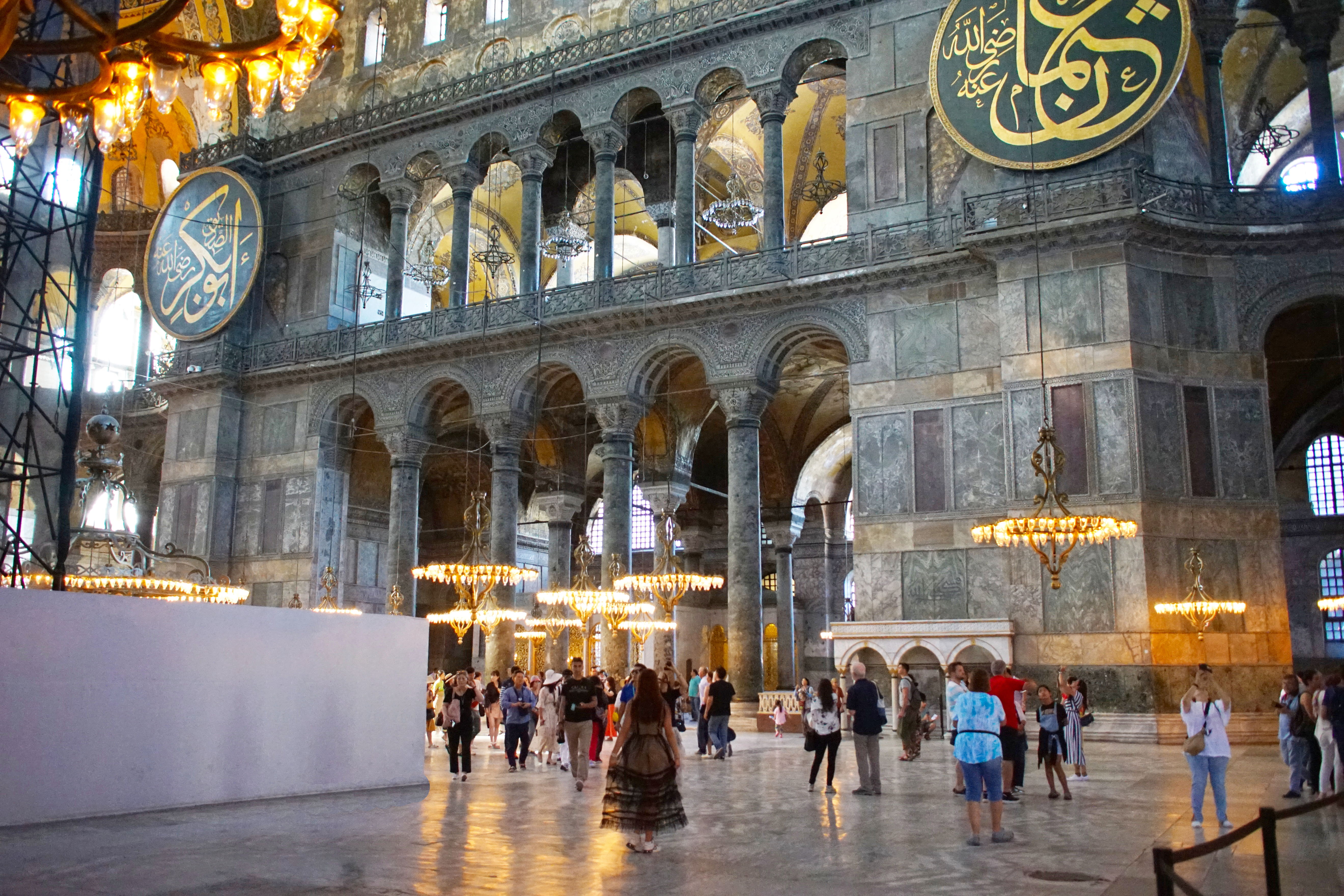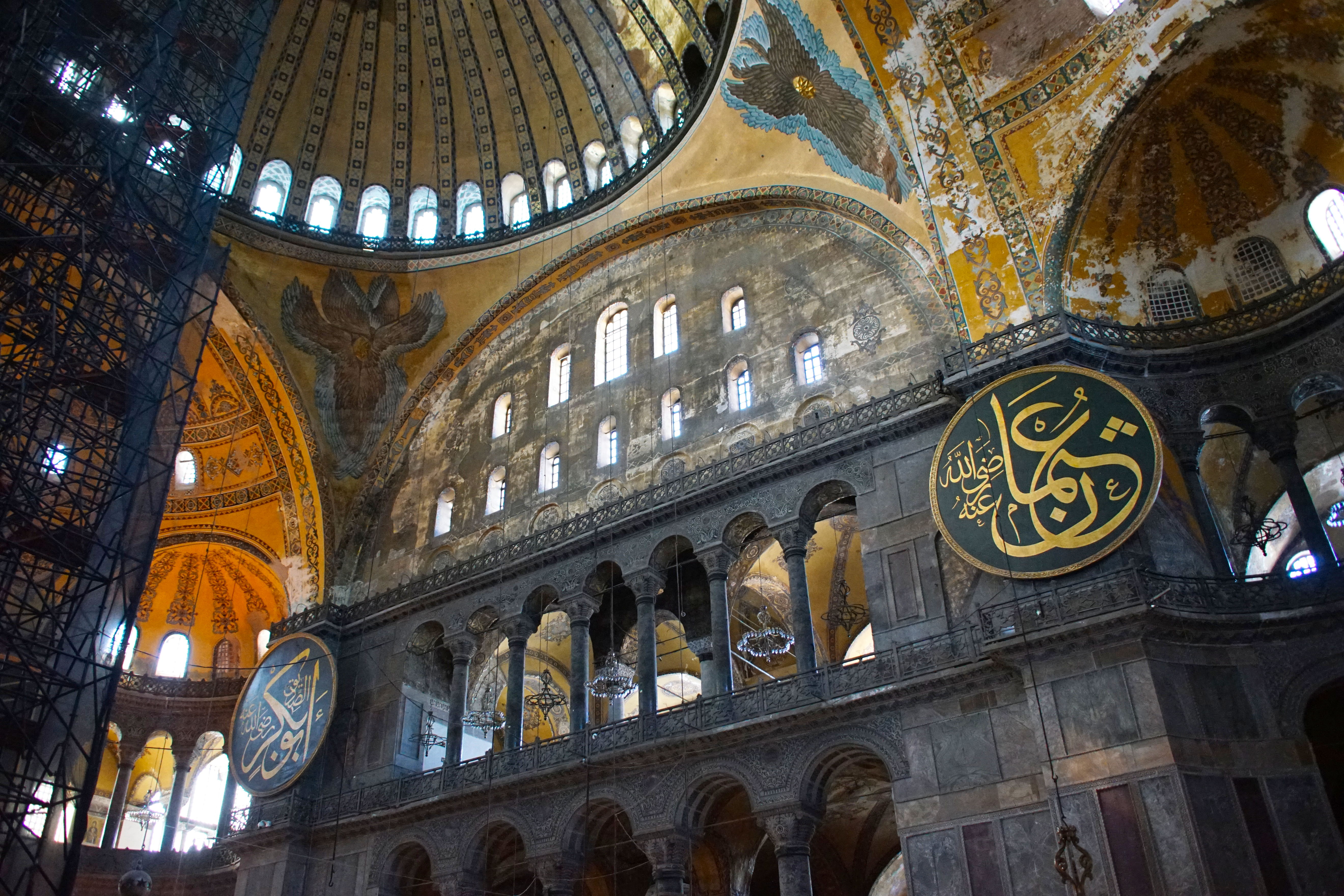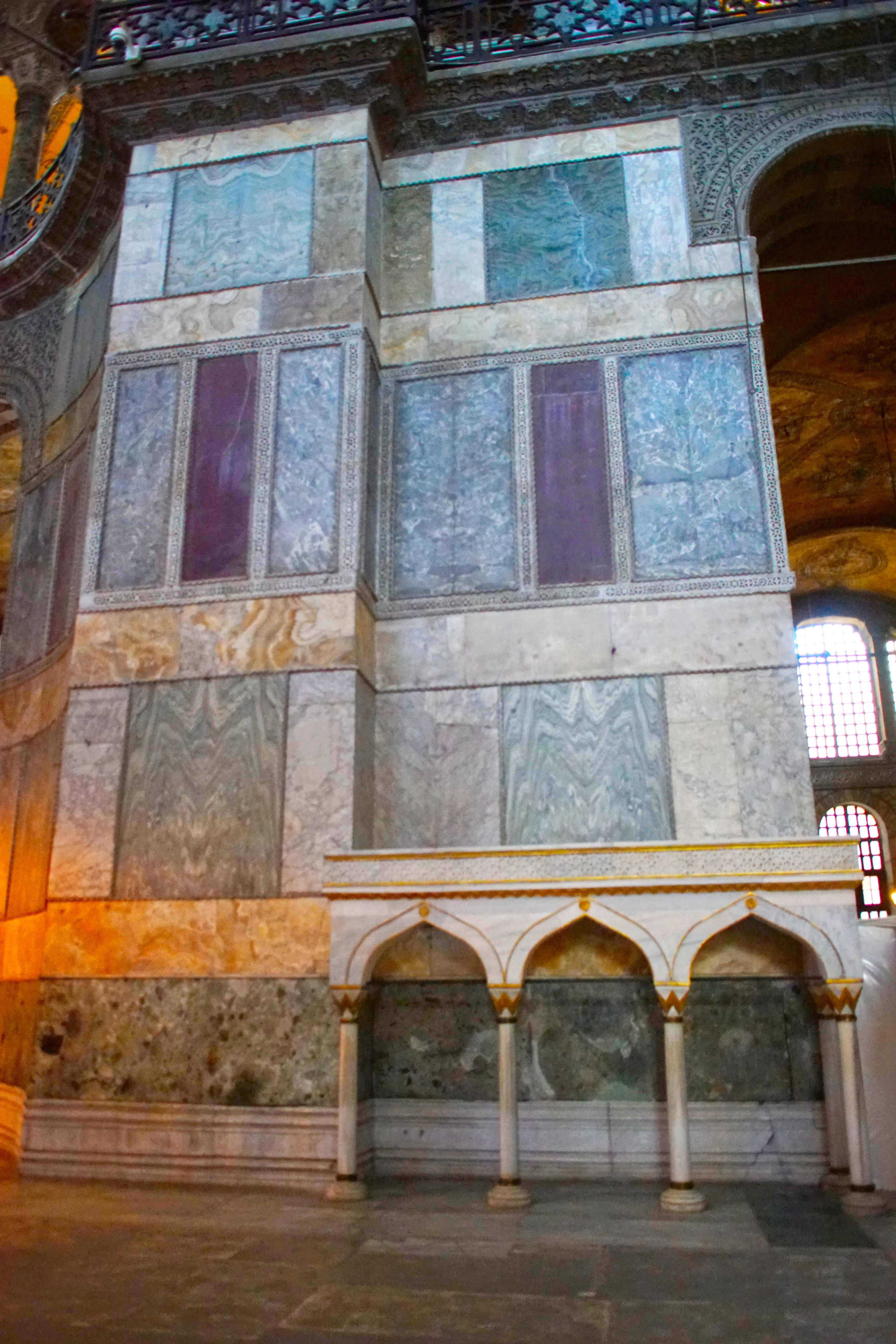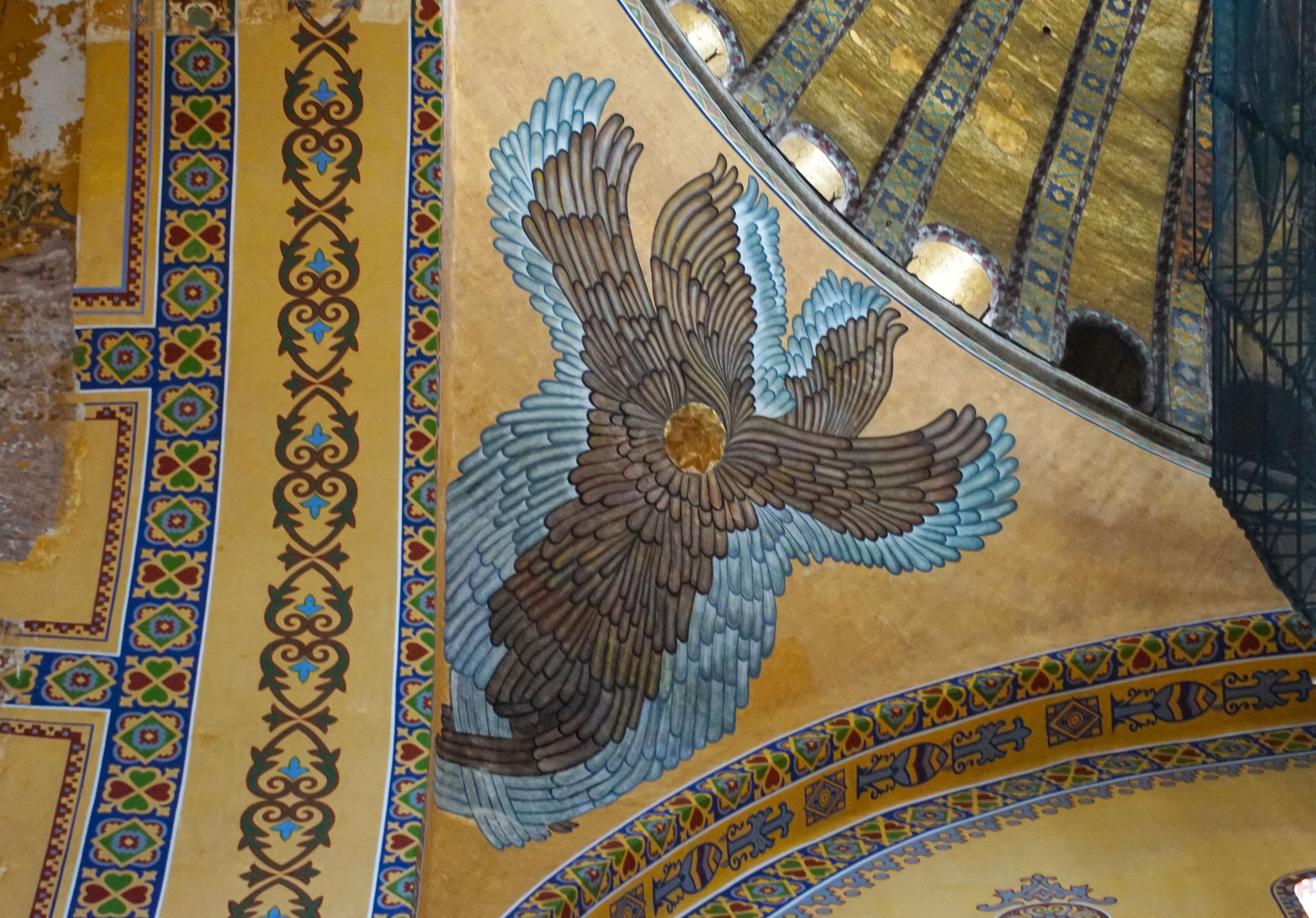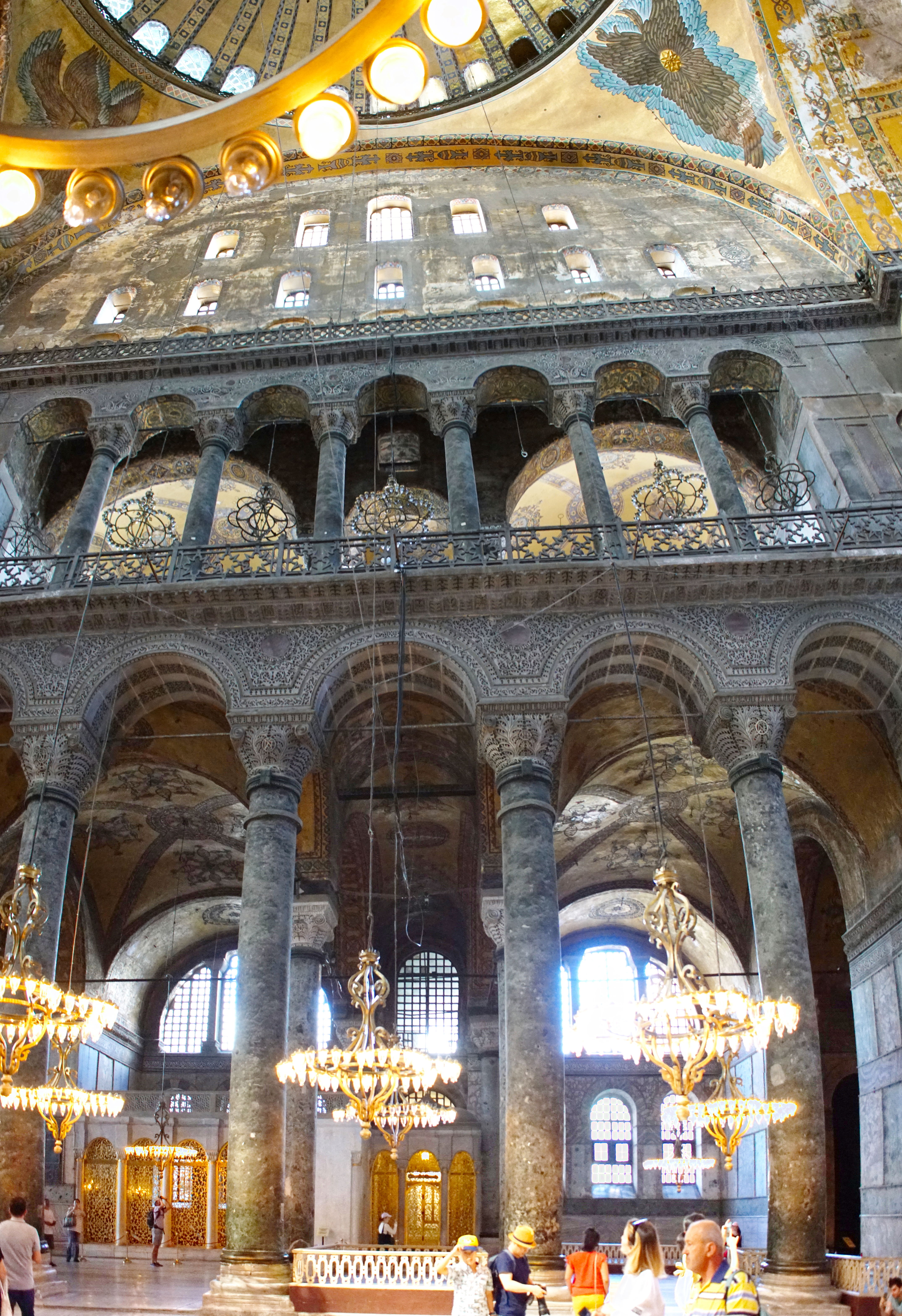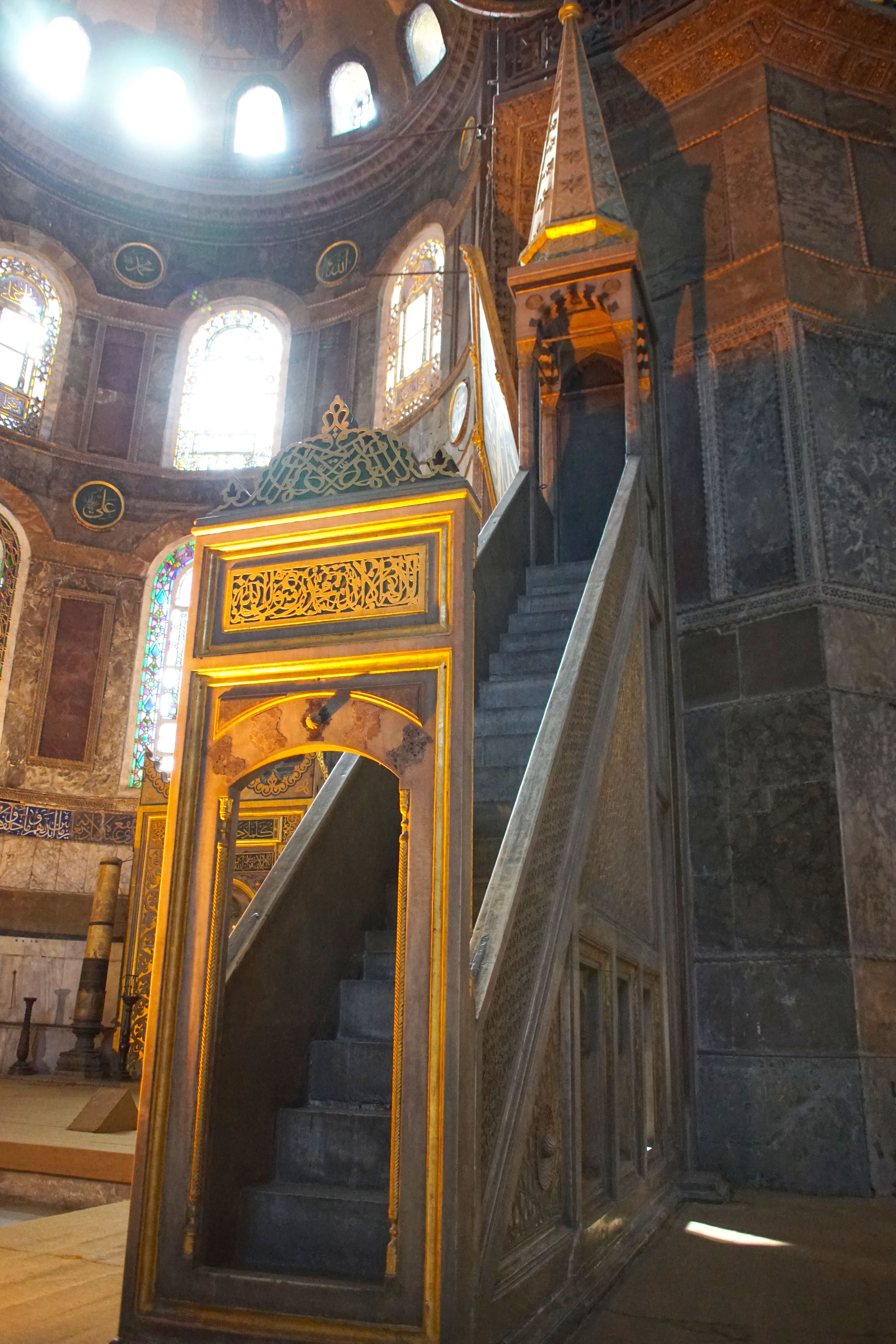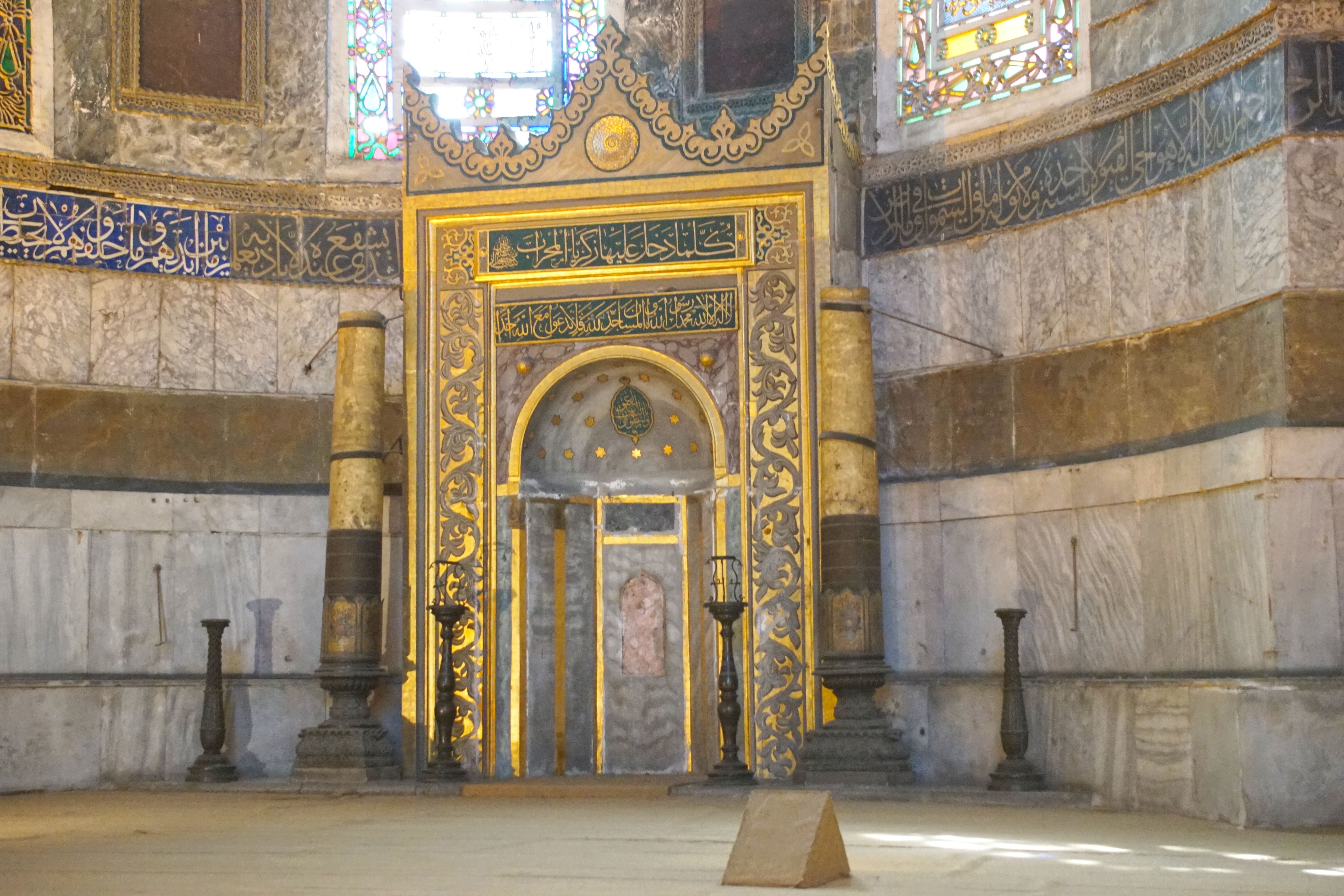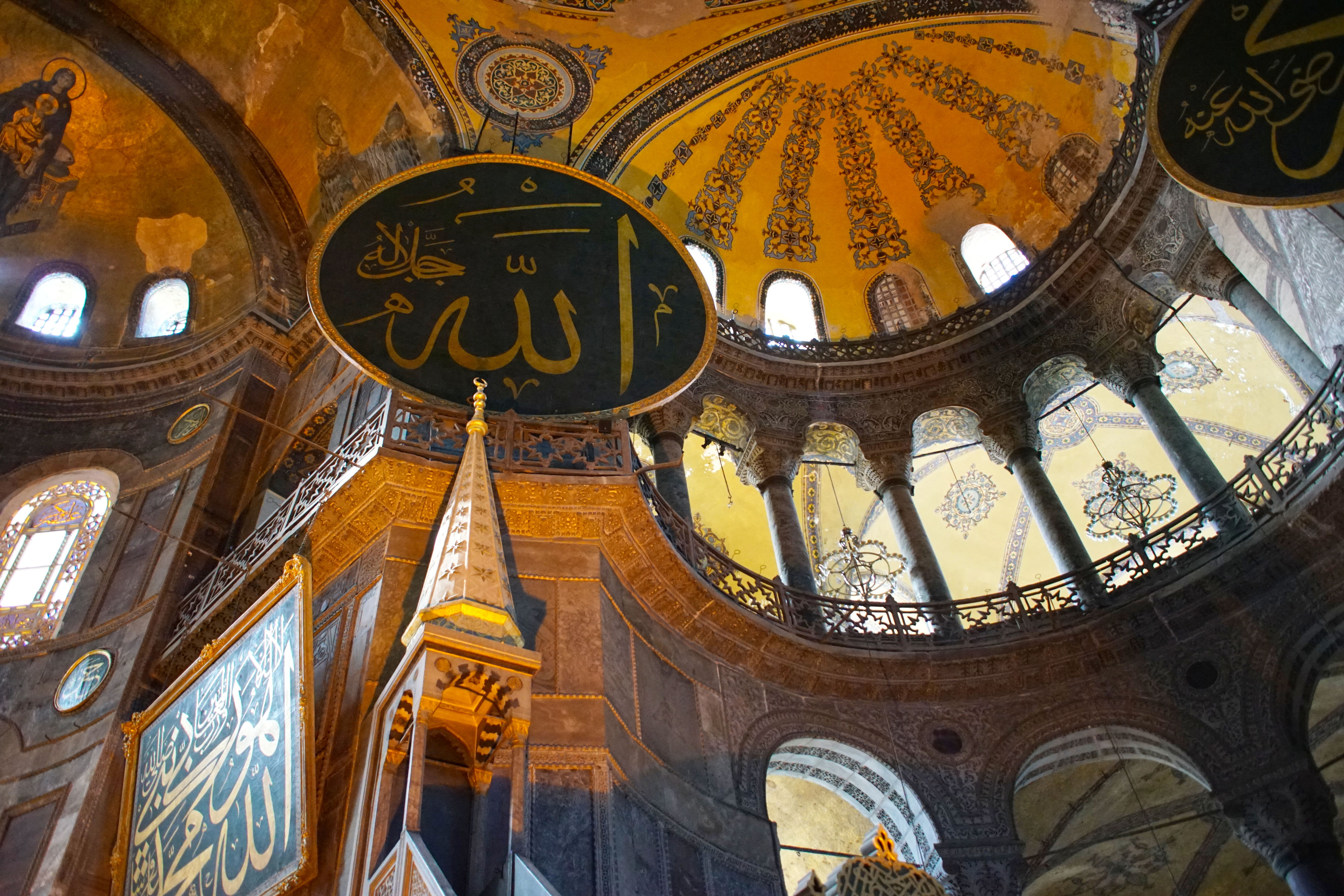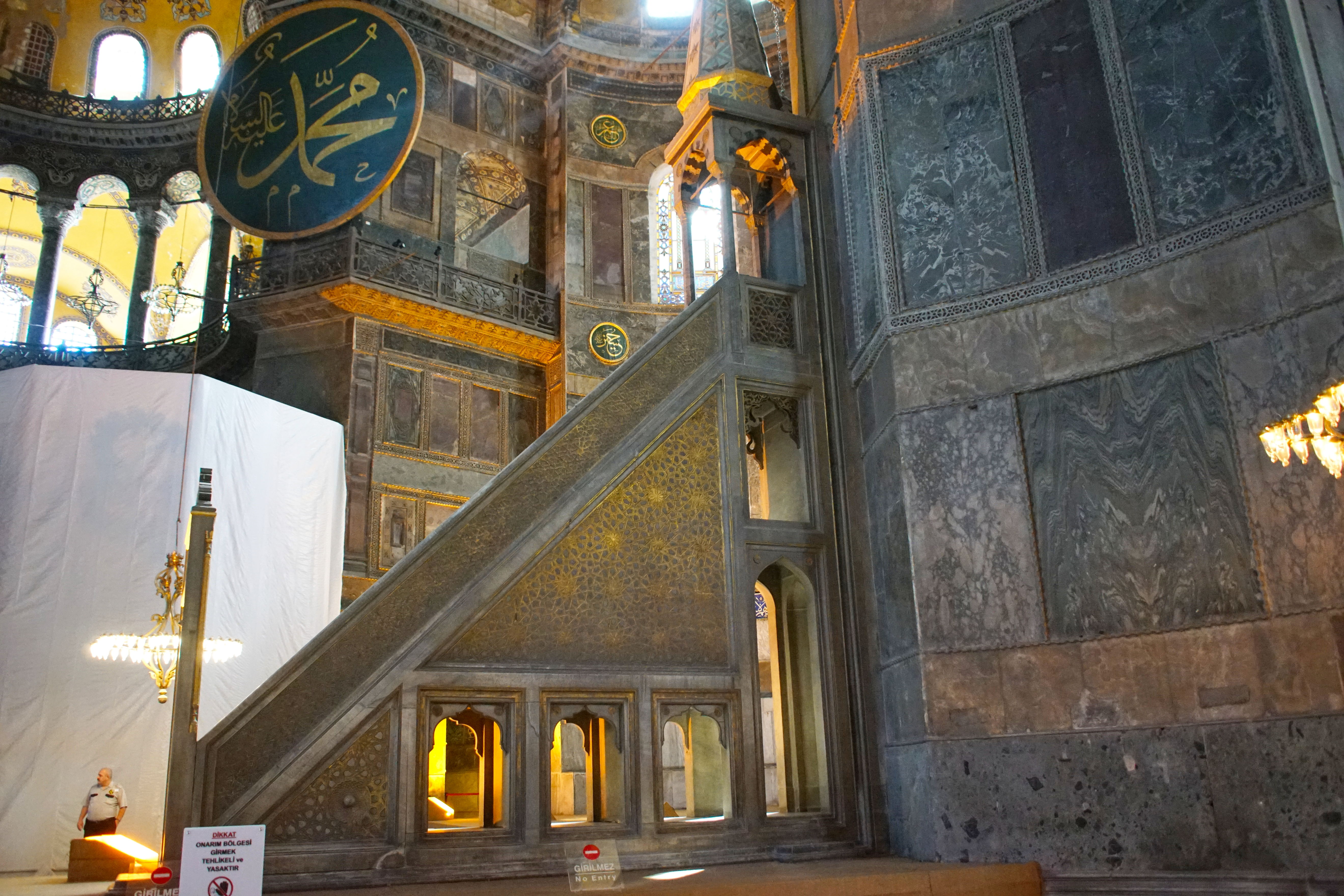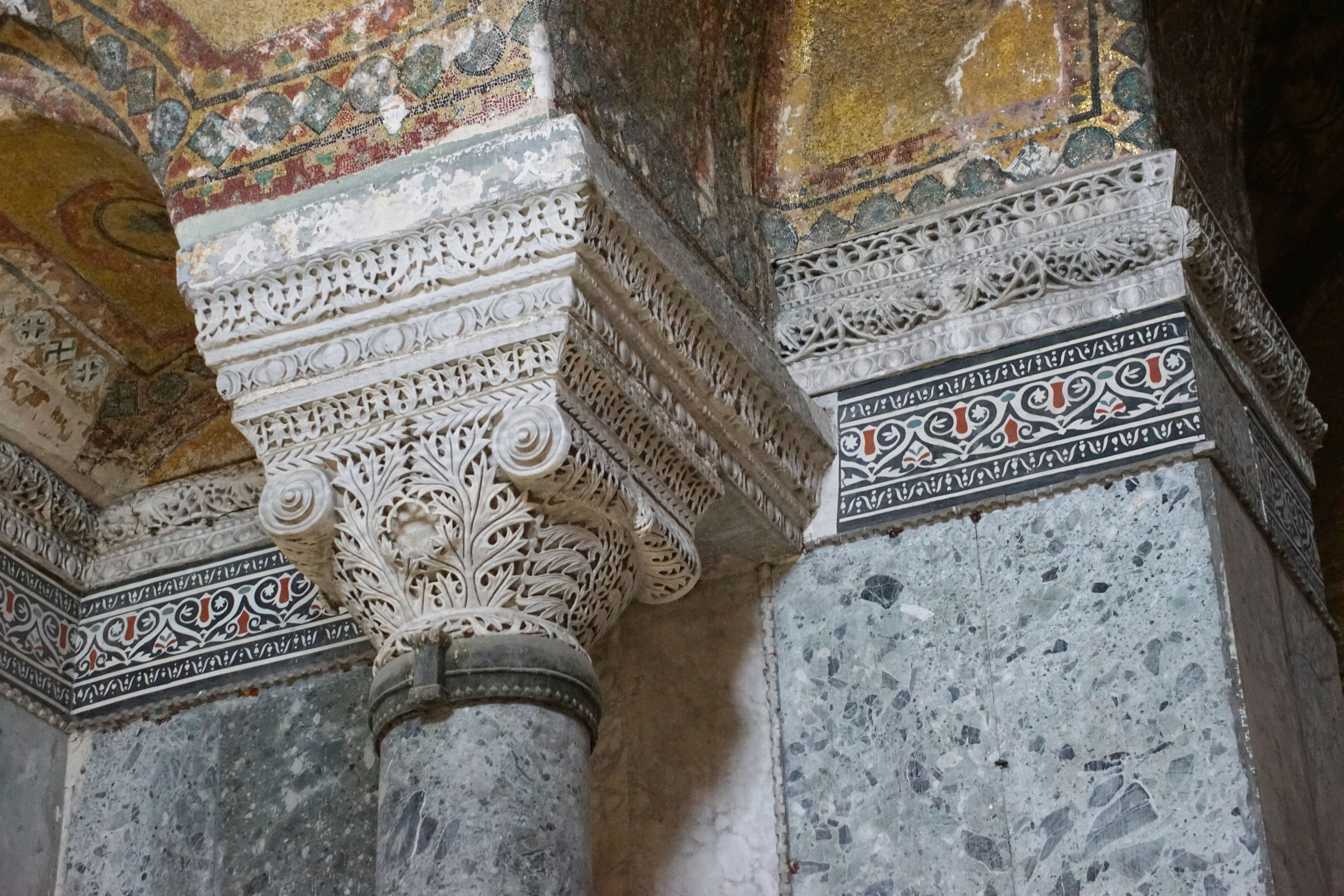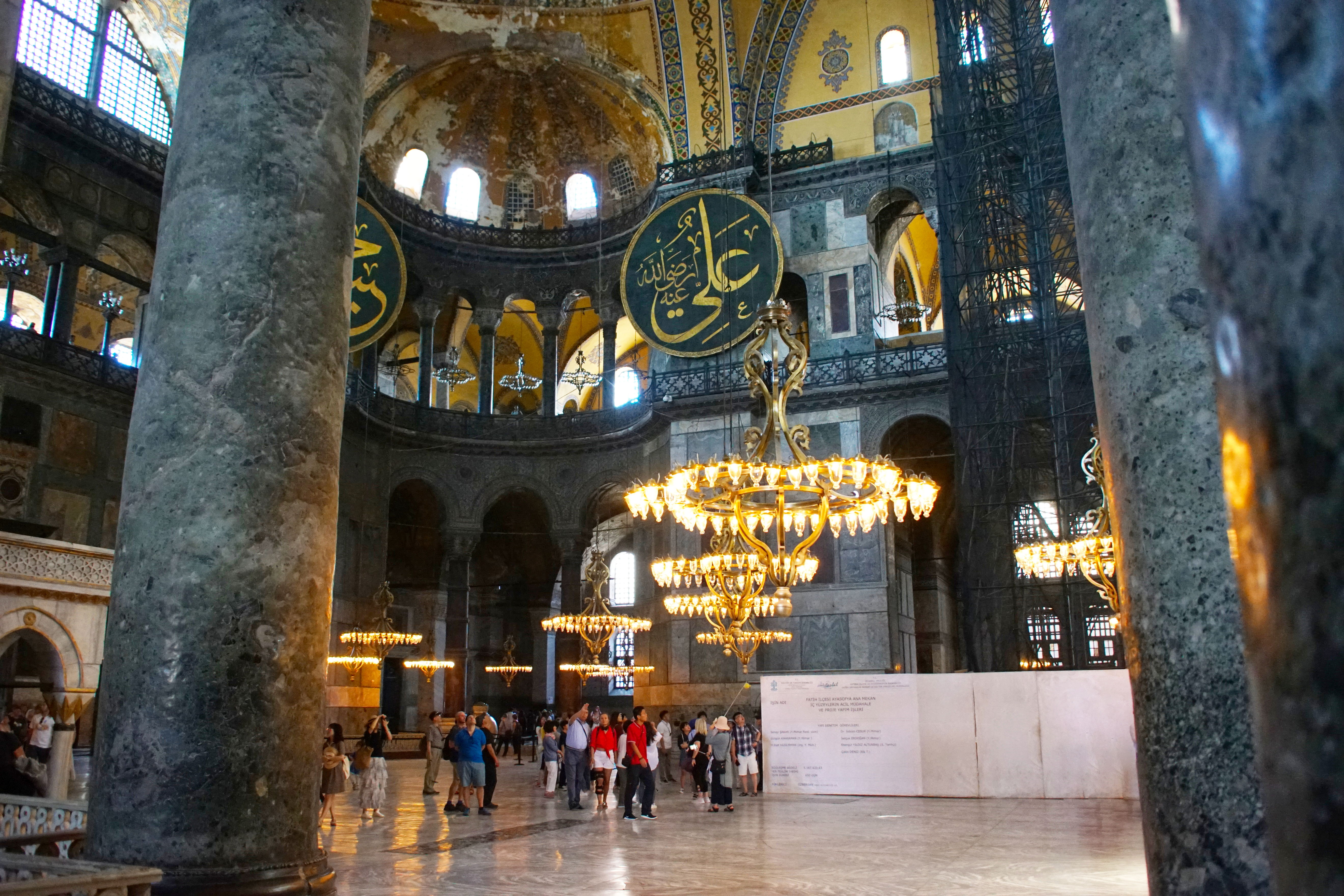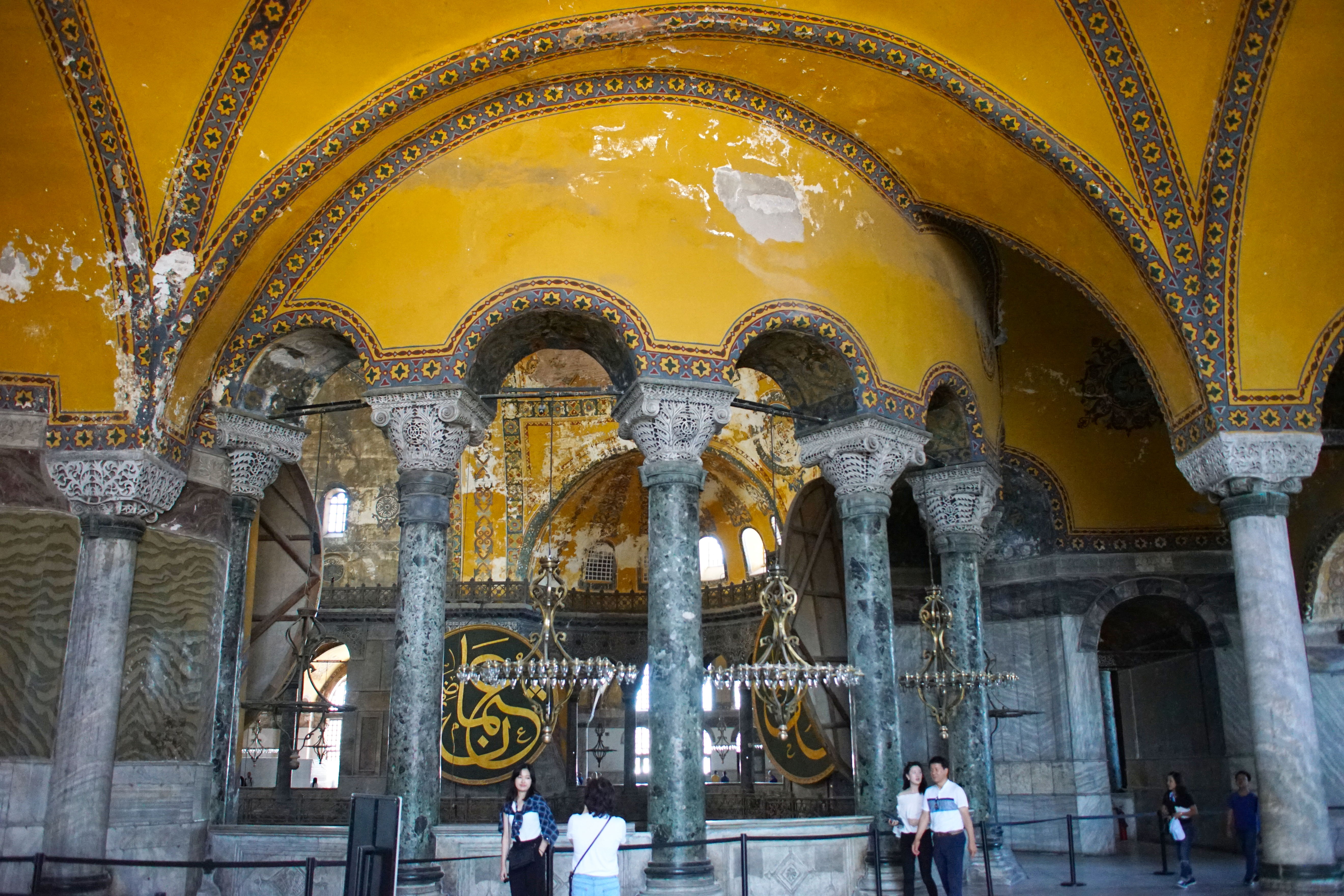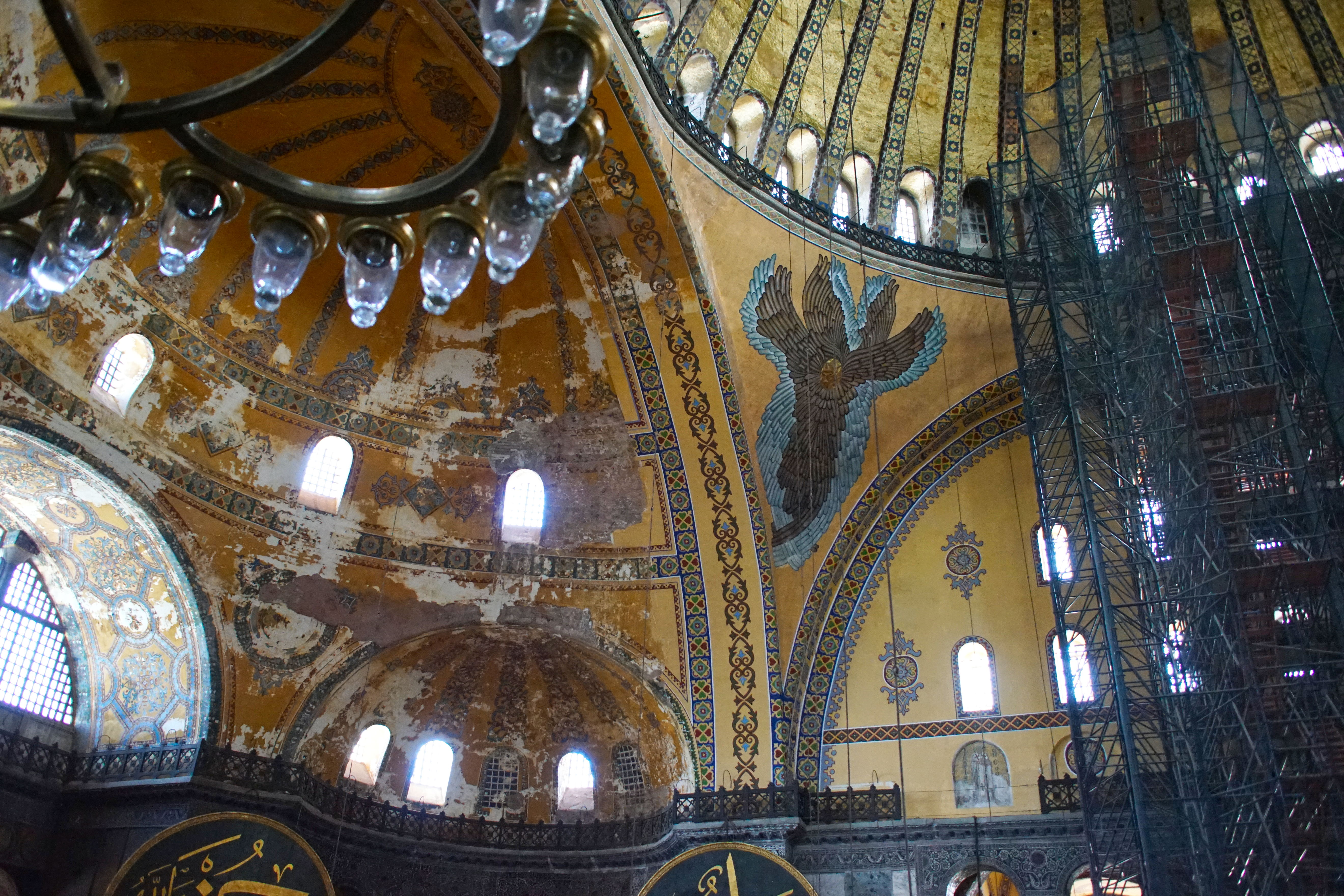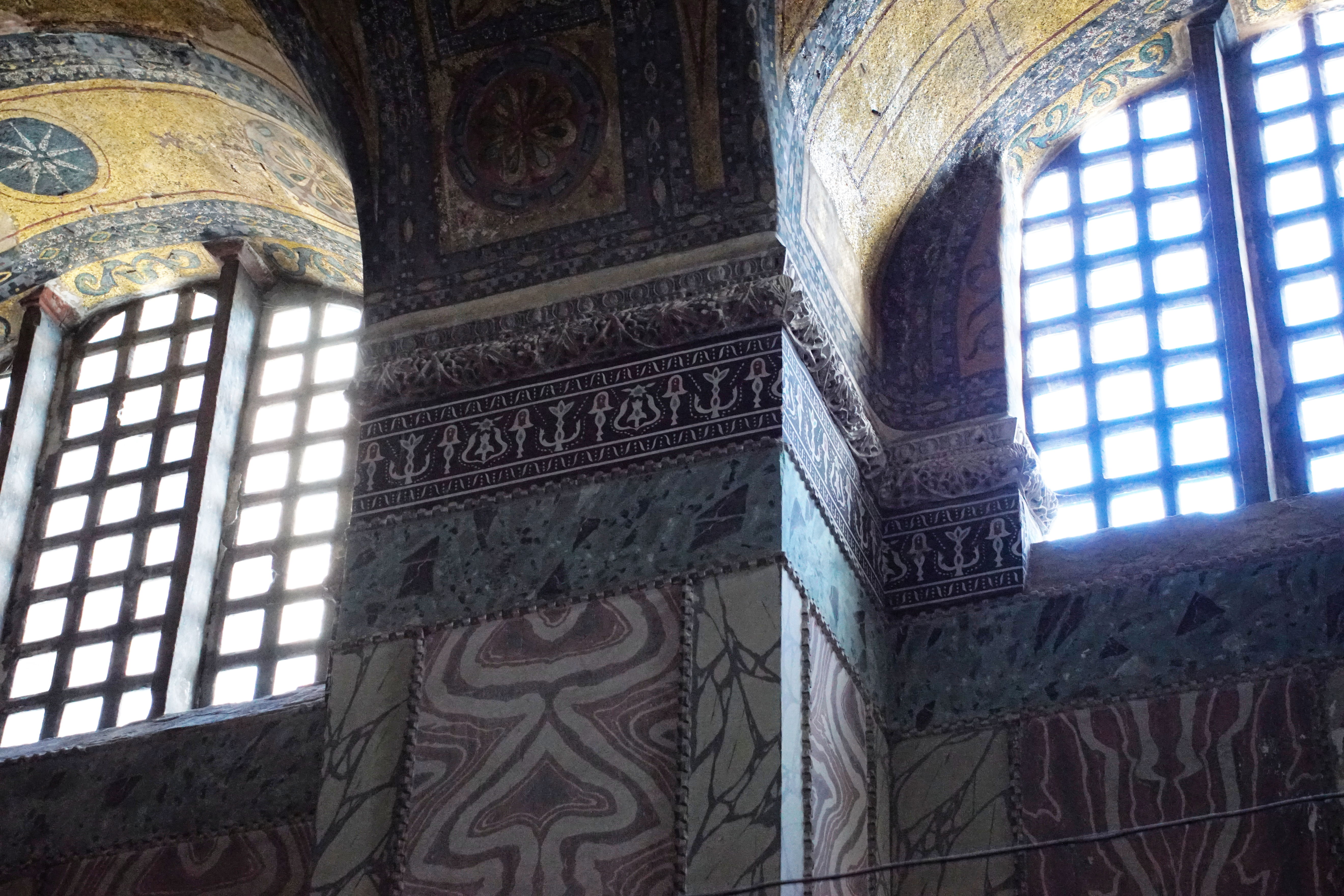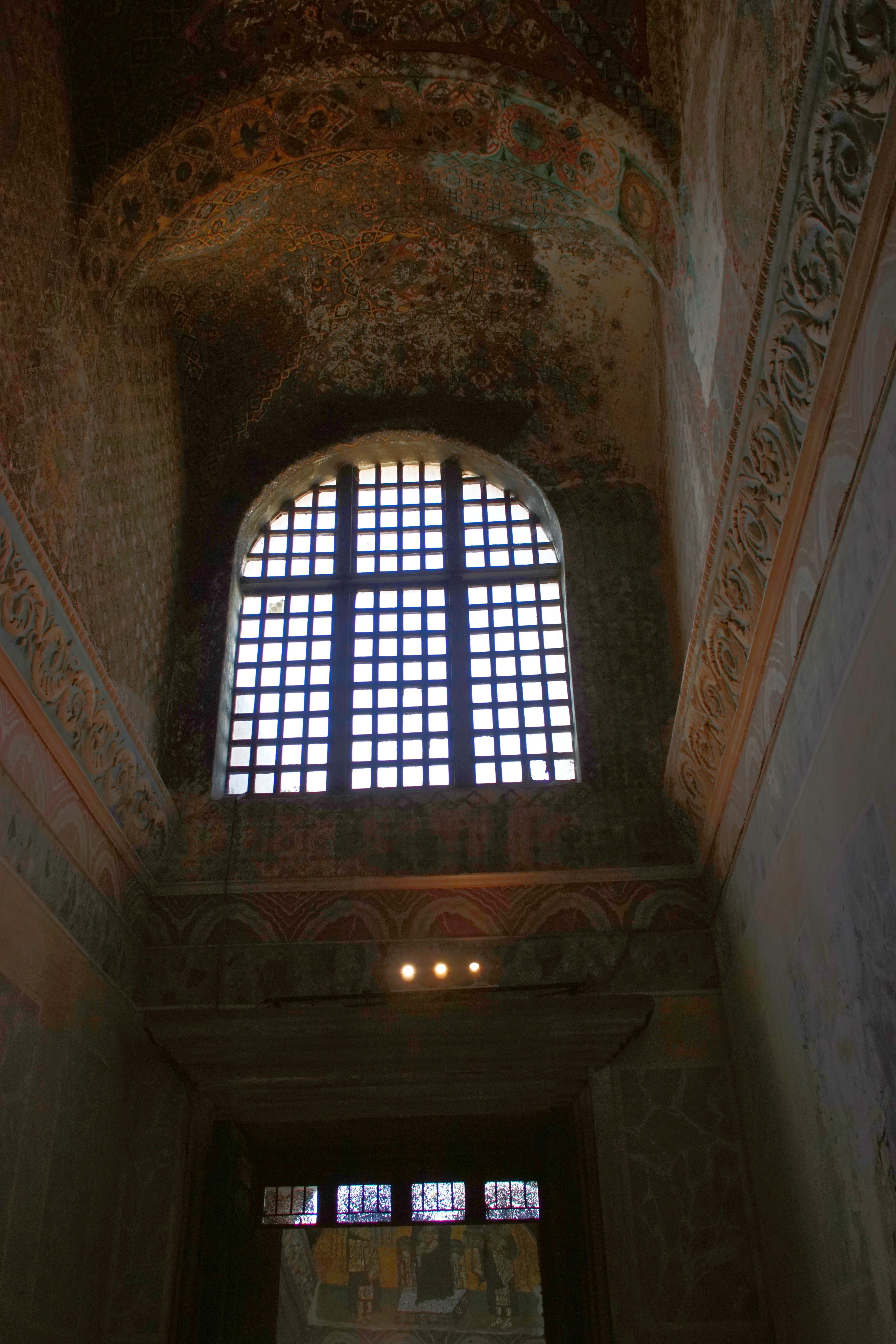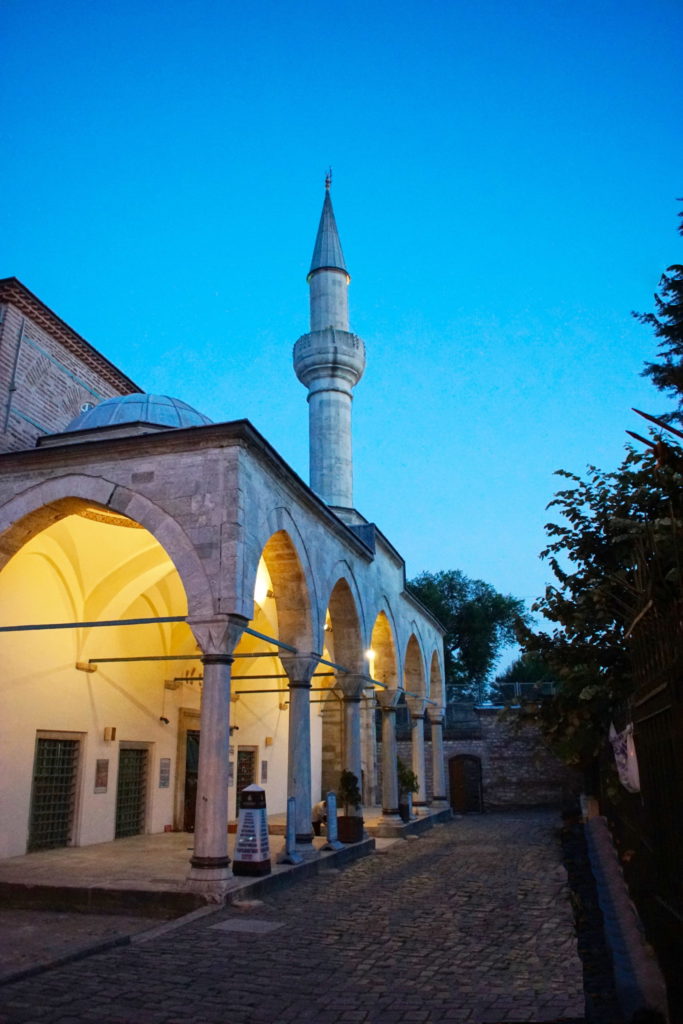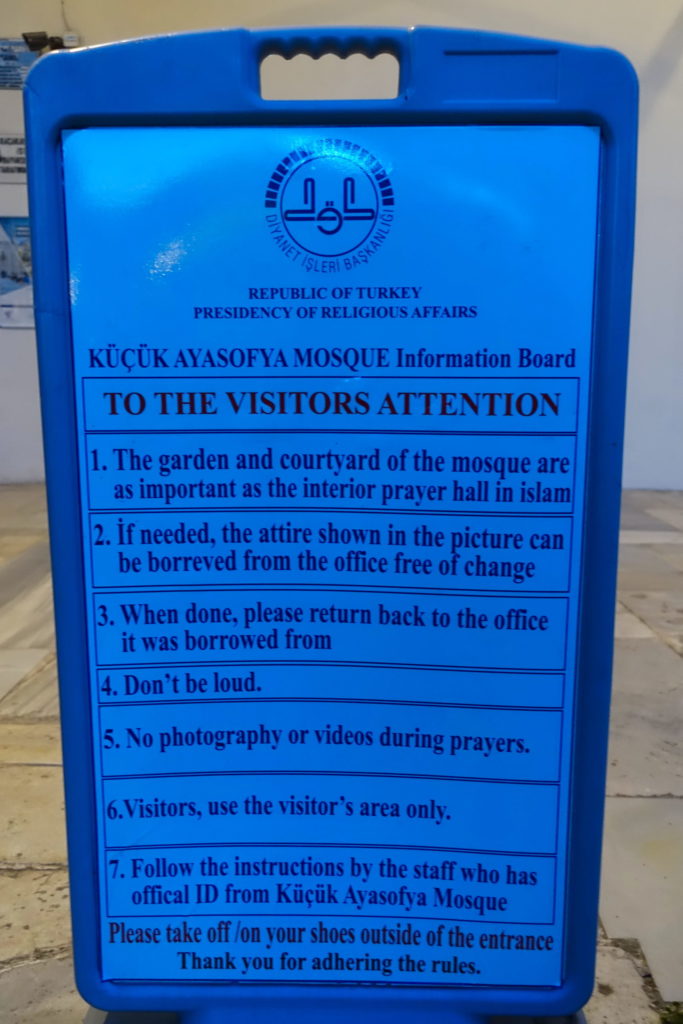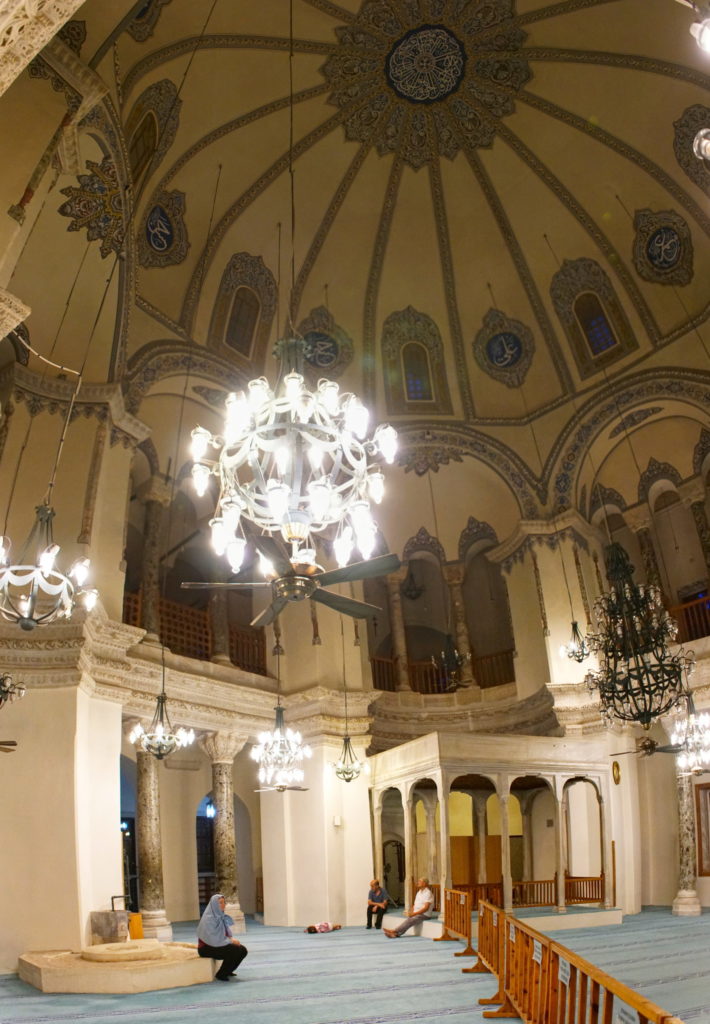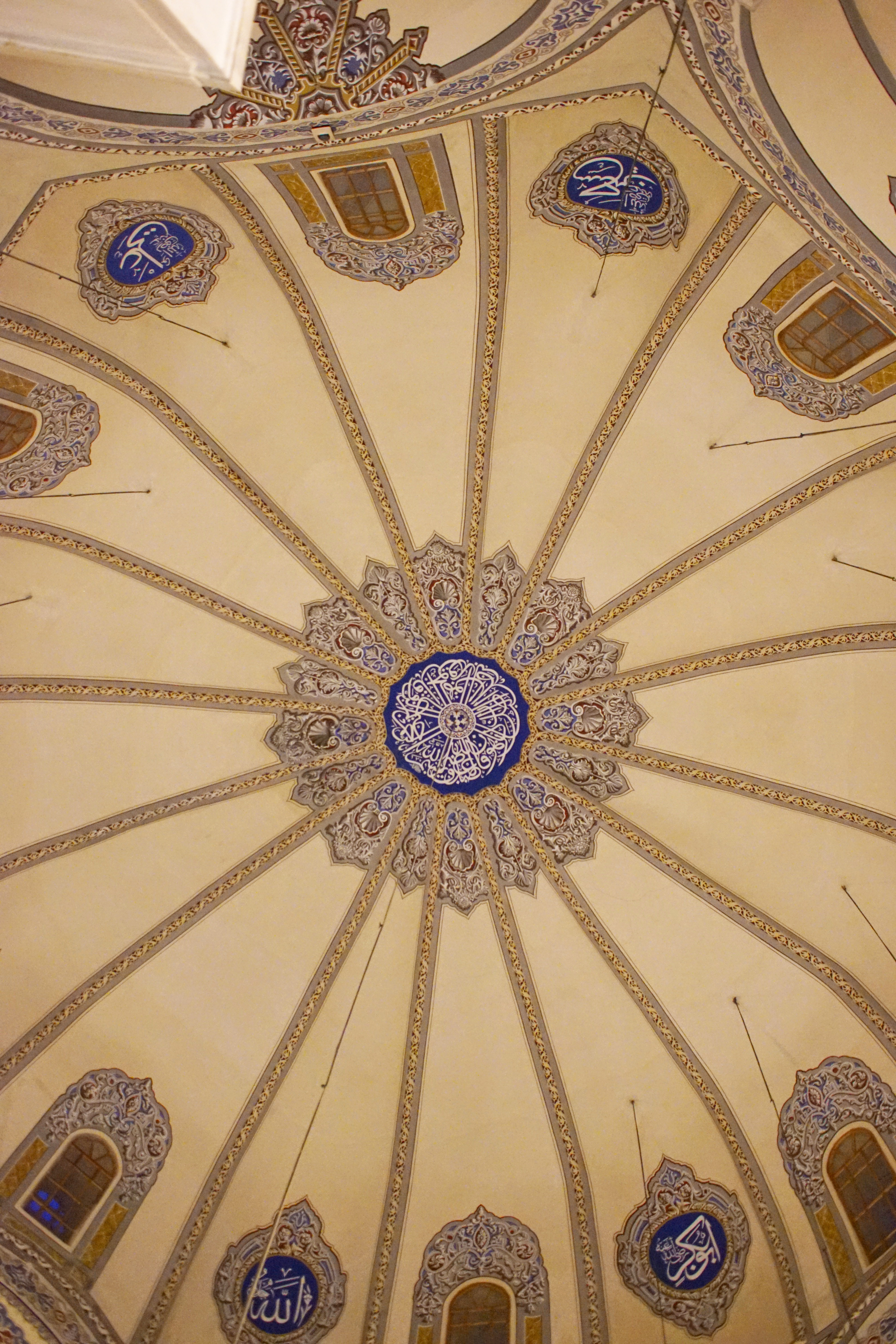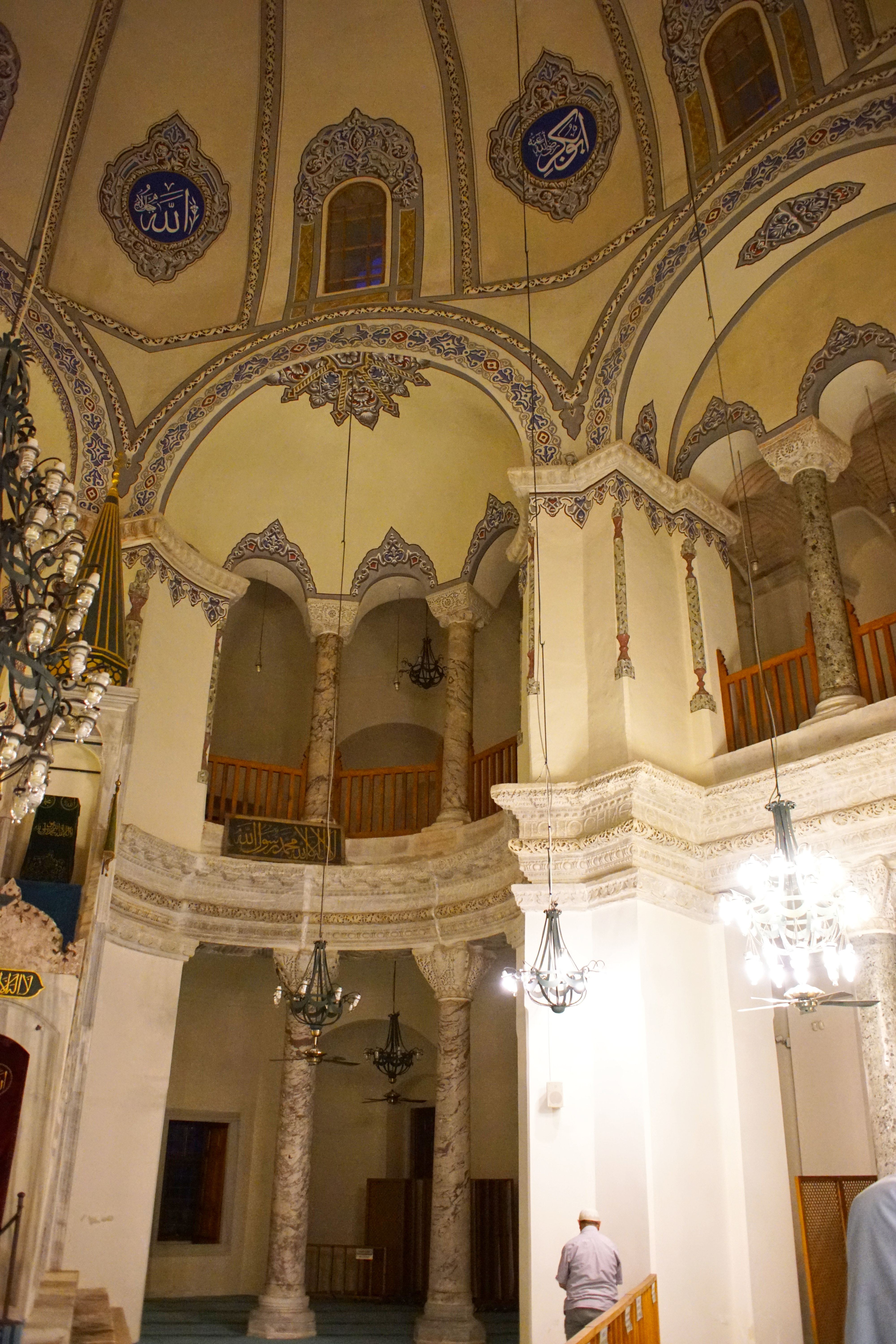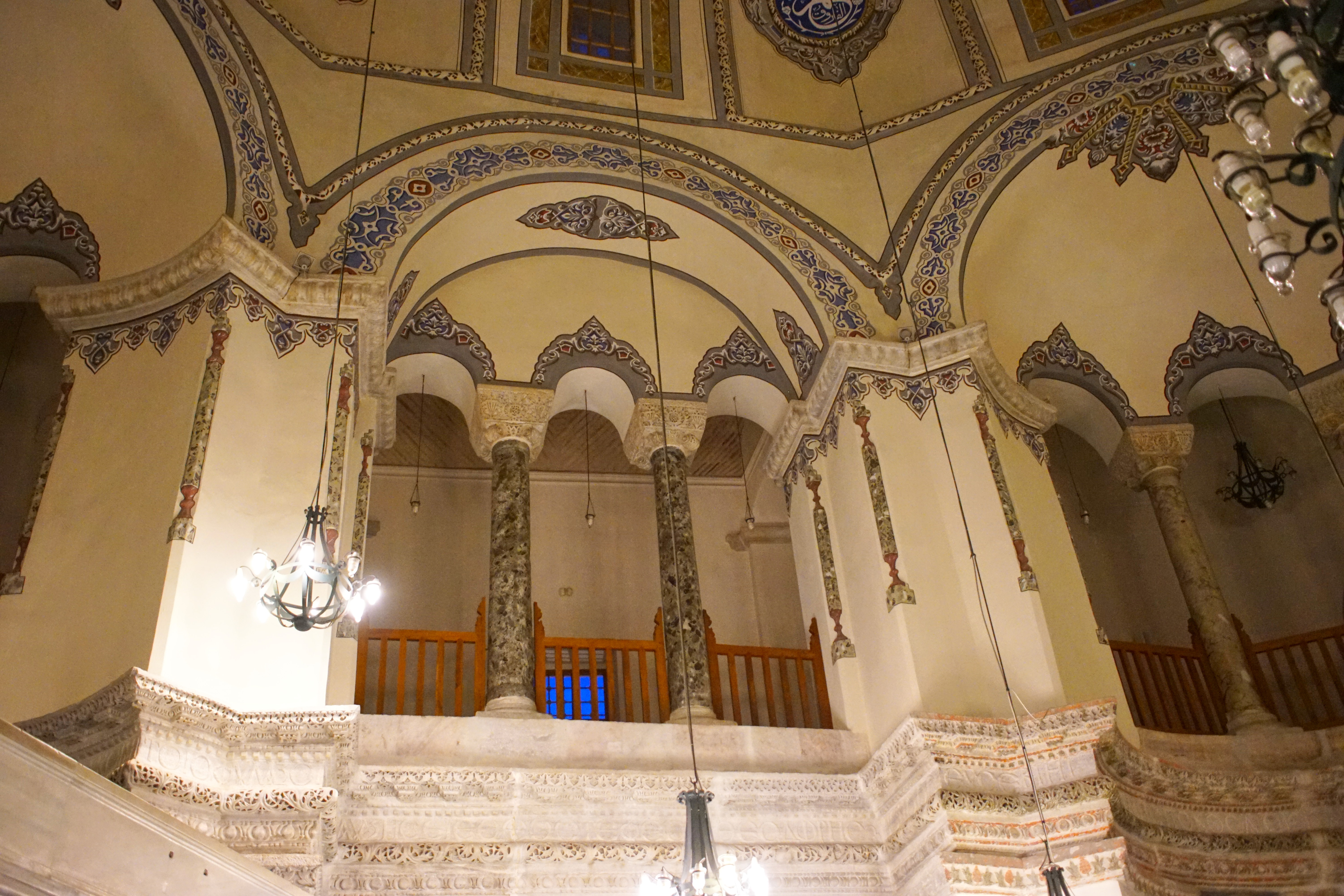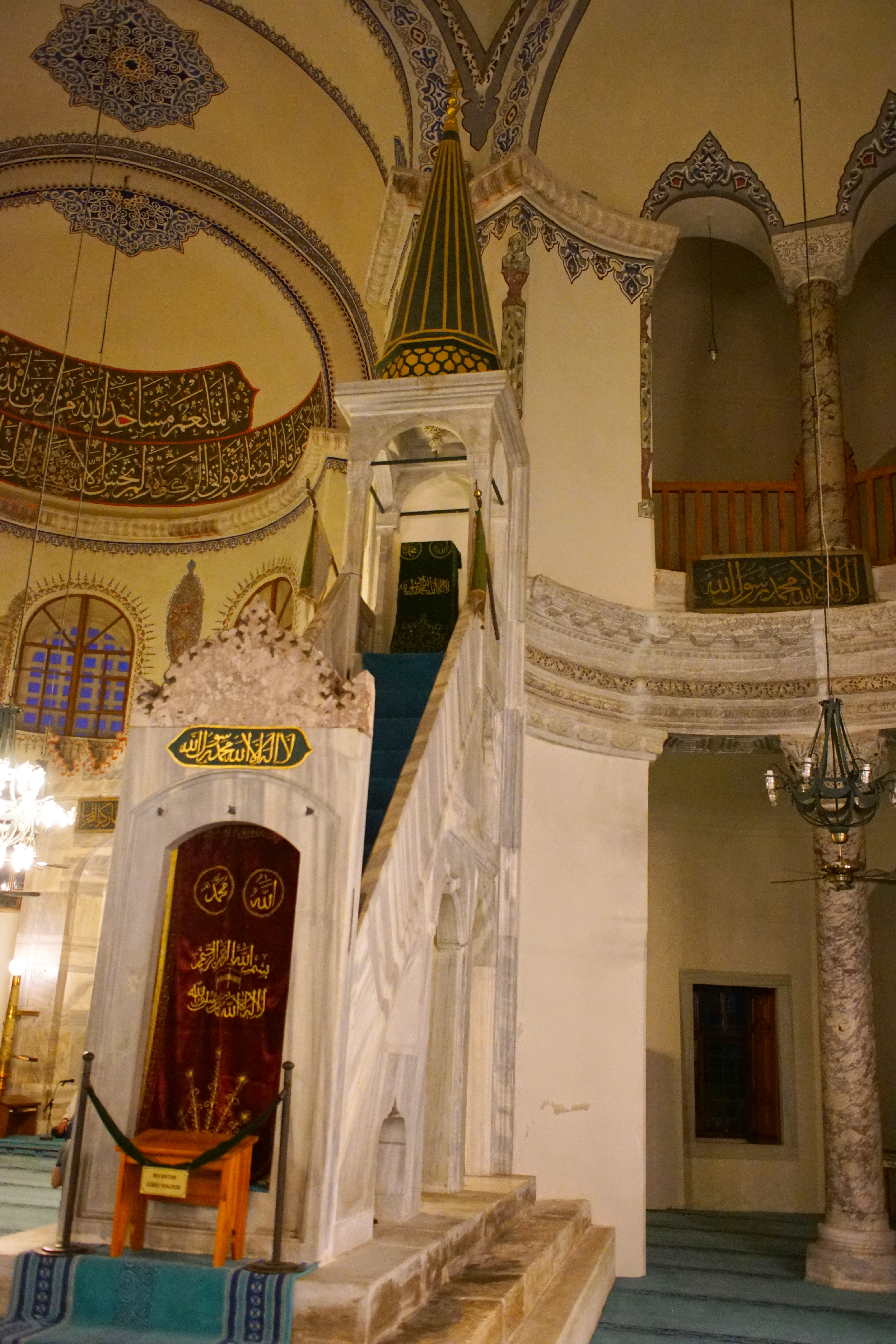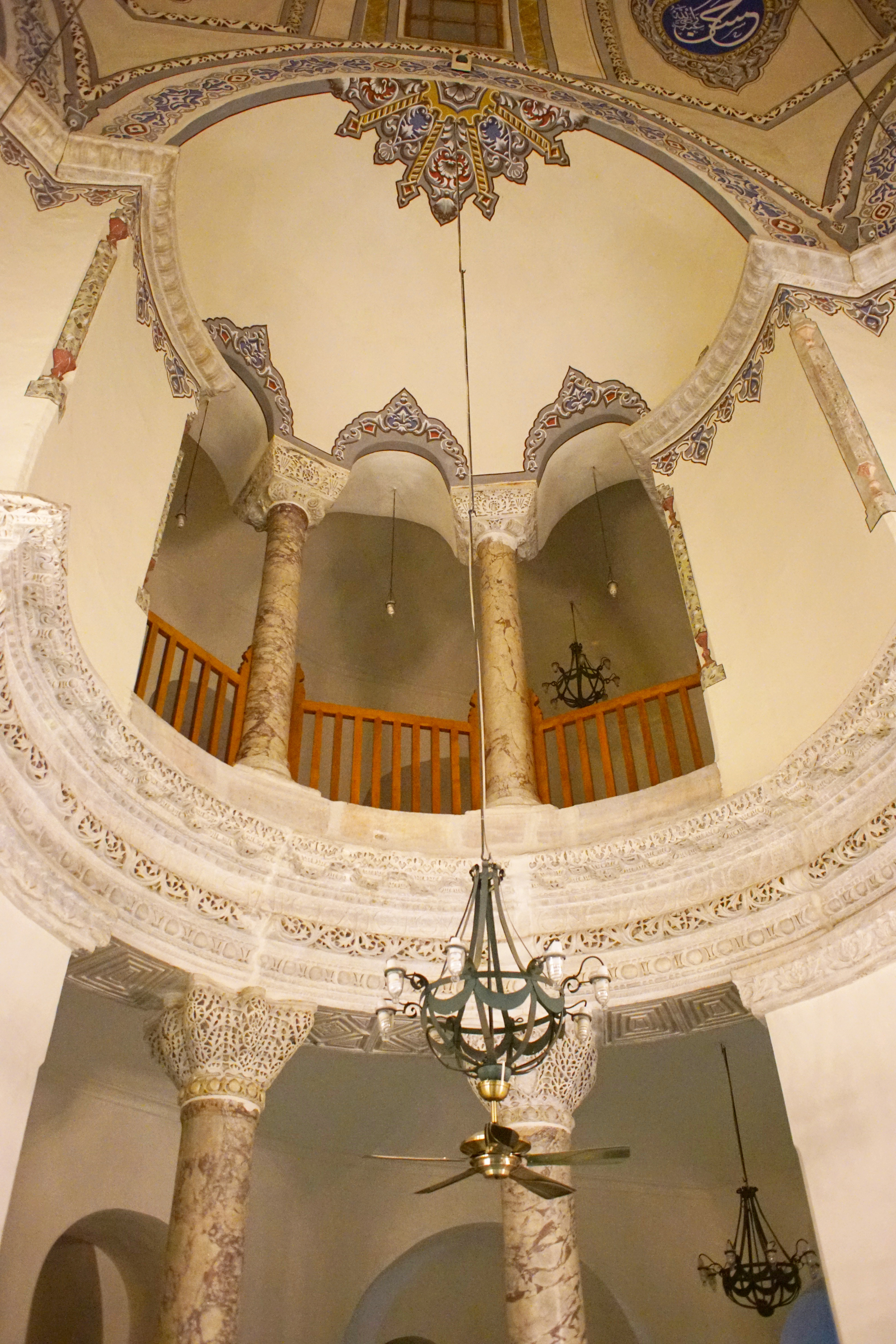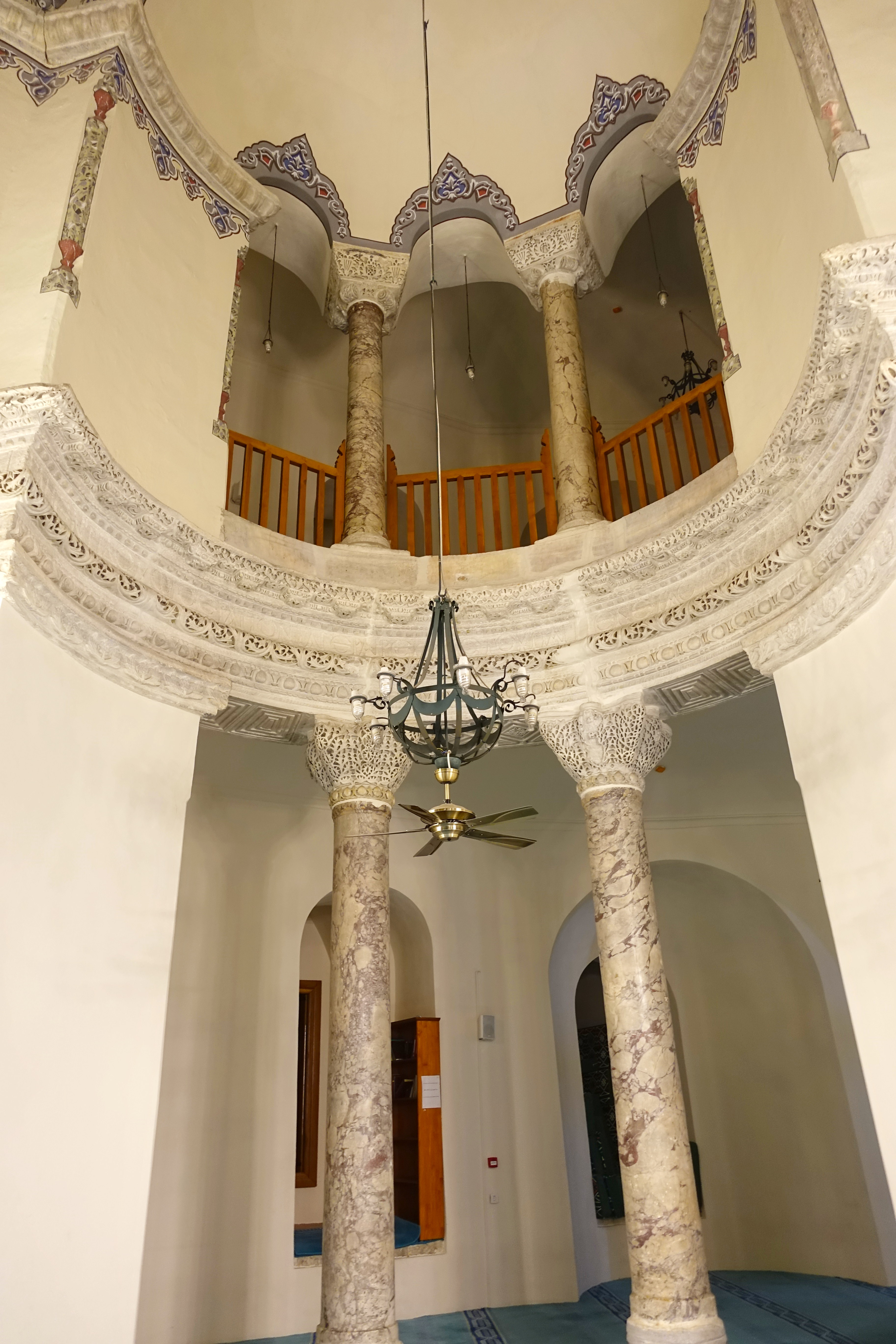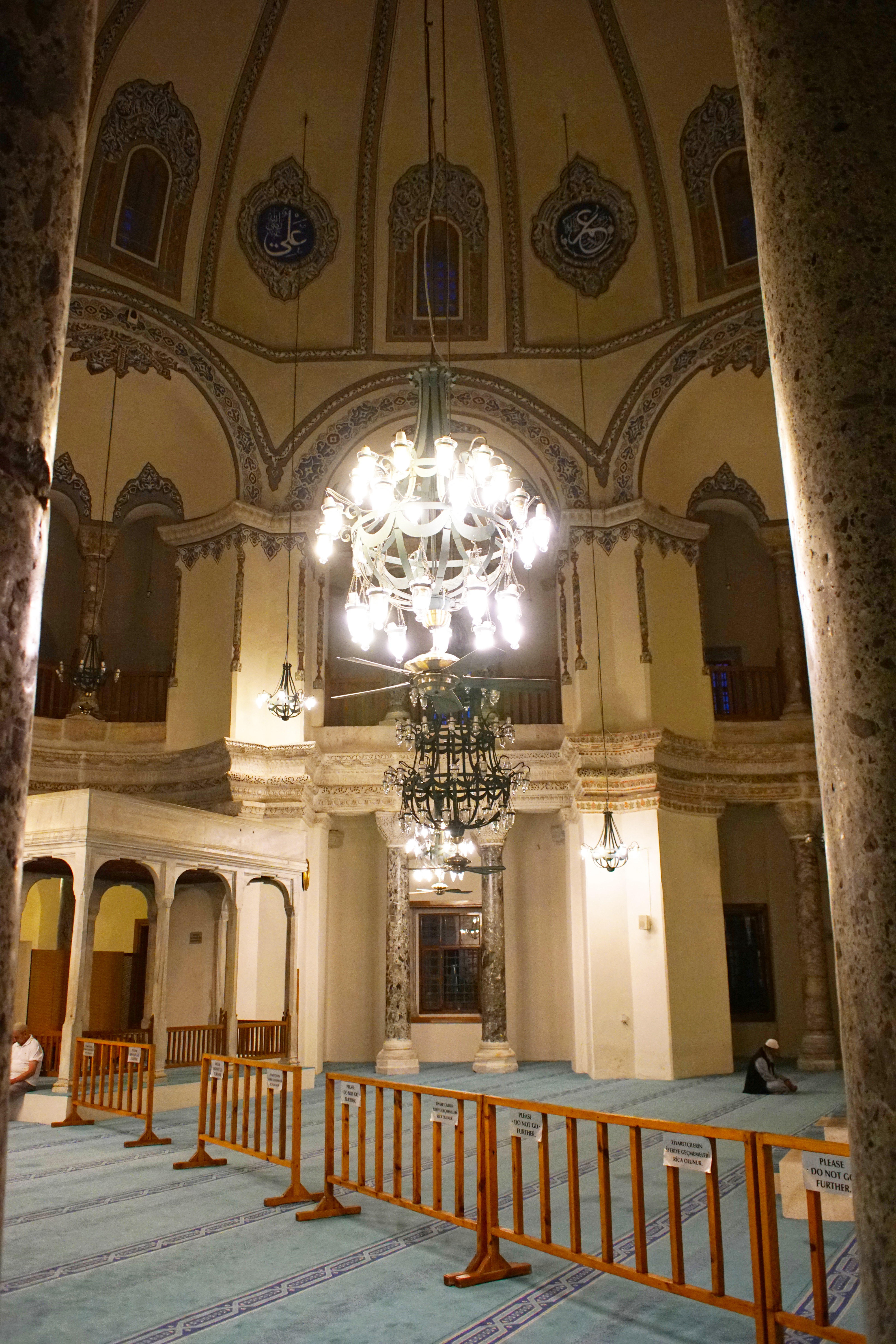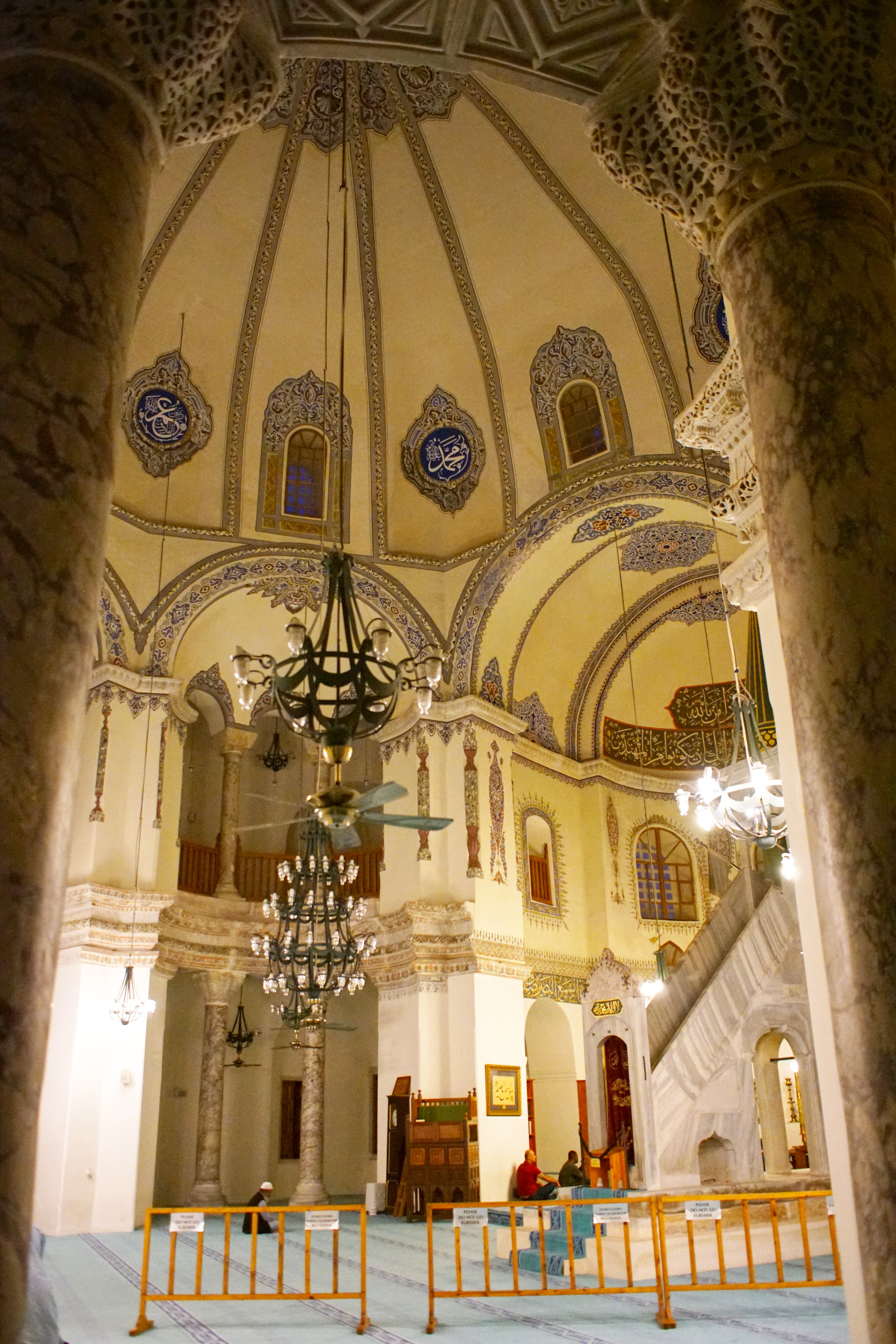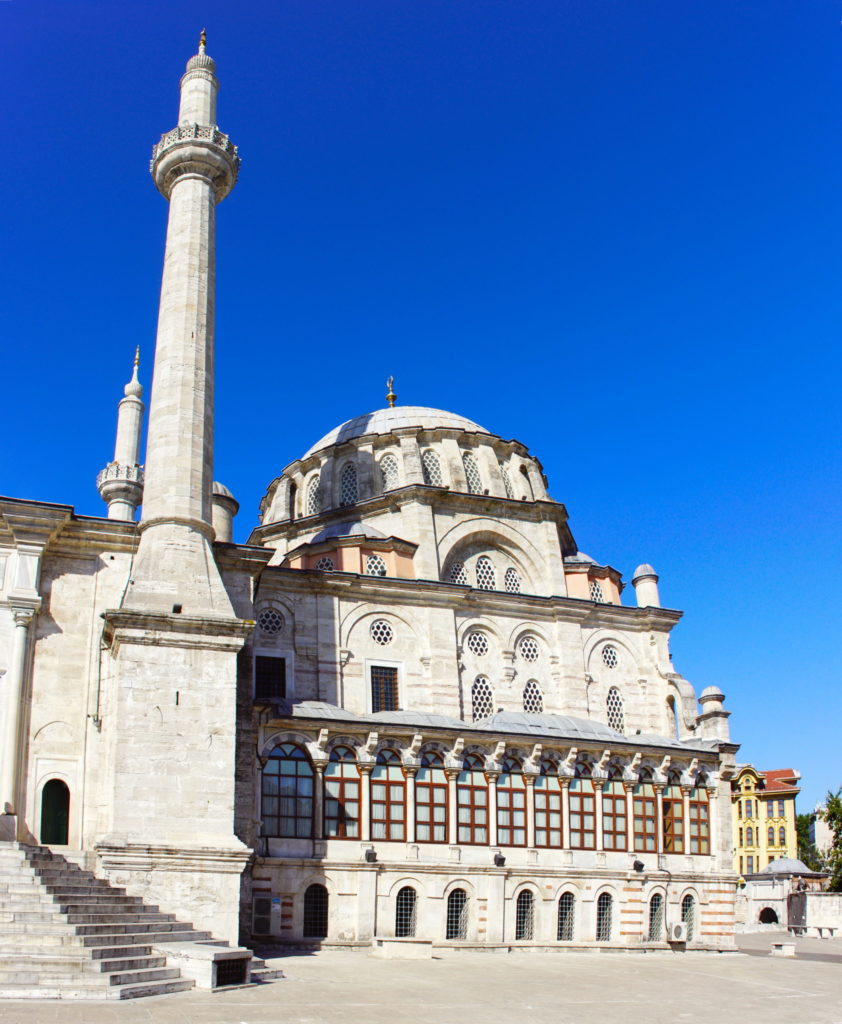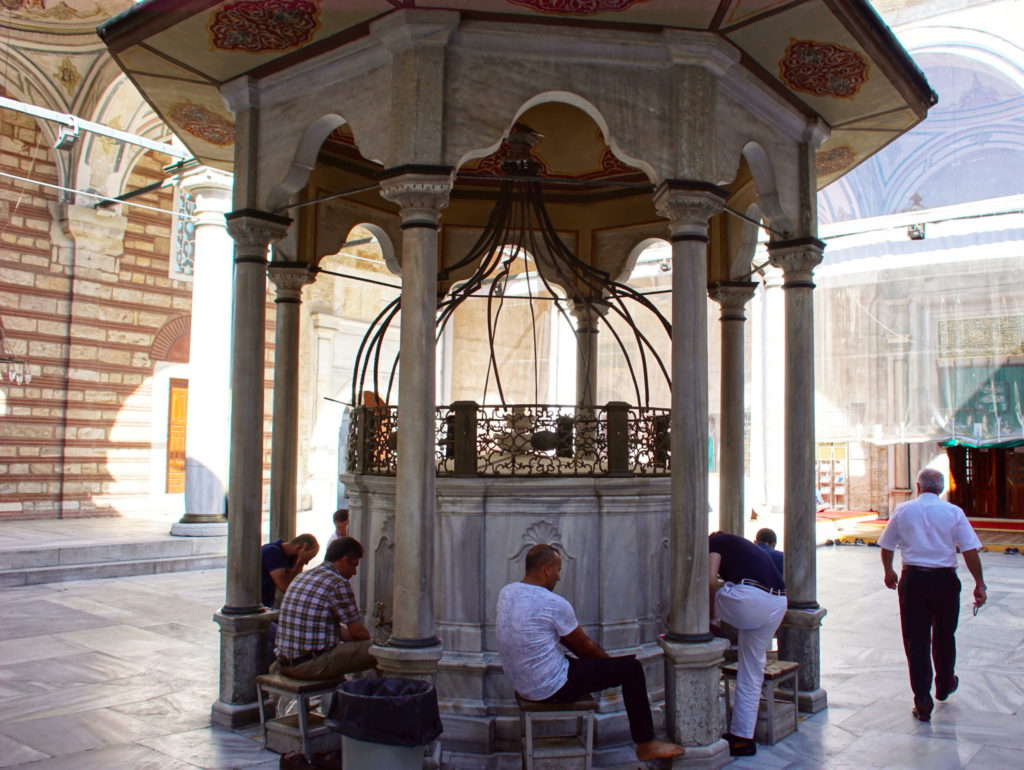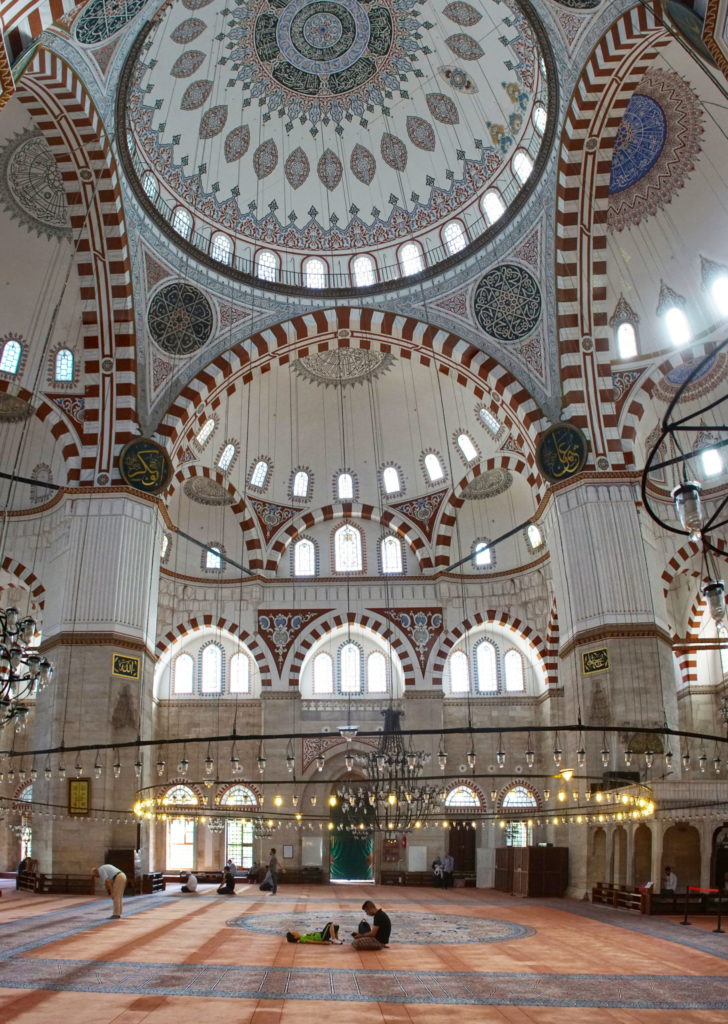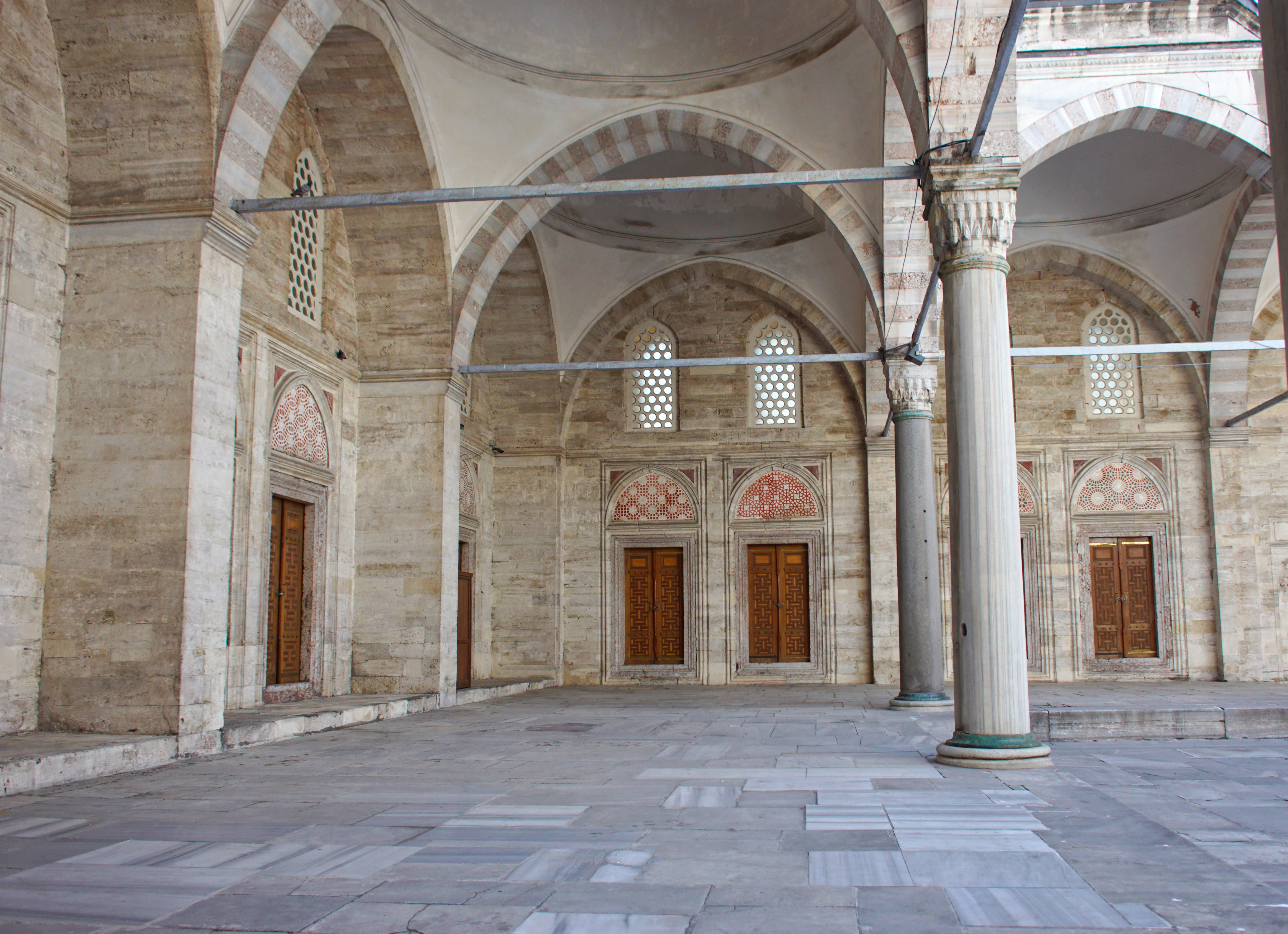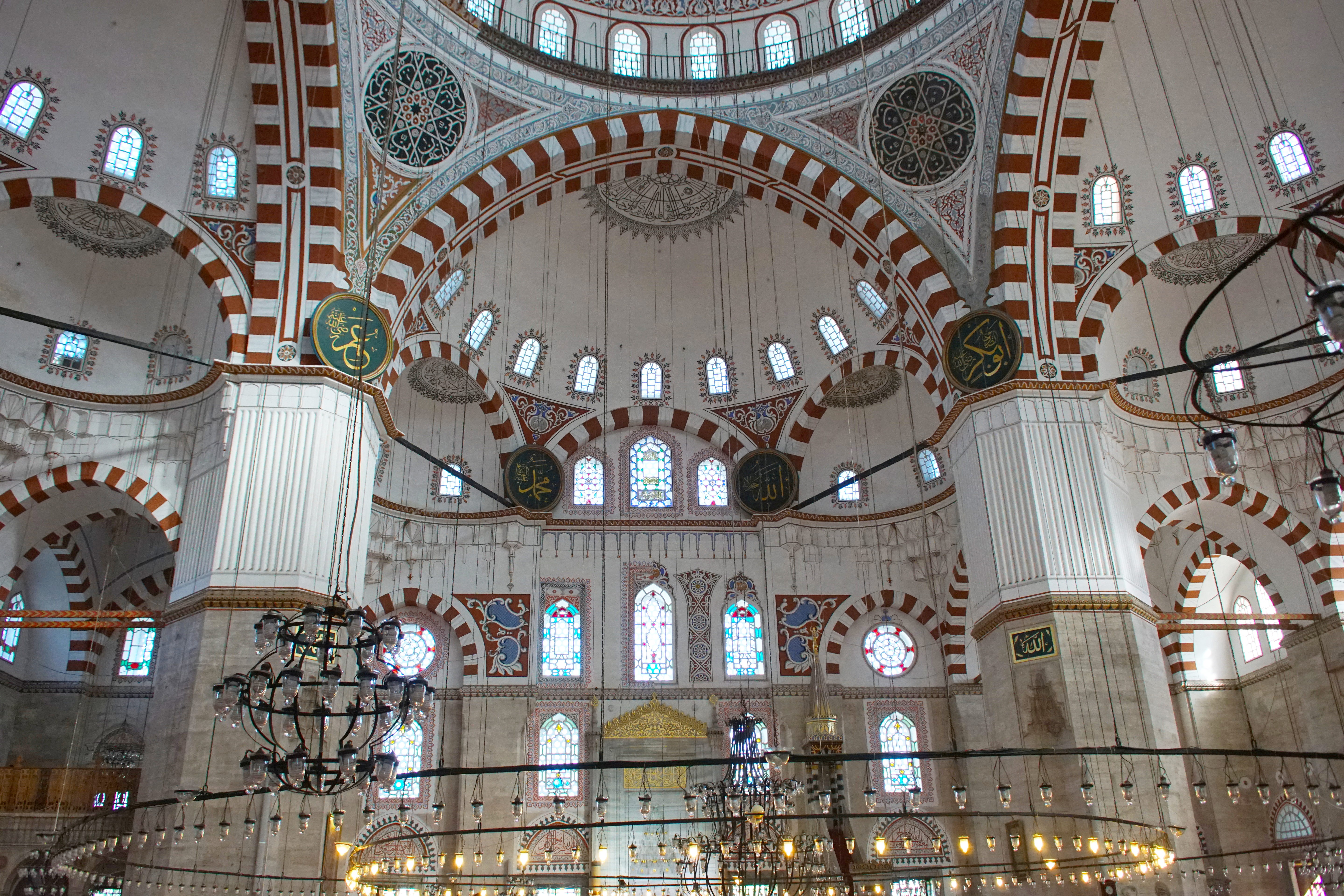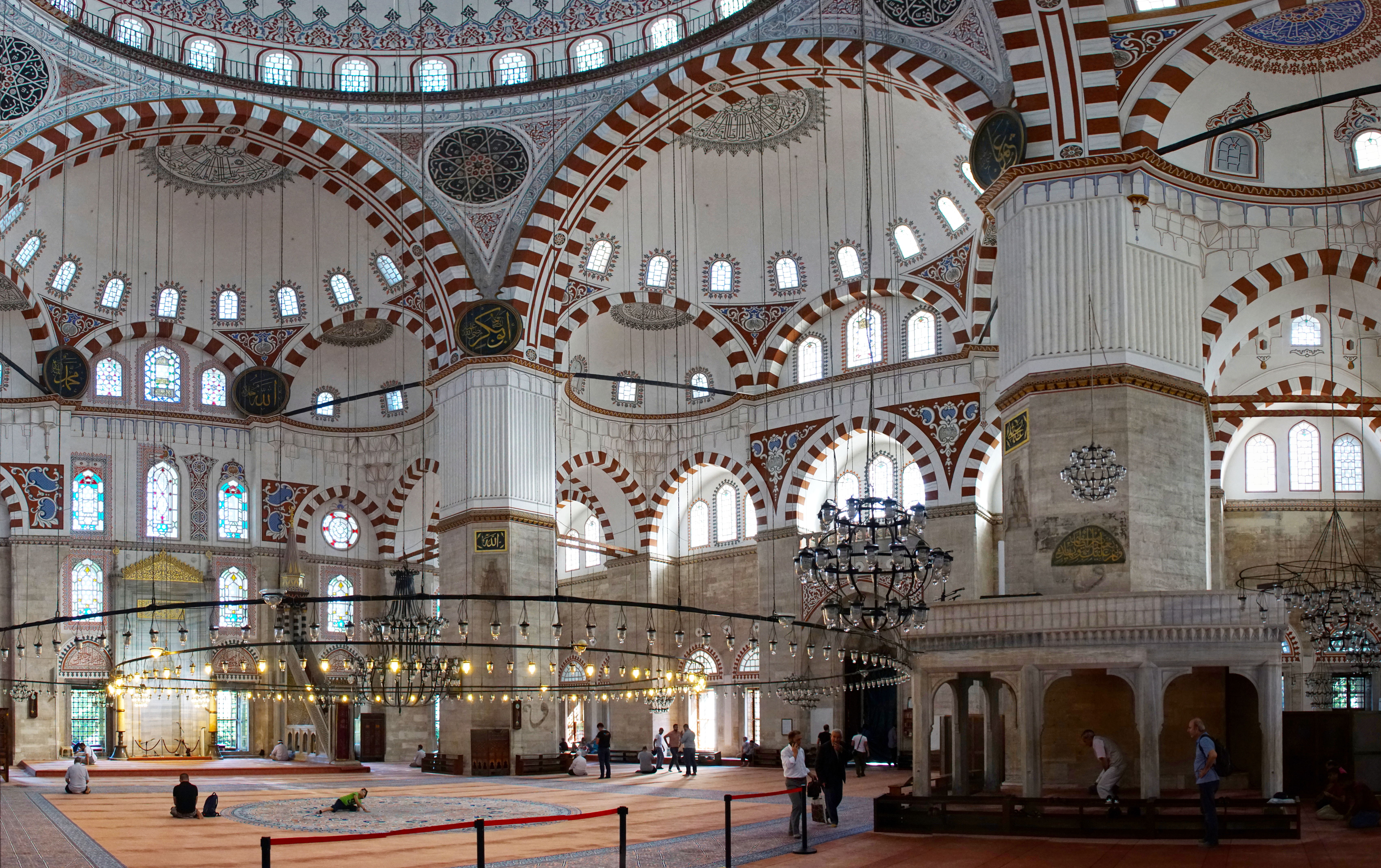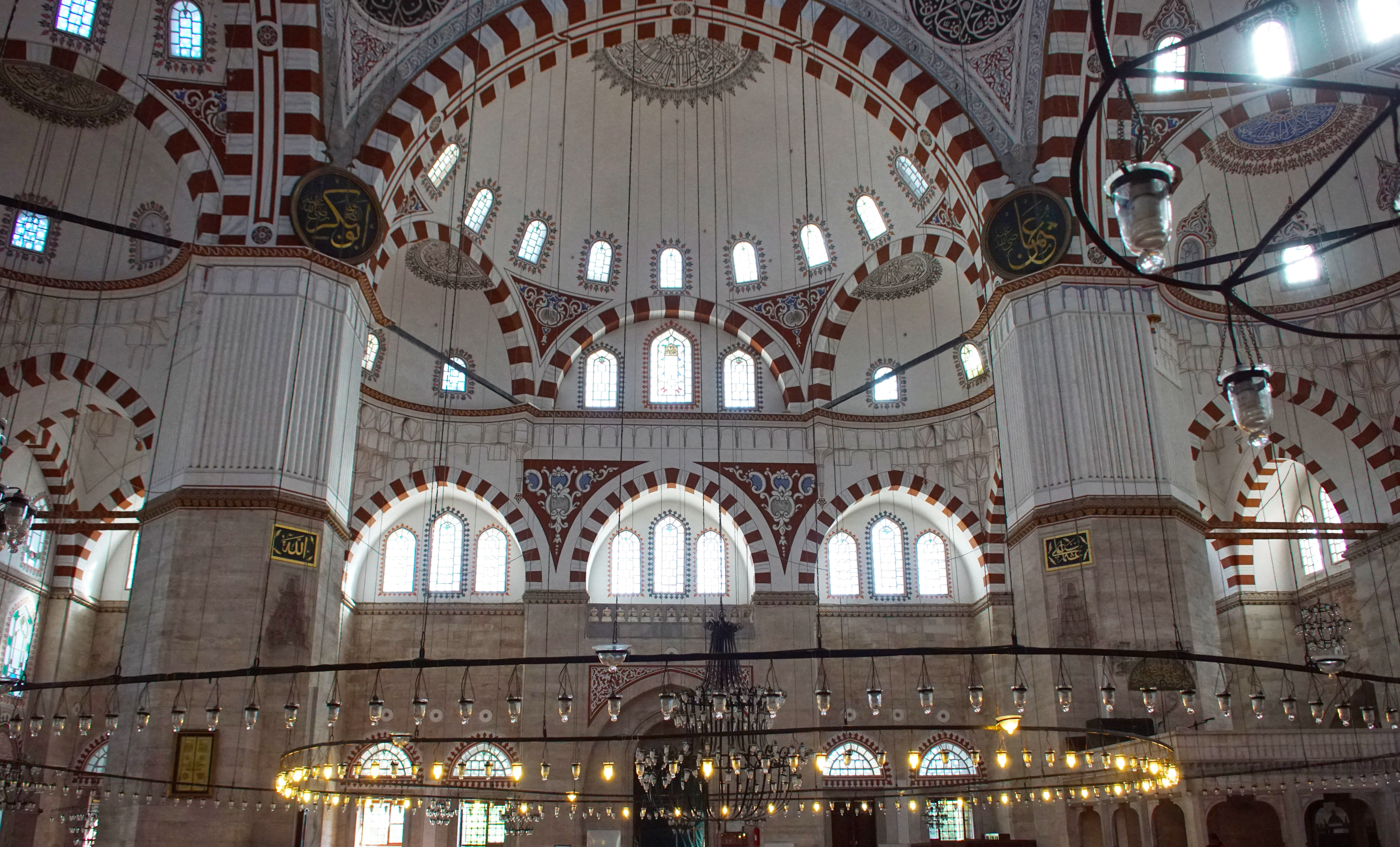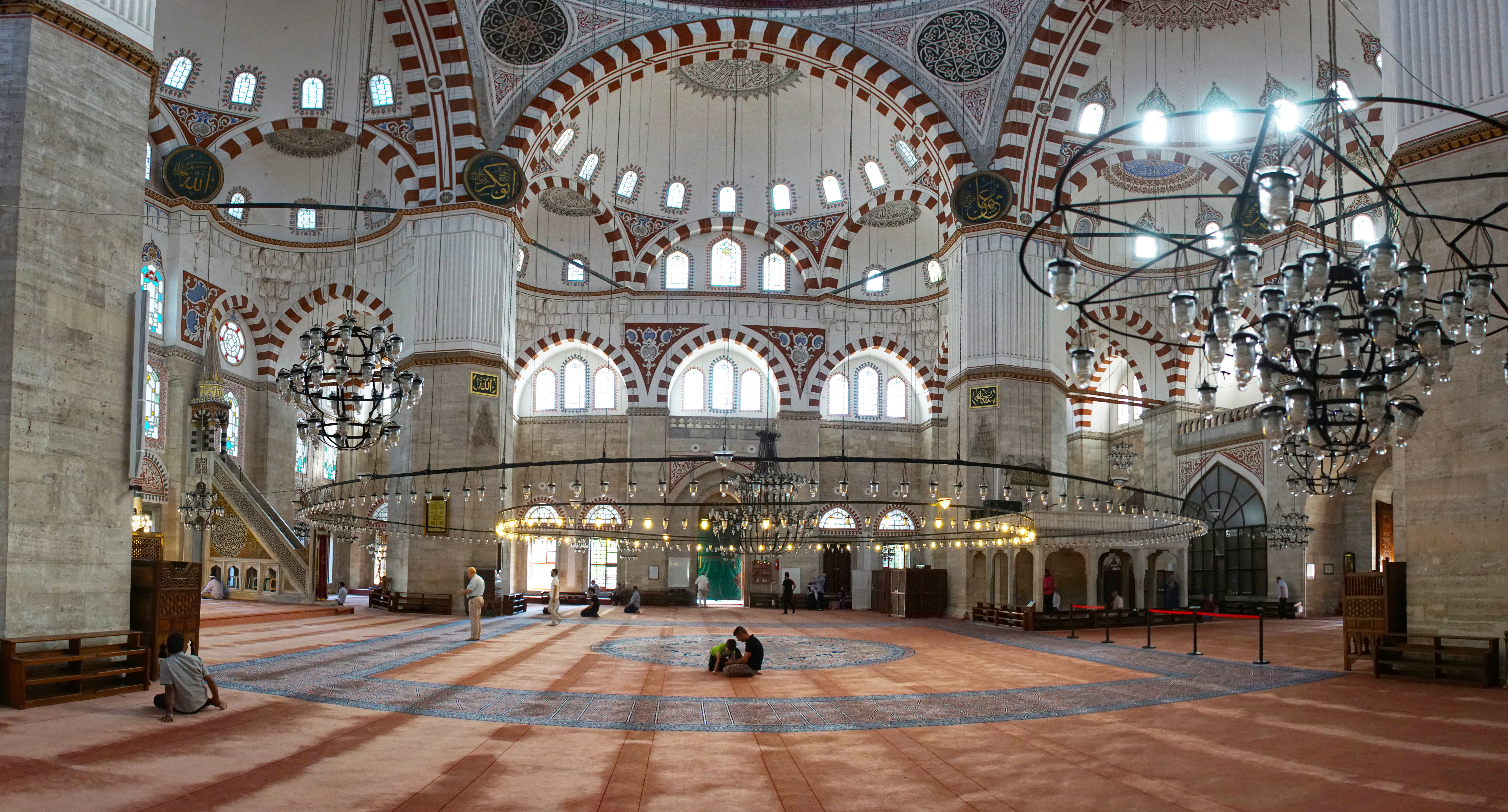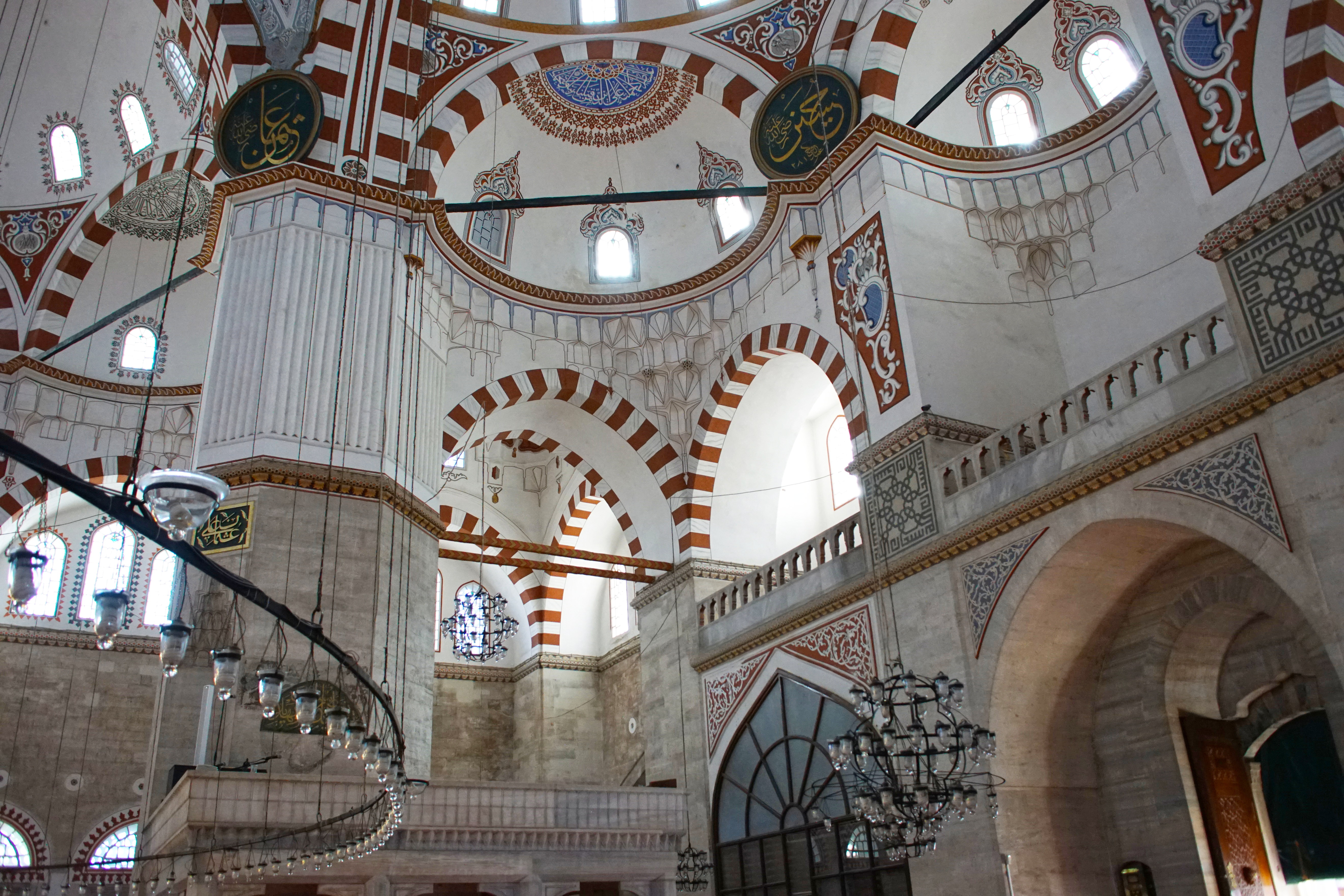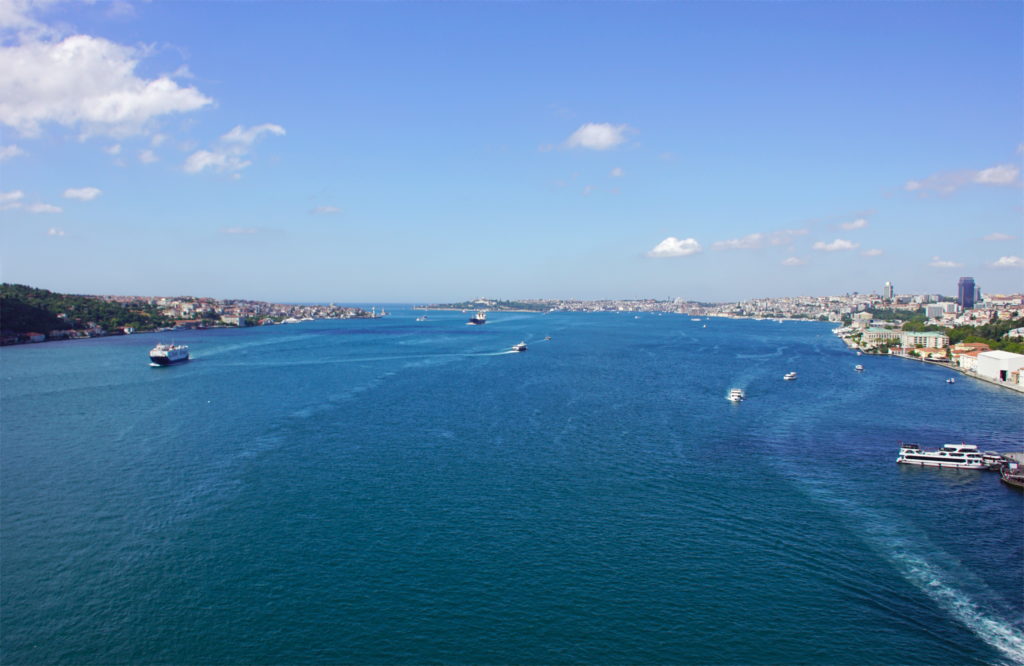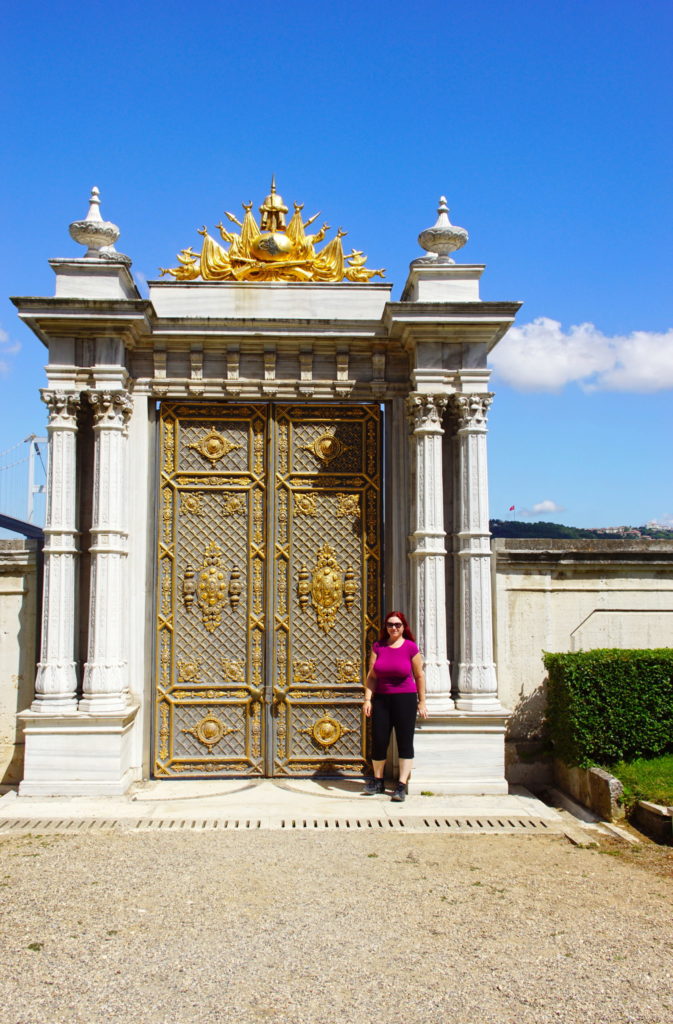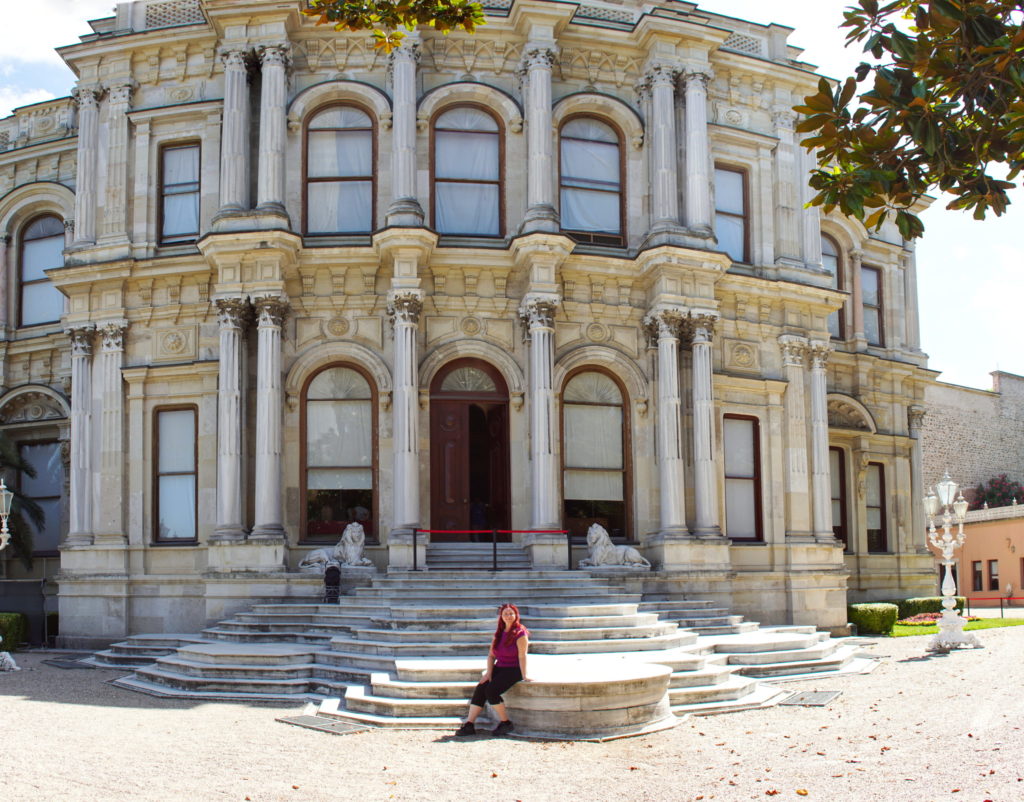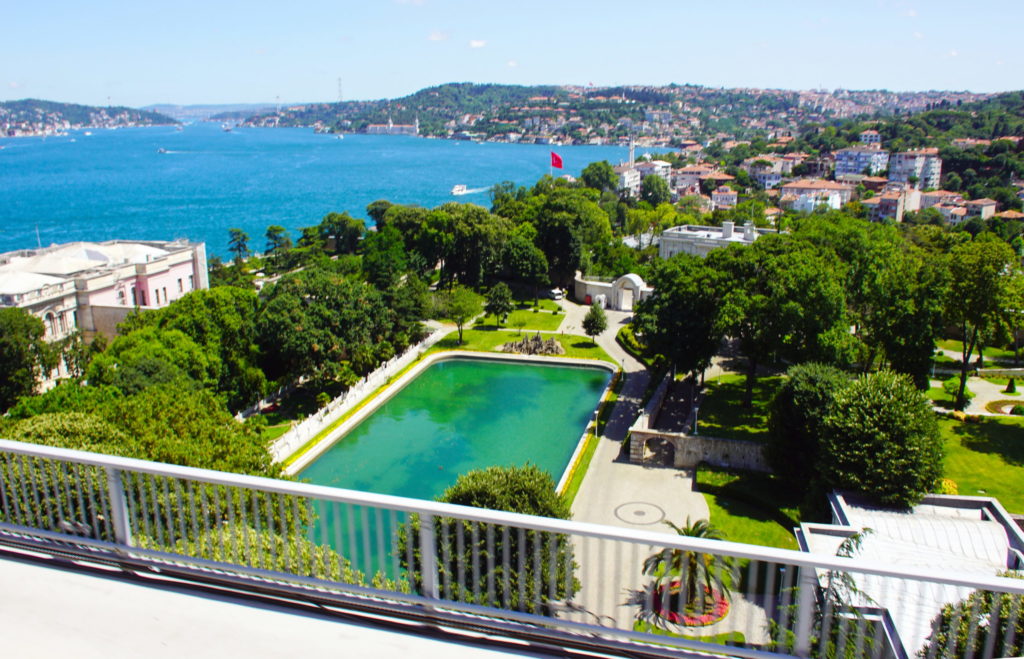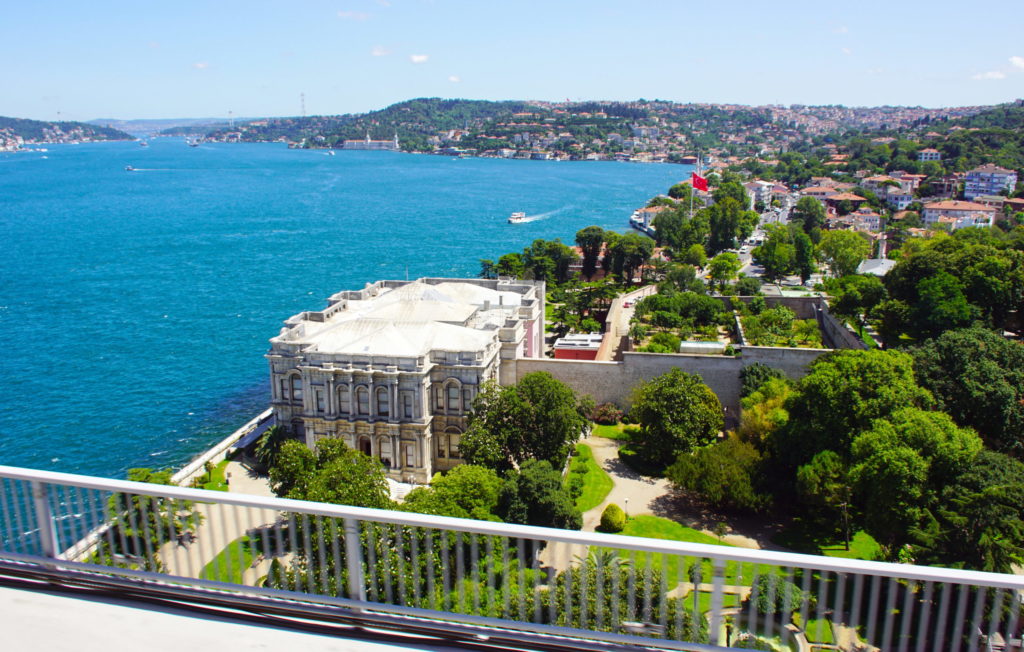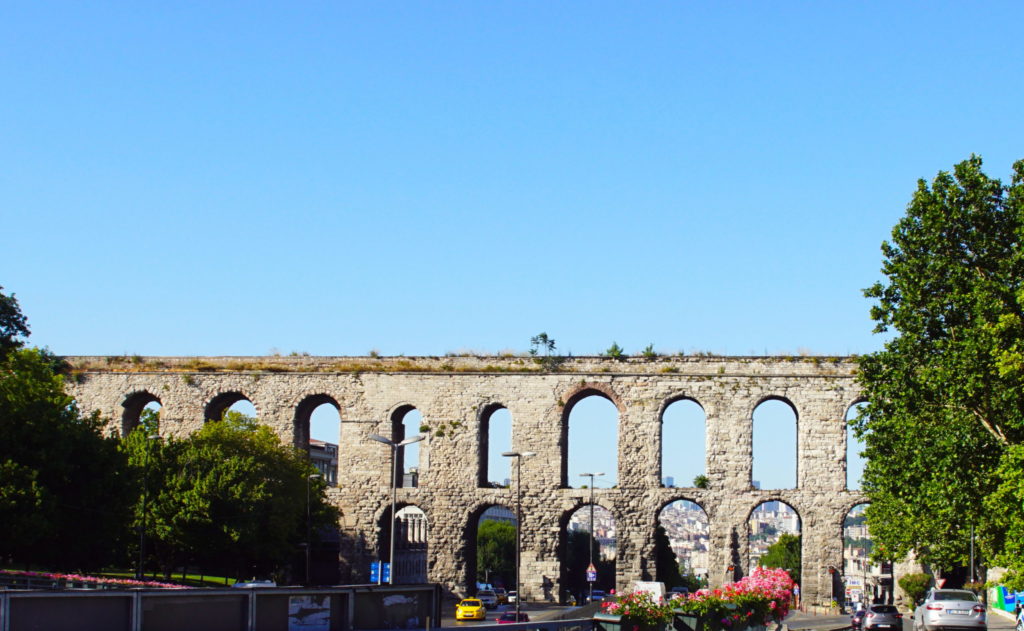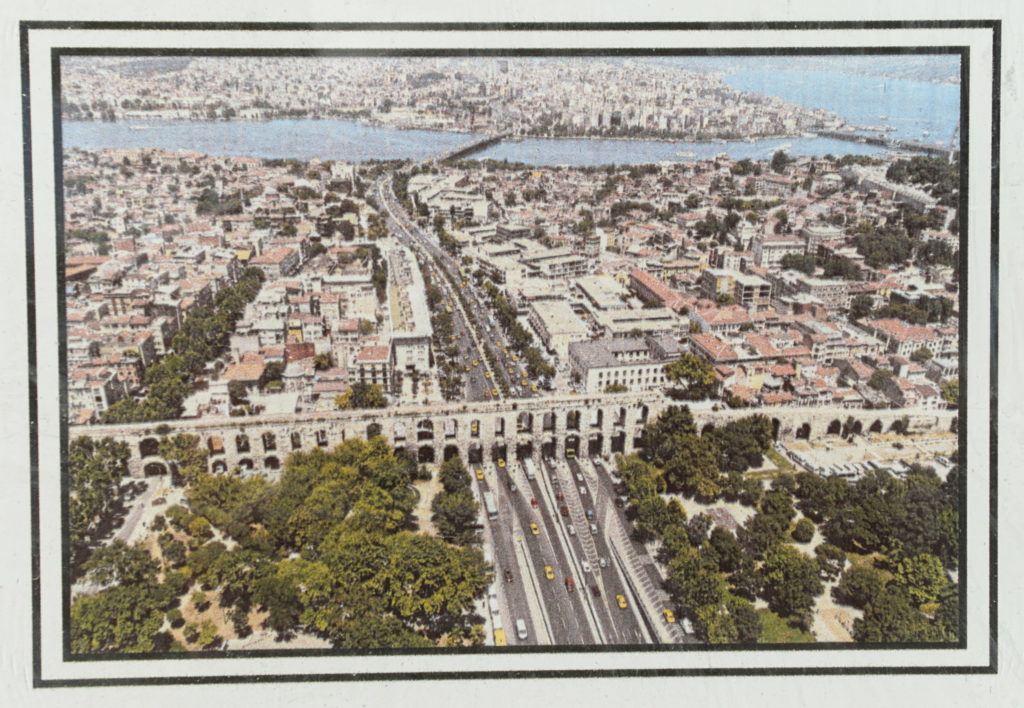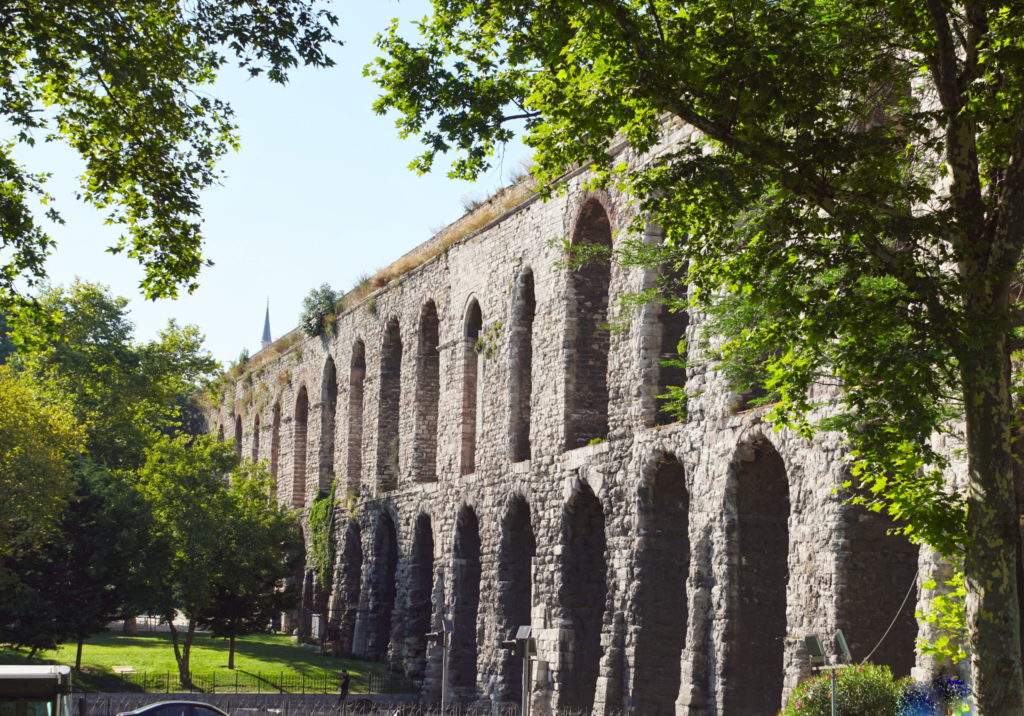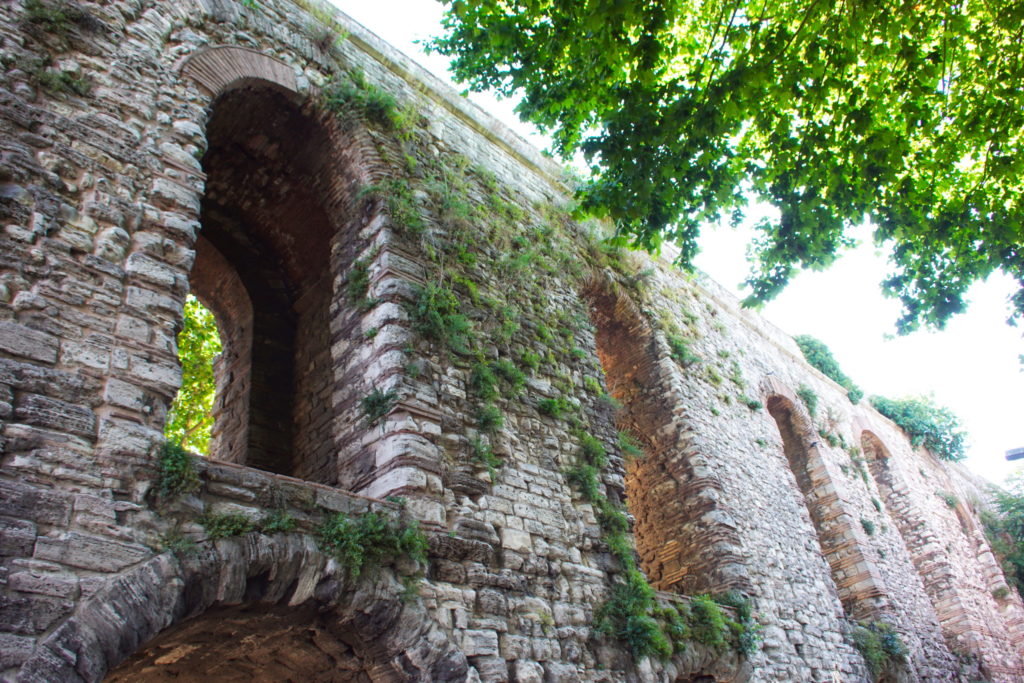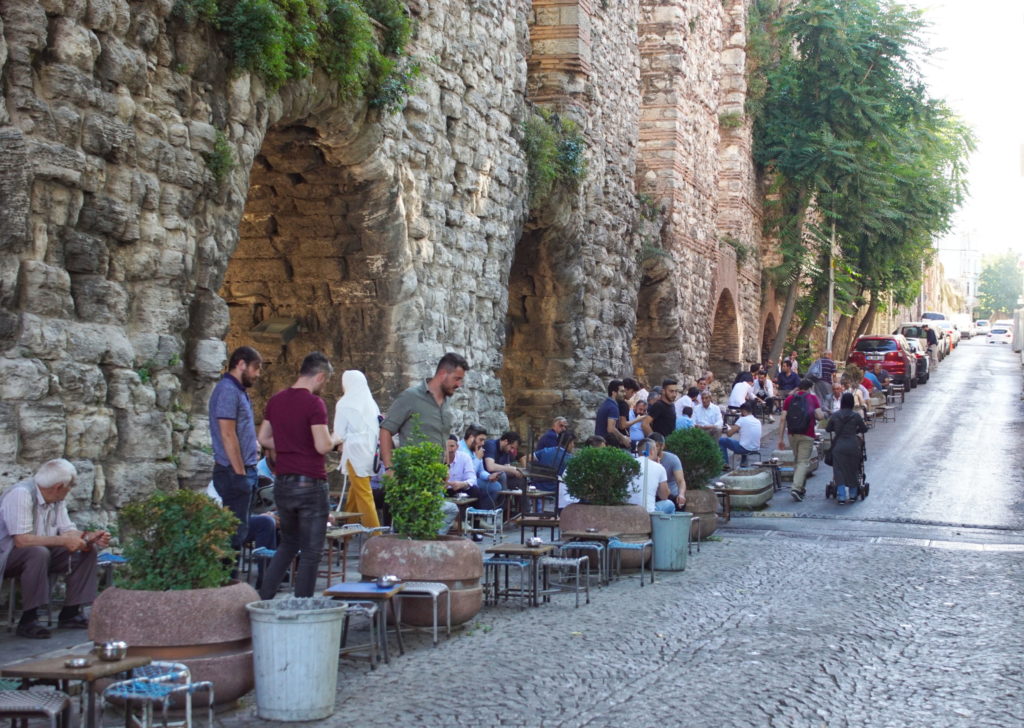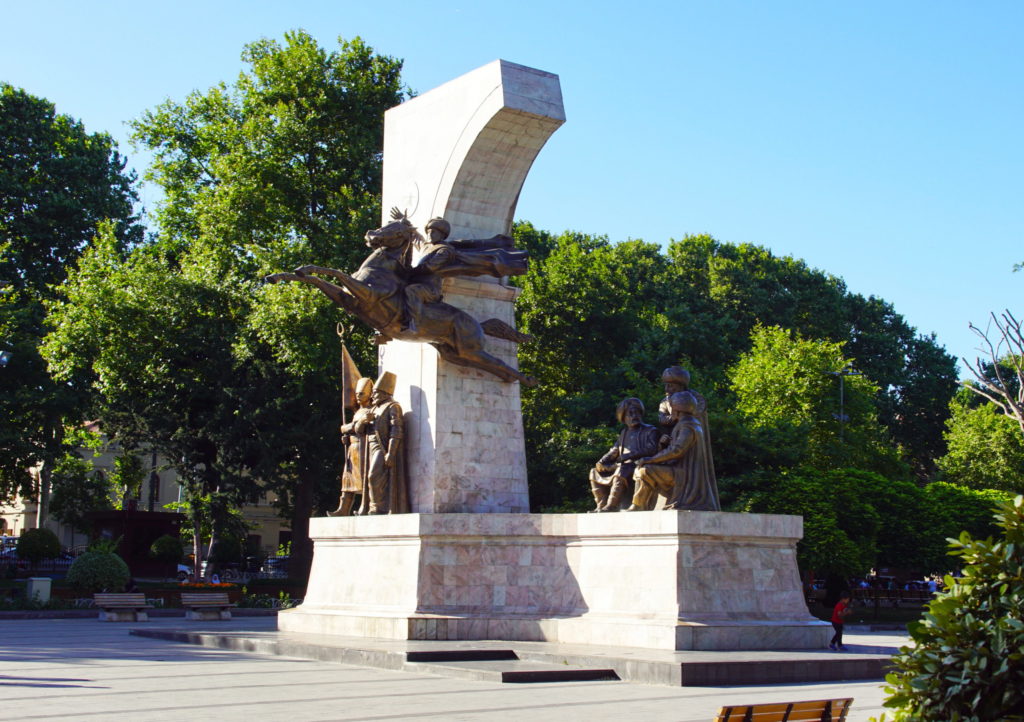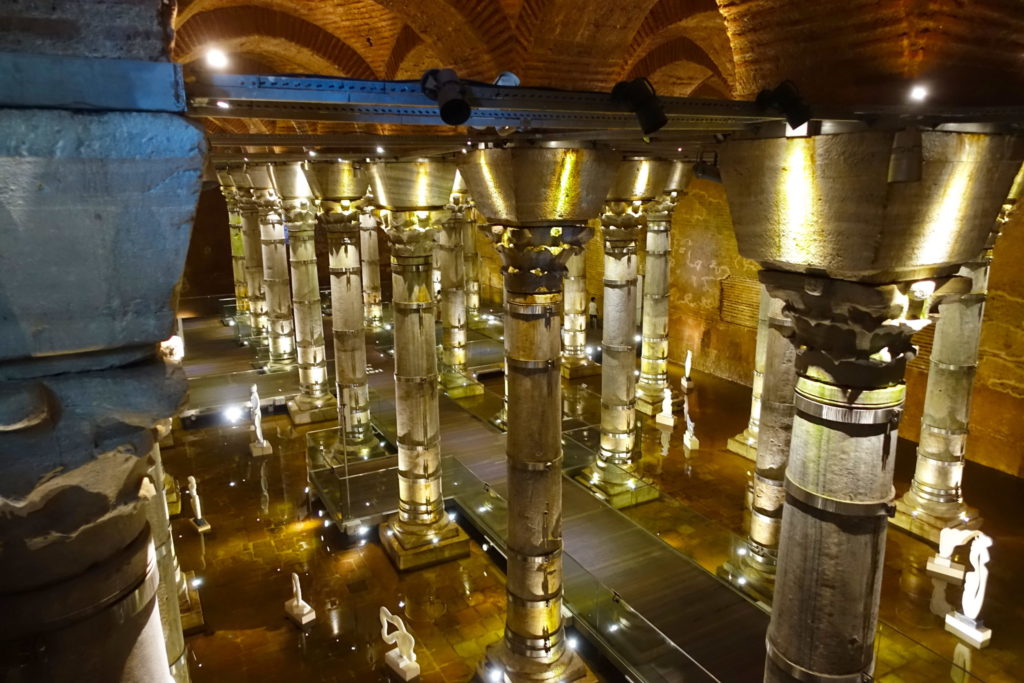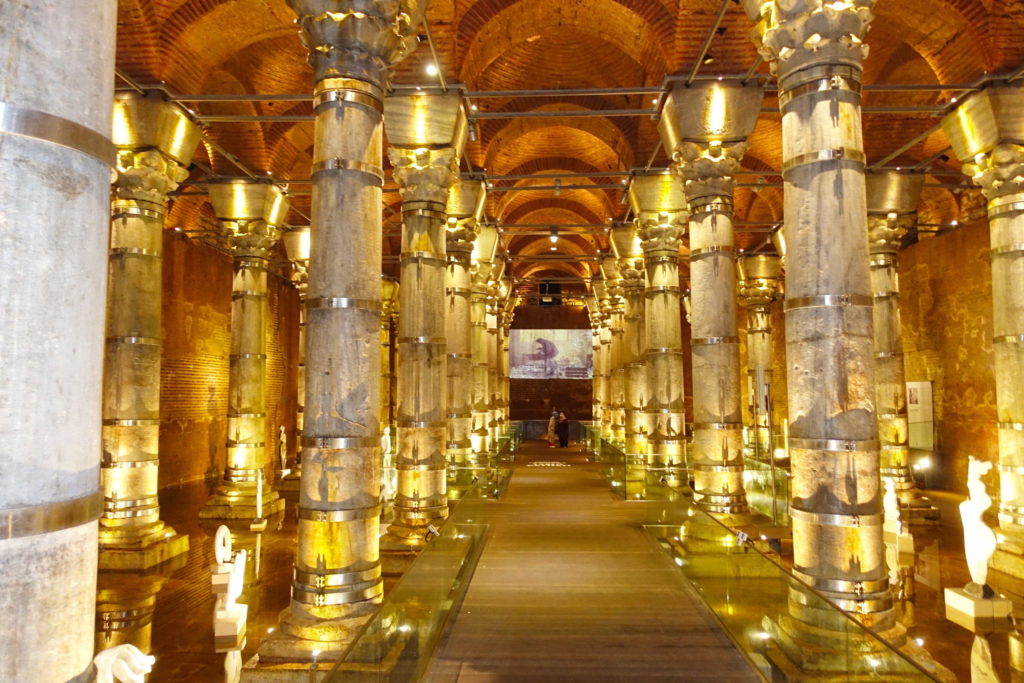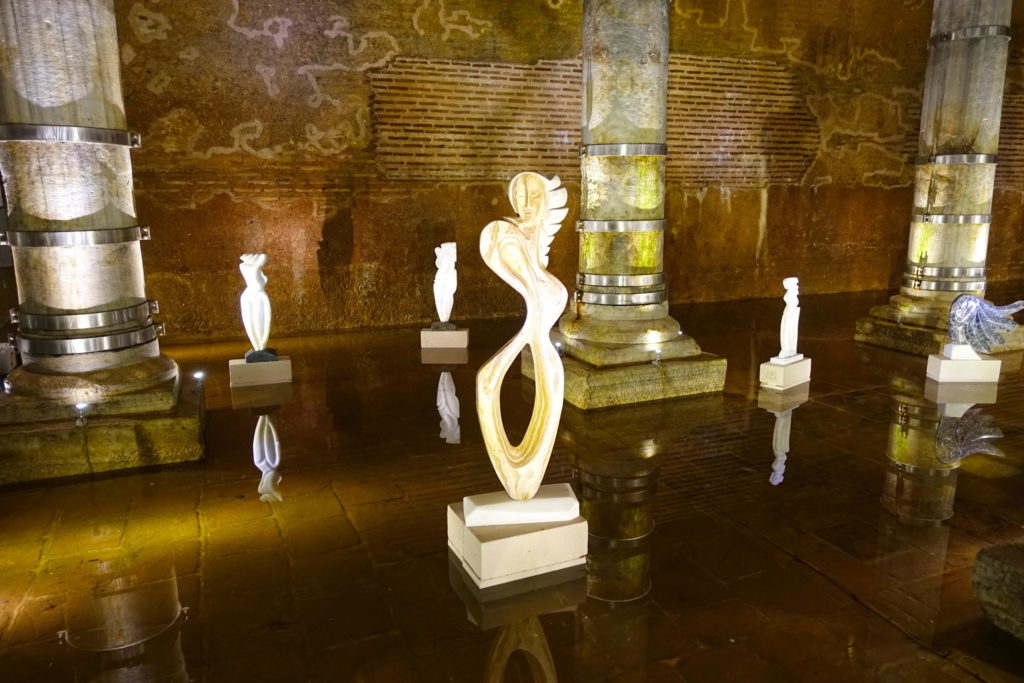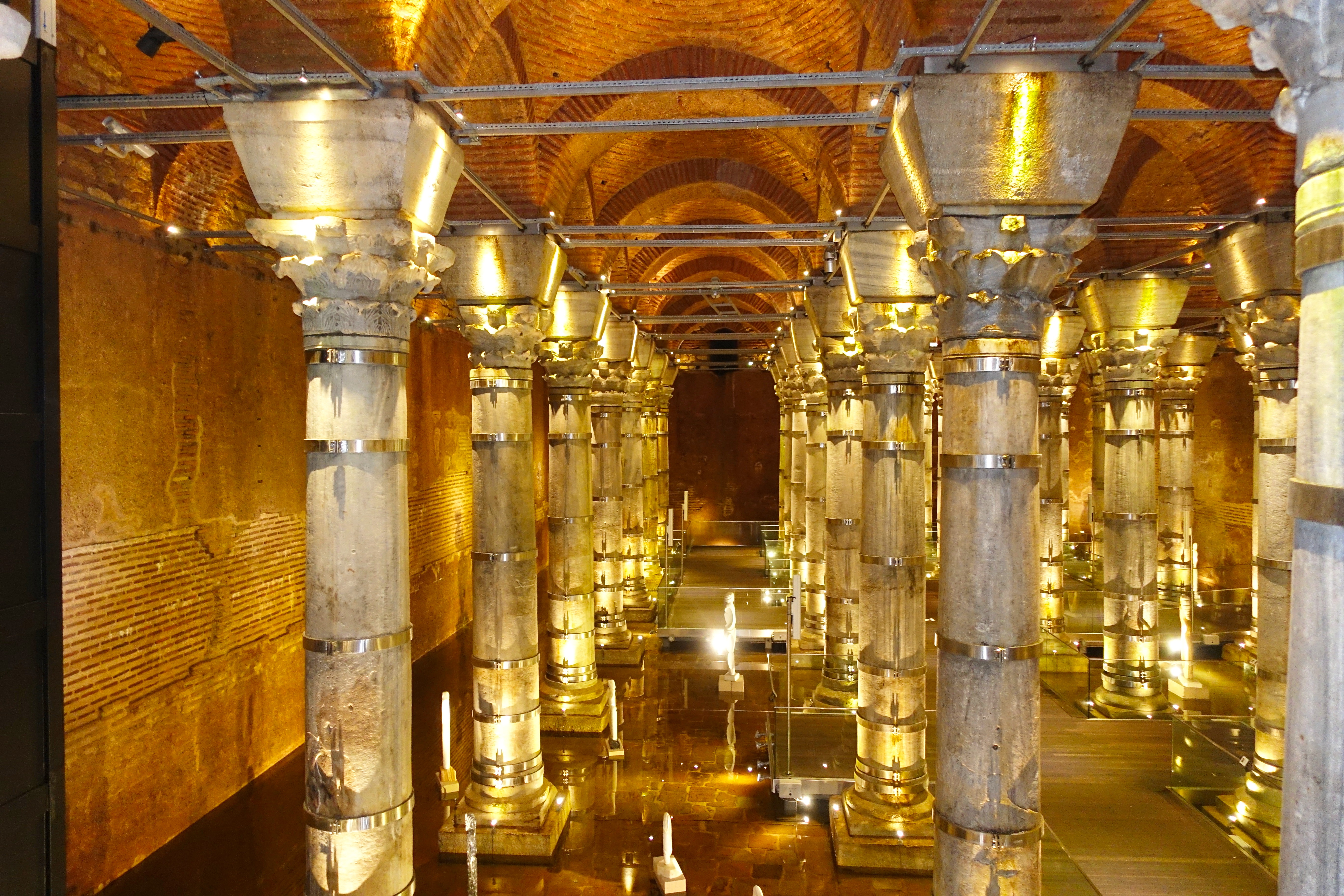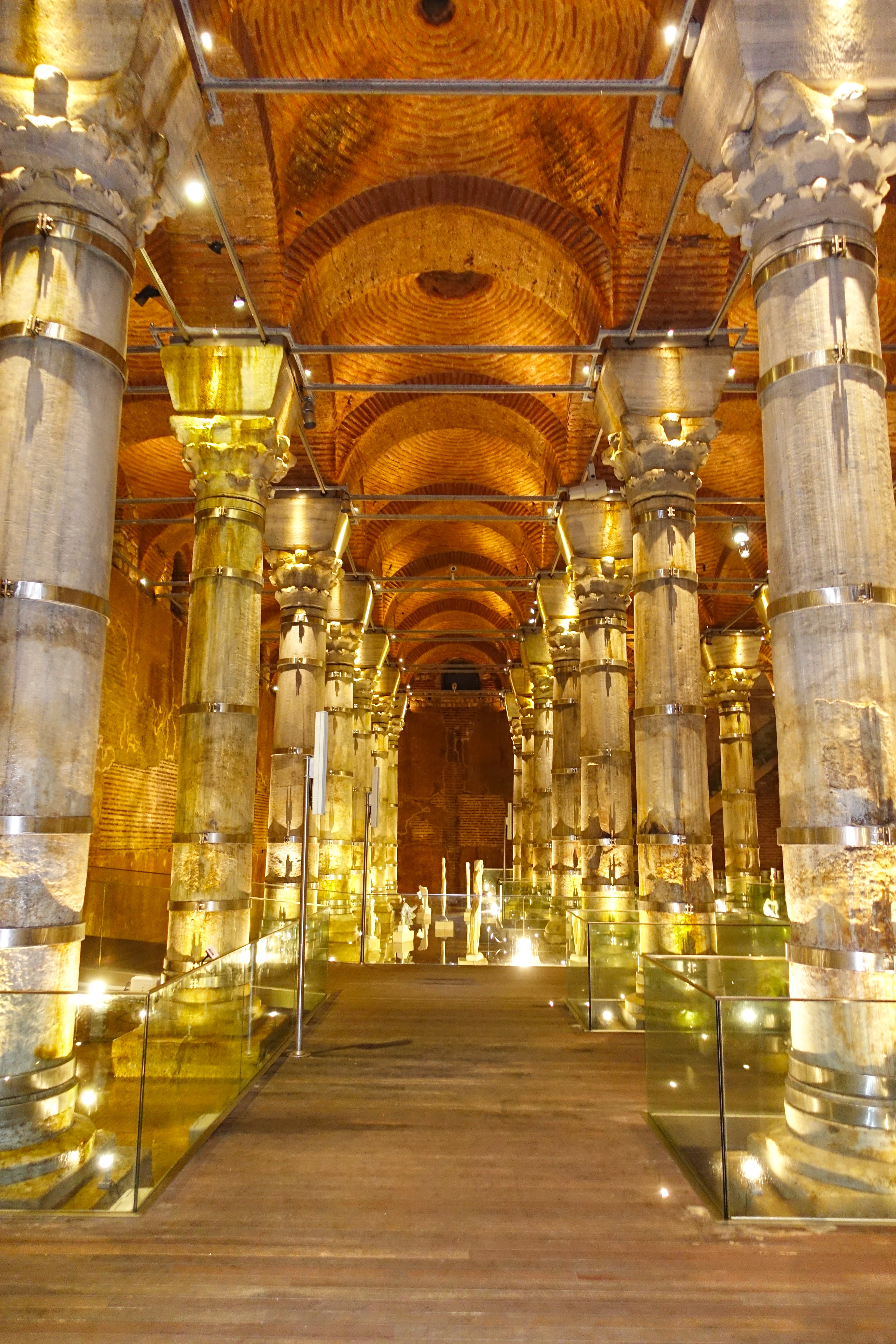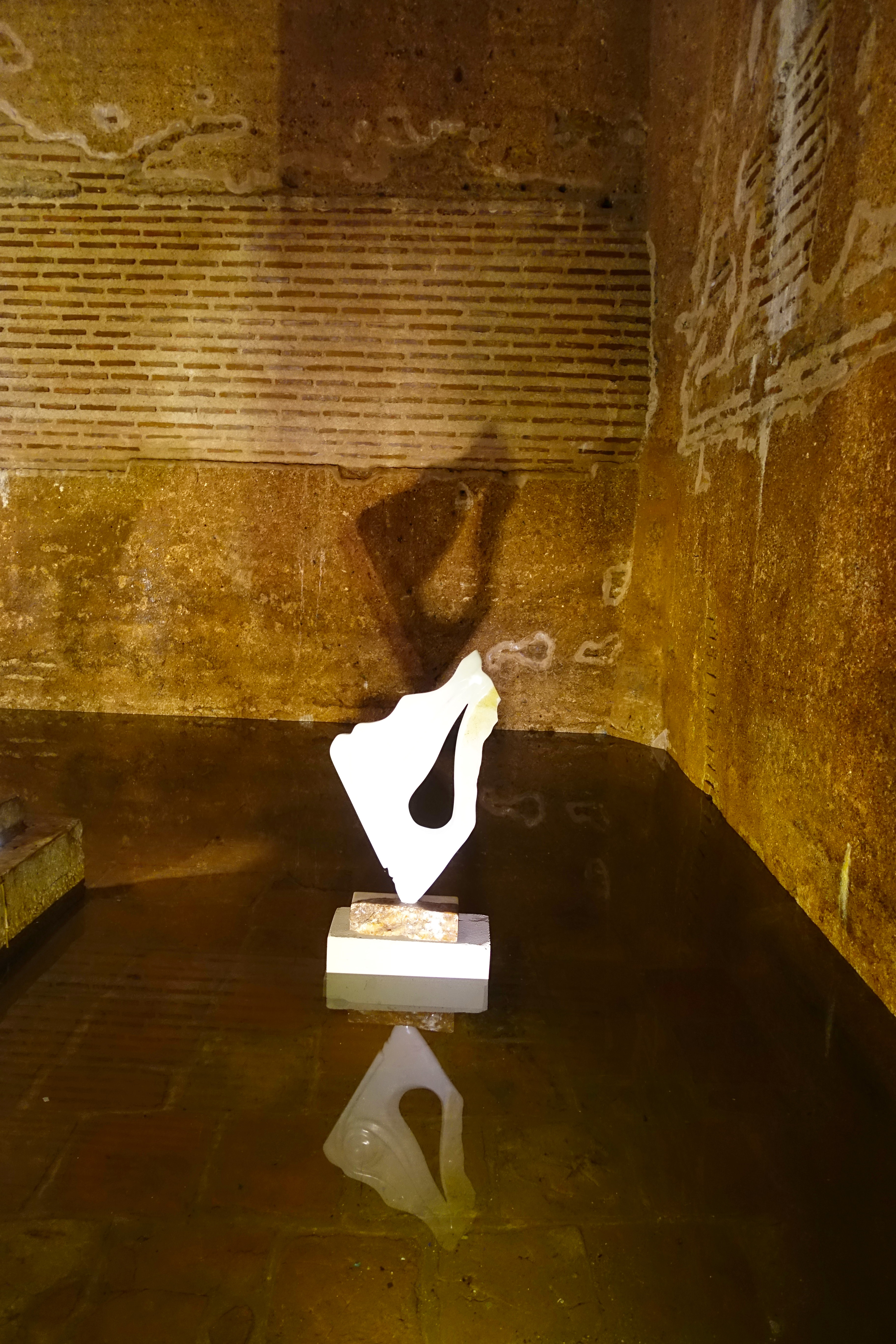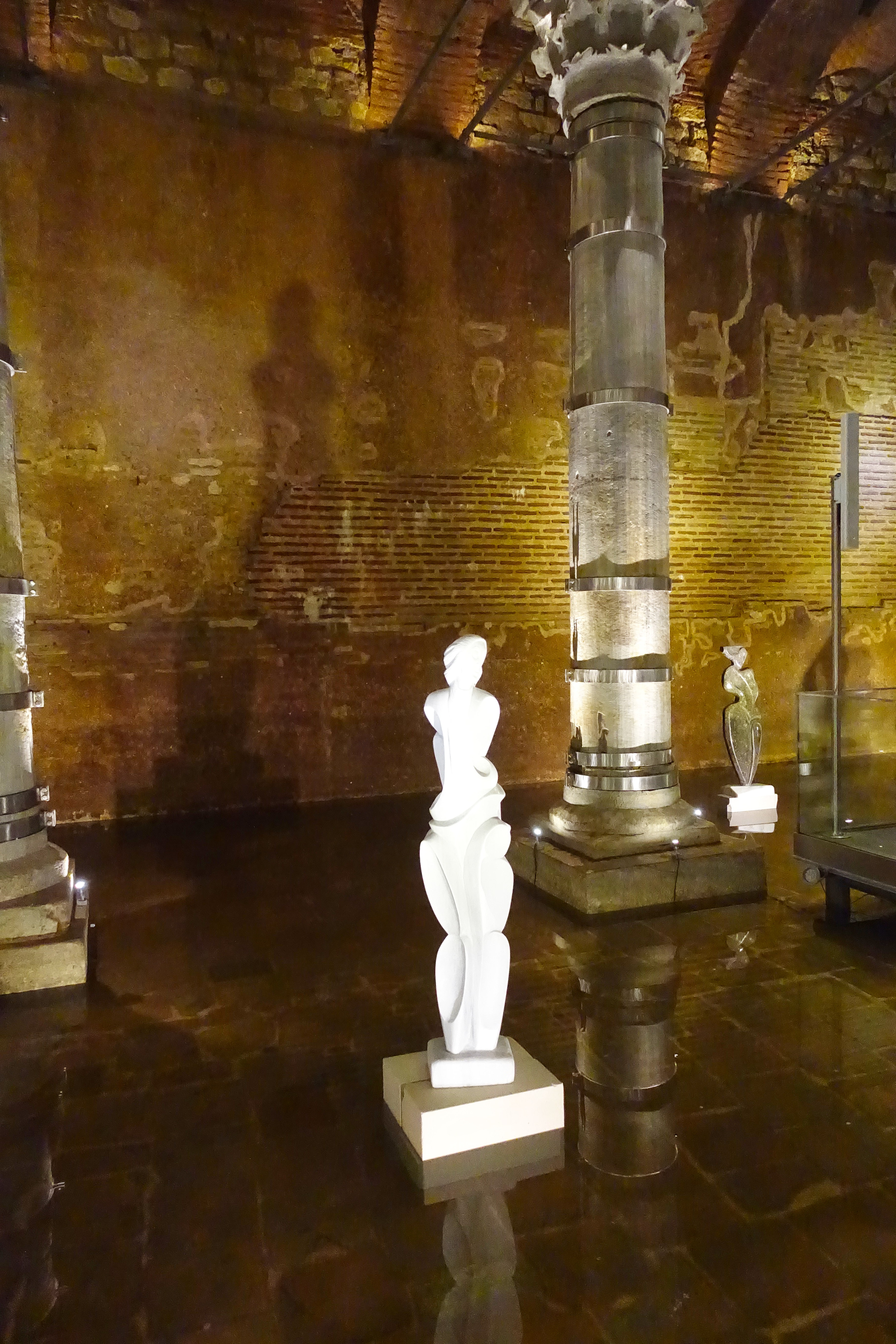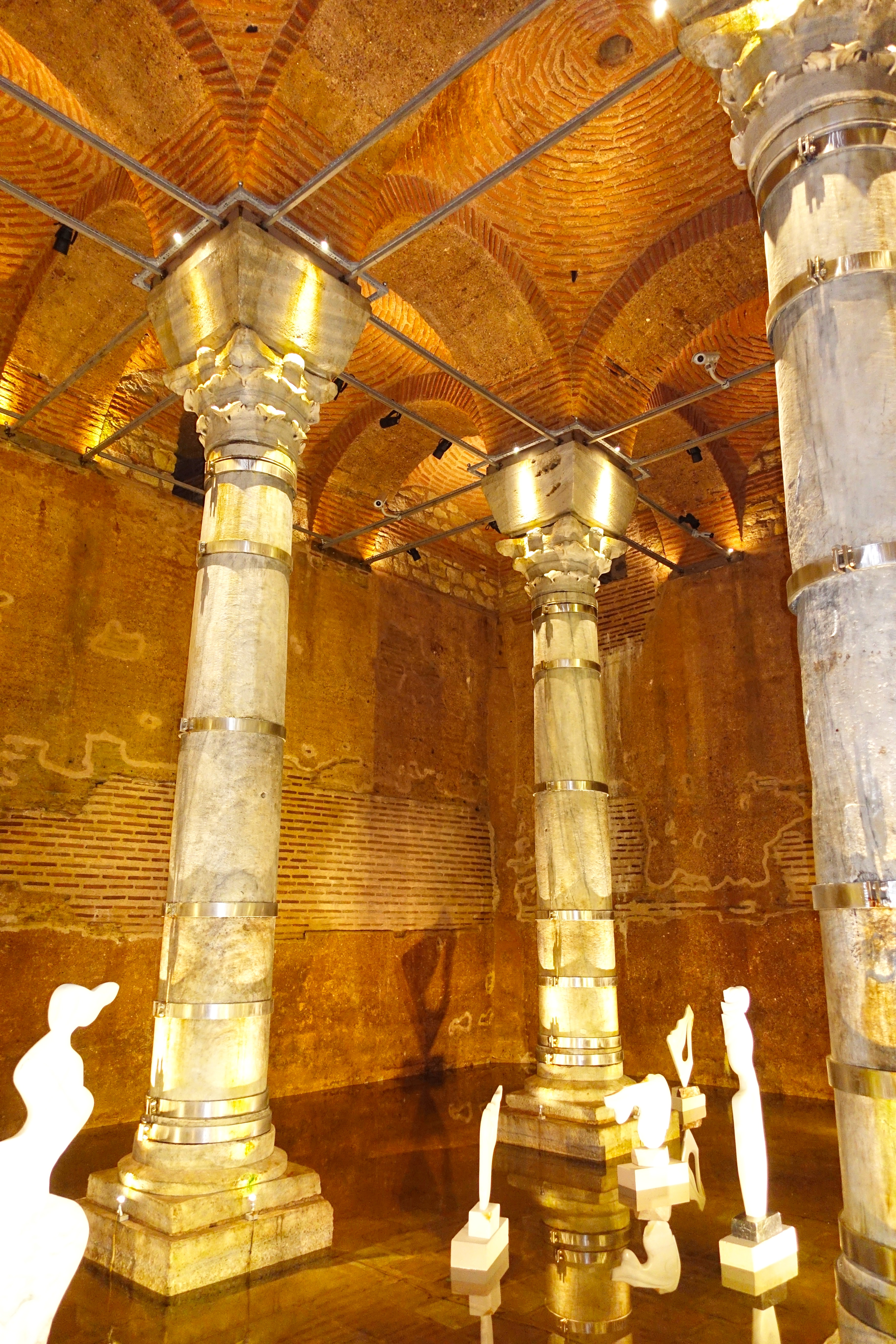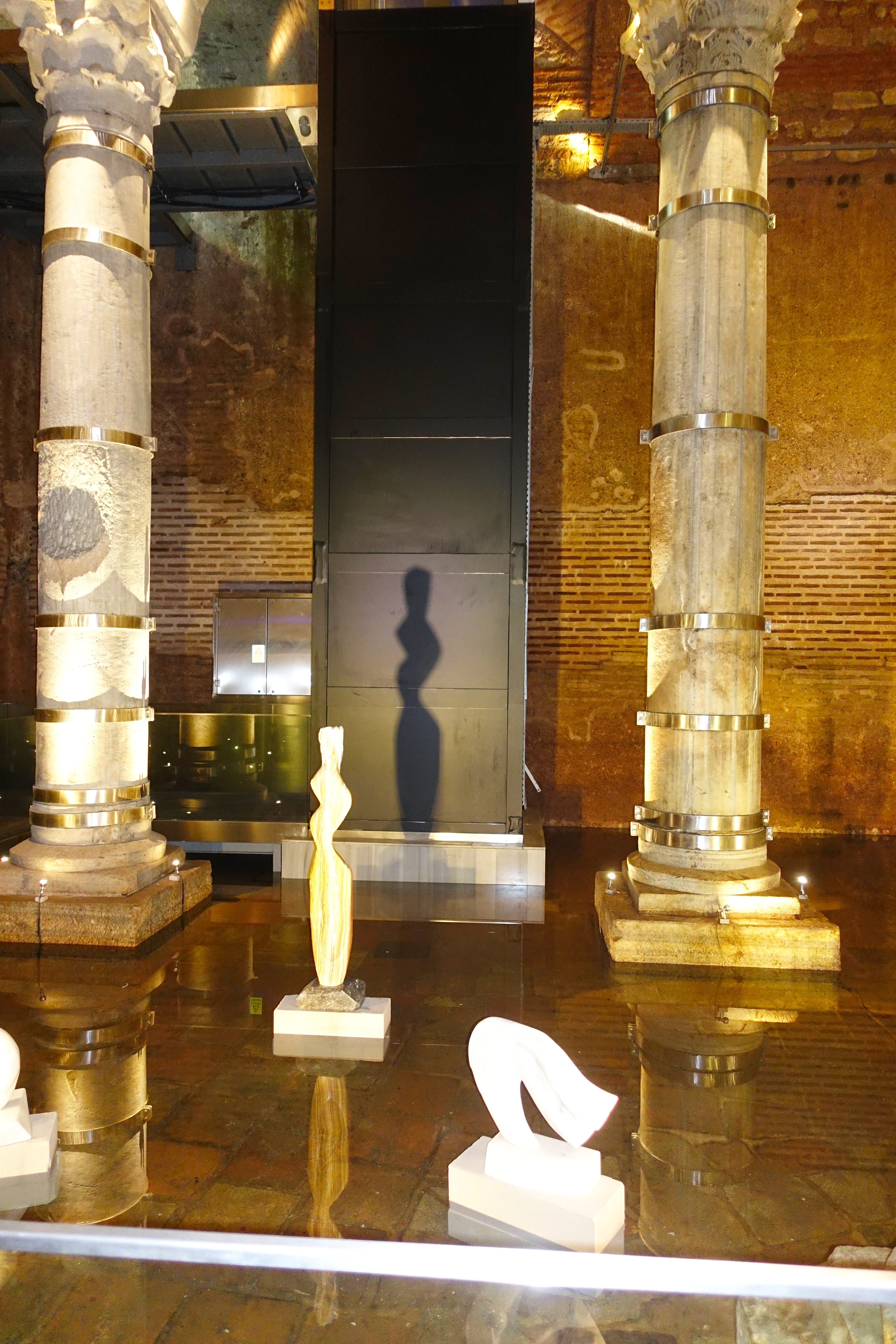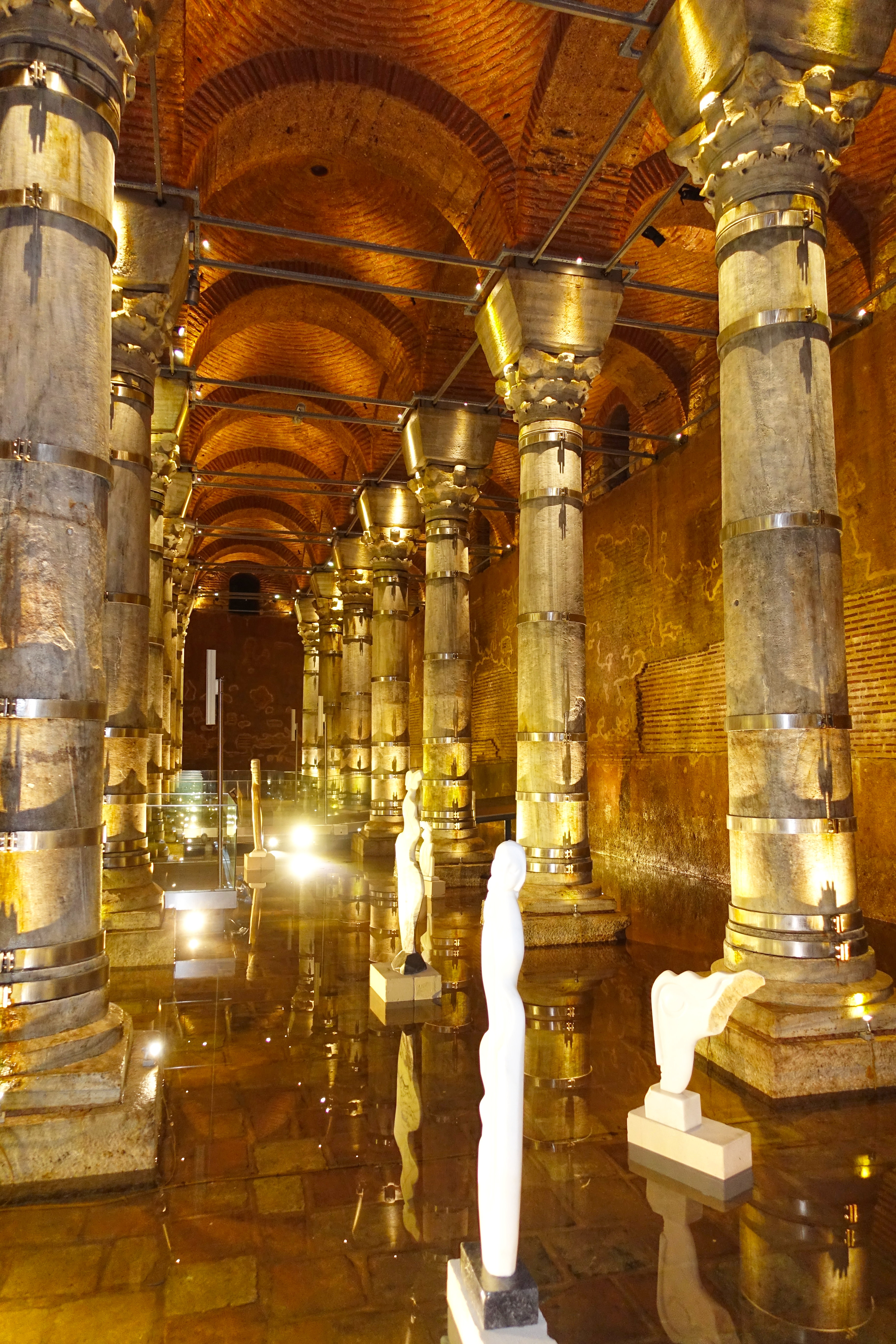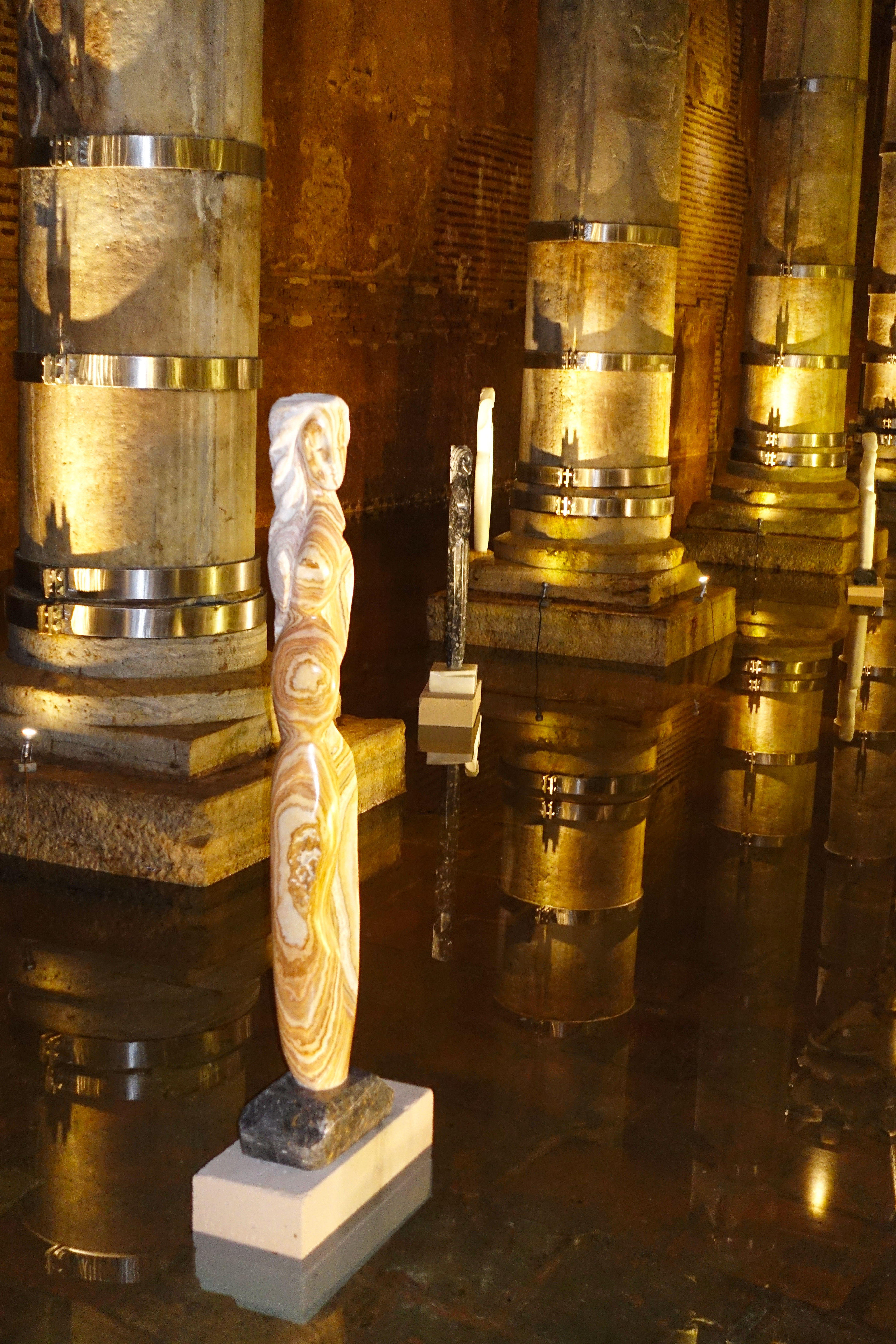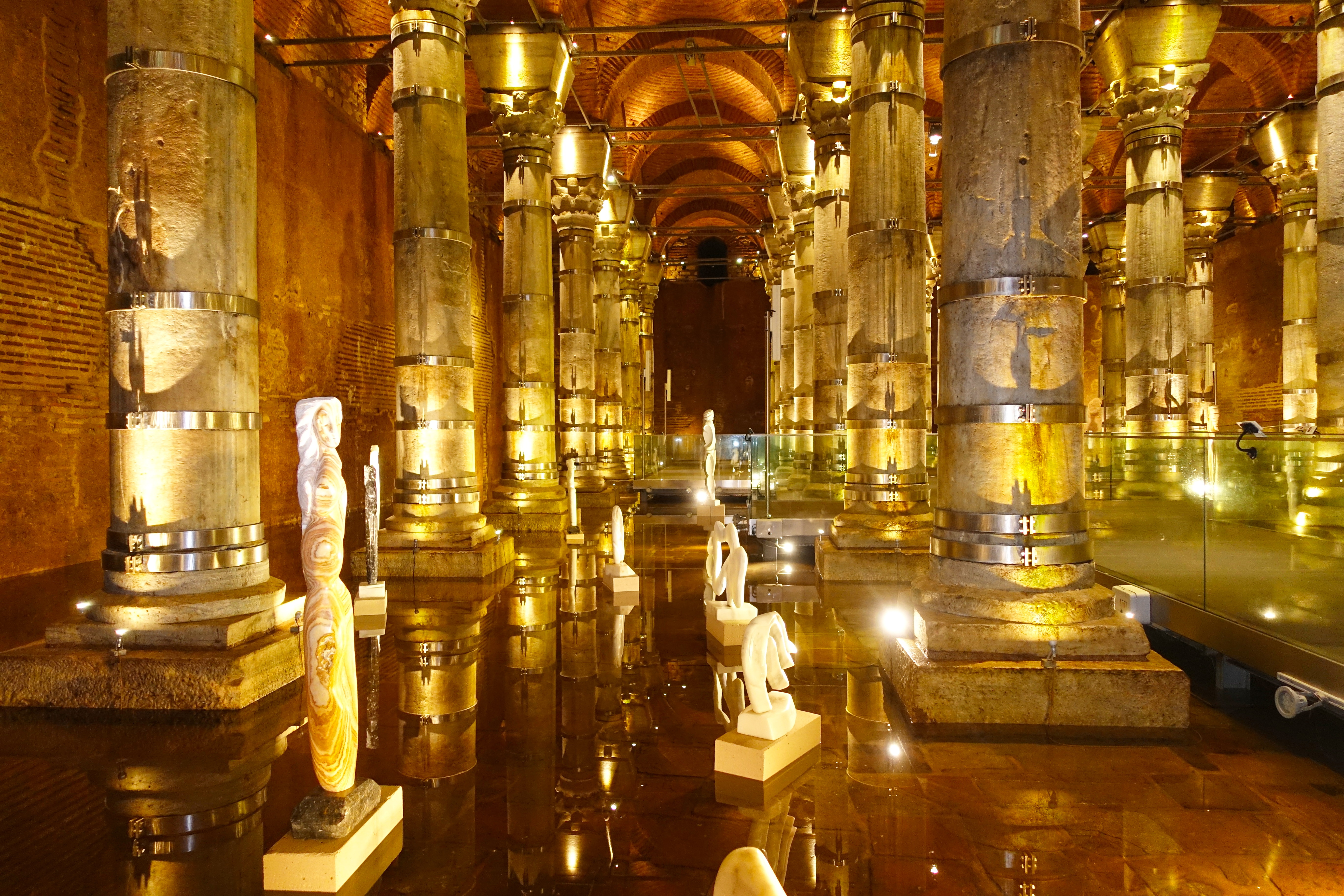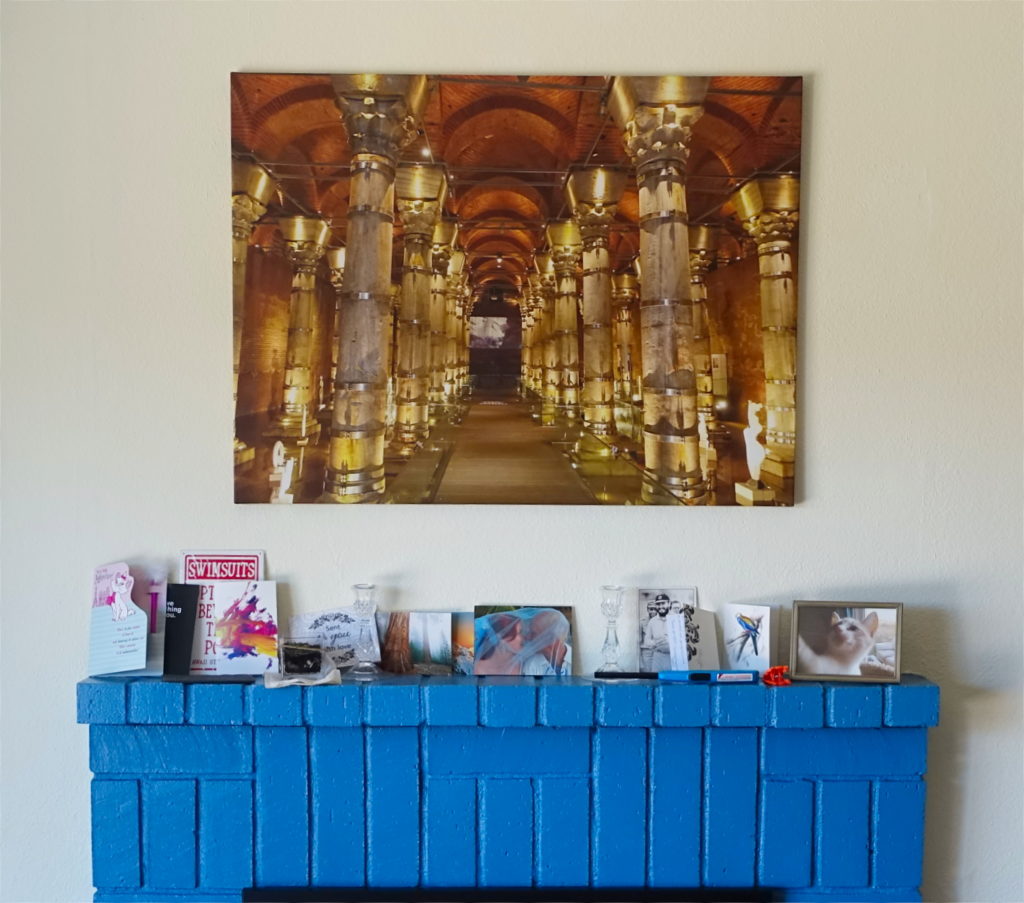The city of Istanbul, Turkey, is home to almost 3,000 Islamic mosques, 35 Christian churches, over 100 big cisterns, and 33 aqueducts. No, we can not visit all of them, but the ones we do visit are magnificent!
Blue Mosque
The Sultan Ahmet Camii, known as the Blue Mosque, is a functioning mosque and a major tourist attraction. Constructed in the early 1600s, it contains Sultan Ahmed’s tomb, a madrasah, and a hospice.
This panorama shows the mosque and the surrounding buildings. The mosque was built on the site of the palace of the Byzantine emperors, in front of the basilica Hagia Sophia (at that time, the primary imperial mosque in İstanbul) and the hippodrome, a site of significant symbolic meaning as it dominated the city skyline from the south. Big parts of the south shore of the mosque rest on the foundations, the vaults of the old Grand Palace.
The Sultan Ahmed Mosque is one of the two mosques in Turkey that has six minarets (one in the modern Sabancı Mosque in Adana, the Hz. Mikdat Mosque in Mersin, Çamlıca in Üsküdar and the Green mosque in Arnavutköy). According to folklore, an architect misheard the Sultan’s request for “altın minareler” (gold minarets) as “altı minare” (six minarets), at the time a unique feature of the mosque of the Ka’aba in Mecca. When criticized for his presumption, the Sultan then ordered a seventh minaret to be built at the Mecca mosque.
Four minarets stand at the corners of the Blue Mosque. Each of these fluted, pencil-shaped minarets has three balconies (called şerefe) with stalactite corbels, while the two others at the end of the forecourt only have two balconies. In earlier times, the muezzin (prayer caller) had to climb a narrow spiral staircase five times a day to announce the call to prayer.
Each stage has a balcony out onto which the muezzin can step to make his call. Many, but not all, minarets have small windows in them.
The mosque provides a helpful guide. There and not many rules, but “no smoking” is emphasized.
The internet informs us, “Please ignore and avoid people who offer you to enter mosque without queue up. Those people mostly will try to sell you something and take you to some shopping place.” We don’t know if this is such a fellow, or maybe a janitor, or perhaps the main imam himself. But he looks cool, so we take his photograph and continue on our way.
Women in this mosque have their own special area for praying. We don’t know what happens if they accidentally pray somewhere else. At any rate, don’t I look good in my borrowed scarf and skirt?
Shoes are not worn in mosques, which is good because it would ruin the silk carpet. The shoes are stored in the cubbyholes of the cabinet on the right. We take a moment for a silly photograph.
People are fairly casual in the Blue Mosque, using it more as a photo opportunity than as a chance to understand an ancient culture. Well, at least they are happy. Notice the design on the wall to the right…
The builders have graciously provided a plan of the ceiling, including a compass so that true believers know how to find Mecca. (Spoiler: It’s south by south-east.)
At its lower levels and at every pier, the interior of the mosque is lined with more than 20,000 handmade İznik style ceramic tiles, made at İznik (the ancient Nicaea) in more than fifty different tulip designs. The tiles at lower levels are traditional in design, while at gallery level their design becomes flamboyant with representations of flowers, fruit, and cypresses. The upper levels of the interior are dominated by blue paint. More than 200 stained glass windows with intricate designs admit natural light.
In contrast to Christian churches, mosques are well lighted and have no icons of deities. Since the faithful kneel during prayer, there is no need for chairs or structured assemblies.
Please enjoy this slideshow displaying the beauty of the Blue Mosque.
The area just outside the mosque has sections decorated in bright red stones. We wonder if it honors the color of the mosque’s carpet.
Hagia Sophia
“The mystical city İstanbul hosted many civilizations since centuries, of which Byzantium and Ottoman Empires were both the most famous ones. The city today carries the characteristics of these two different cultures and surely Hagia Sophia is a perfect synthesis where one can observe both Ottoman and Byzantium effects under one great dome.”
Ayasofya, aka Hagia Sophia (“Holy Wisdom”), is conveniently located near the Blue Mosque and shares the same festive grounds. It is a former Greek Orthodox Christian patriarchal cathedral, later an Ottoman Imperial mosque and now a museum (Ayasofya Müzesi). It is famous for its large dome. Built in AD 537, during the reign of Justinian, it was the world’s largest building and an engineering marvel of its time.
Hagia Sophia is of masonry construction. The structure has brick and mortar joints that are 1.5 times the width of the bricks. The mortar joints are composed of a combination of sand and minute ceramic pieces distributed evenly throughout the mortar joints.
Hagia Sophia has a very different feel than does the Blue Mosque. Even though it is a museum, a sign admonishes us, “In the historical history of Hagia Sophia considering that it has been used for 916 years as a church and 482 years as a mosque, remember that this museum is a sacred sanctuary and we remind you that within the museum should be behaved according to the historical identity of Hagia Sophia.”
“In plan, it is about 270 feet [82 meters] long and 240 feet [73 meters] wide. The dome is 108 feet [33 meters] in diameter and its crown rises some 180 feet [55 meters] above the pavement.”
Notice the large number of hanging lights. This place was probably pretty dark inside before electricity. Notice, too, the large signs (if that’s the right word) with Arabic writing.
This photograph gives an idea of the size of the sign. Whatever it says, it must be important. We can also see the degree of detail that went into every area of the church, even those places not easily seen or accessed.
A sign tells us that this is the Omphalion, the place of the coronation ceremony of the Eastern Roman Emperors. However…
“Historically, it was thought to mark the spot where Byzantine emperors were crowned during the coronation ceremony. Evidence of this comes from Antony of Novgorod, who wrote a description of Hagia Sophia in the early 13th century. He wrote “there is a red marble stone with a golden throne placed on it. On this throne the emperors were crowned”. This view has been challenged over the years because of the dearth of textual reference from writers and travelers in the Byzantine Era. Hagia Sophia herself has been altered so many times since the sixth-century that the Omphalion disappears and re-appears sporadically in the textual evidence that does exist. We know that it was covered over with carpets by the Ottomans after they converted it into a mosque. The design is unique to Hagia Sophia, with little in the way of direct comparisons.”
We cannot enter the library of Sultan Mahmud I, a bronze grilled room with a capacity of 5,000 books (although they don’t tell us how thick the books are). The library also houses a reading hall, because, I guess, a reading room was not large enough.
It is here we discover that Henricus Dandolo is buried in this museum. As you may recall, Mr. Dandolo was involved in the Fourth Crusade and the Sack of Constantinople.
The Crusaders looted, terrorized, and vandalized Constantinople for three days, during which many ancient and medieval Roman and Greek works were either stolen or destroyed. The famous bronze horses from the Hippodrome were sent back to adorn the façade of St Mark’s Basilica in Venice, where they remain. As well as being stolen, works of immeasurable artistic value were destroyed merely for their material value. One of the most precious works to suffer such a fate was a large bronze statue of Hercules, created by the legendary Lysippos, court sculptor of Alexander the Great. Like so many other priceless artworks made of bronze, the statue was melted down for its content by the Crusaders.
Despite their oaths and the threat of excommunication, the Crusaders systematically violated the city’s holy sanctuaries, destroying or stealing all they could lay hands on; nothing was spared, not even the tombs of the emperors inside the St Apostles church. The civilian population of Constantinople were subject to the Crusaders’ ruthless lust for spoils and glory; thousands of them were killed in cold blood. Women, including nuns, were raped by the Crusader army, which also sacked churches, monasteries and convents. The very altars of these churches were smashed and torn to pieces for their gold and marble by the warriors. Although the Venetians engaged in looting too, their actions were far more restrained. Doge Dandolo still appeared to have far more control over his men. Rather than wantonly destroying all around like their comrades, the Venetians stole religious relics and works of art, which they would later take to Venice to adorn their own churches.
It was said that the total amount looted from Constantinople was about 900,000 silver marks. The Venetians received 150,000 silver marks that was their due and the Crusaders received 50,000 silver marks. A further 100,000 silver marks were divided evenly between the Crusaders and Venetians. The remaining 500,000 silver marks were secretly kept back by many Crusader knights. Meanwhile, Latin residents of Constantinople exacted their own retribution for the Massacre of the Latins of 1182.
Good times…
Climbing to the top floor, we are able to take a photograph across the roof of the museum and include the Blue Mosque in the background.
We include a few more photographs of Hagia Sophia.
Little Hagia Sophia
Close to our house in Fatih is Küçük Ayasofya Camii, a.k.a. Little Hagia Sophia. “This Byzantine building with a central dome plan was erected in the sixth century by Justinian; despite its Turkish name, it likely was not a model for Hagia Sophia, with which its construction was contemporary, but it is nonetheless one of the most important early Byzantine buildings in İstanbul.”
The original church was built between 527 and 536 CE to service the palace of Pope Hormisdas, and was originally named after two Roman soldiers, Sergius and Bacchus. They were martyred for their faith and later became the patron saints of Christians in the Roman army. Little Hagia Sophia was commissioned by Justinian shortly before the erection of Hagia Sophia and believed to have been designed by the same architects.
The folks who run the mosques are very accommodating, and provide a handy set of rules. Funny that it’s in English and not German, Spanish, or French.
The inside is cool and quiet, and we take a moment of enjoy the beauty.
According to a marker outside the mosque, “The church has an octagonal main dome. The edges of the octagon laced within an-almost-square rectangle are respectively composed of arches and half-domes. There is no fresco or mosaic in the church. On the other hand, it is ornamented with pink and green porphyritic columns and marble plates.”
Please enjoy this slideshow featuring more of Little Hagia Sophia.
Şehzade Mosque
The Şehzade Mosque (Turkish: Şehzade Camii, from the original Persian شاهزاده Šāhzādeh, meaning “prince”) is a 16th-century Ottoman imperial mosque located in the district of Fatih, on the third hill of İstanbul. It was commissioned by Suleiman the Magnificent as a memorial to his son Şehzade Mehmed who died in 1543.
Şehzade complex consists of the mosque, the mausoleum of Prince Mehmet (which was completed prior to the mosque), two Qur’an schools, a public kitchen which served food to the poor, and a caravansarai. The mosque and its courtyard are surrounded by a wall that separates them from the rest of the complex.
While we are in İstanbul, we hear the adhan five times daily. The sound comes from multiple mosques, bounces off buildings, echos and re-echos, and just sounds terrible. Well, while we are visiting this mosque, we see muezzin enter a small room and begin singing the Adhan into a microphone and, indeed, it is a beautiful, melodic song. Before electronic amplification, we imagine the sounds of multiple muezzins reciting the adhan throughout the city was magical.
As with many places of prayer in İstanbul, there is a place to wash before entering. Notice the dearth of women; I suppose that, because women are naturally perfect, there is little need for them to beseech the gods.
There is a comfort found in mosques that is not duplicated in Jewish temples or Christian churches. Each person finds his own connection in his own way.
Please take a moment to enjoy more photographs of Şehzade mosque.
Beylerbeyi Palace
We climb on a tour bus and travel over the Bosphorus, from Europe to Asia, specifically to see Beylerbeyi Palace.
Beylerbeyi Palace, (Turkish: Beylerbeyi Sarayı, Beylerbeyi meaning “Lord of Lords”), summer residence of the sultans, is located at Beylerbeyi neighborhood on the Asian shore of the Bosphorus. It was commissioned by Sultan Abdulaziz and built between 1861-1865 in French neo-baroque style with a traditional Ottoman house plan. Important foreign guests visiting the Ottoman Empire were accommodated in this palace during the summer months; Prince of Serbia, King Nicholas of Montenegro, Emperor Joseph of Austro-Hungary, Shah Nasireddin of Iran, Prince Oscar of Sweden, and Empress Eugenie of France were some of them. Sultan Abdulhamid II spent the last 6 years of his life and died here in 1918, meanwhile other sultans ruled in the Dolmabahce Palace during winter months and came here only for the summer for a nice climate.
There is a massive door to the grounds. However, the walls themselves are much smaller. Kinda ruins the effect, but what do I know?
The grounds are spacious and the buildings are indeed stately. Unfortunately, they do not allow photographs inside, for reasons. However, if you go inside, you’ll see palatial living quarters fit for a king. Or sultan.
The palace has two bathing pavilions, one for the harem (women only) and the other for the selamlik (men only). From the street above, we take this photograph, but we don’t know if this is one of those pools. At any rate, it’s nicer than anything we have in our backyard. ?
This gives a better idea of the splendor of the palace. Ignore the encroaching suburbia and the Bosphorus bridge, and imagine instead a sprawling estate where you spend your summers cooled by the waters at your doorstep.
Aqueduct of Valens
The Aqueduct of Valens (Turkish: Valens Su Kemeri) stretched across the valley east of the Church of the Holy Apostles between the Fourth and Third Hills of Constantinople.
The final and most visible aqueduct bridge in the system survives in the Fatih district, named in Turkish Bozdoğan Kemeri (Aqueduct of the Grey Falcon). The Bozdoğan Kemeri remains one of the most important landmarks of the city and Atatürk Bulvarı passes under its arches.
The picture on this placard shows the aqueduct in relation to the boulevard. Notice how they widened the street to preserve this historical monument.
Although the structure is almost 2,000 years old, it still impresses with the precision and skilled craftsmanship. You have to remember that there were piles of uneven stones that were stacked and mortared into place, and the result had to be perfect.
A close-up reveals the method used to ensure the stones were at the correct height and how the arch was created.
On one side of the aqueduct is a road, part of which has been turned into a small cafe where, apparently, only men can dine.
On the other side of the aqueduct is Fatih AnIt ParkI, which displays a statute of Fatih Sultan Mehmet II riding on a galloping horse. A placard nearby tells us İstanbul Halkına Armağanıdır.
Şerefiye Cistern
Şerefiye Cistern was built by Roman Emperor Theodosius II between 428 and 443 to store water supplied by the Aqueduct of Valens. The Aqueduct of Valens was redistributed by Theodosius from its original supply to the Nymphaeum, the Baths of Zeuxippus and the Great Palace of Constantinople. This redistribution led to the construction of the Şerefiye Cistern.
According to a plaque outside the cistern, “in 2010, Eminonu Town Hall was demolished by İstanbul Metropolitan Municipality and previously quite unknown cistern which was hidden beneath the building was revealed without doing any harm to the historical monument.” So, they forgot it was here. 🙄
We enter the cistern through a doorway and descend a long flight of stairs. It is cool and quiet in here, quite a change from the streets of İstanbul. “The area is about 45 by 25 meters and the roof is supported by 32 marble columns about 9 meters high.”
There are only a few people here, and they soon leave. We wander the walkways, enchanted. Notice the white shapes along the edges.
We are fortunate to be here during a showing by Dinçer Güngörür called Taşın Perileri. “The Stone Fairies Sculpture Exhibition, which includes works that have gained identity with the work of Dinçer Güngörür, consists of figurative sculptures placed in the waters of the Cistern, the eyes are closed to the blessings of the world, and they are lonely because they are unable to reunite with their dedication to their love. The sculptures, which are in a calm as if they were stripped of everything else in the cistern, are waiting for their visitors in the serenity of the Şerefiye Cistern, like a knuckle waiting for his lover.” What? Gotta love Google Translate. 😐
Enjoy a slideshow of this magical place.
How much did we enjoy Şerefiye Cistern? Enough that we have a picture of it above our fireplace!
There are many, many more monuments in İstanbul, and we hope we’ve given you a flavor of the wonders this place has to offer. Stay tuned as our adventures in Turkey continue!!

